What Is Sustainable Tourism and Why Is It Important?
Sustainable management and socioeconomic, cultural, and environmental impacts are the four pillars of sustainable tourism
- Chapman University
:max_bytes(150000):strip_icc():format(webp)/HaleyMast-2035b42e12d14d4abd433e014e63276c.jpg)
- Harvard University Extension School
- Sustainable Fashion
- Art & Media

What Makes Tourism Sustainable?
The role of tourists, types of sustainable tourism.
Sustainable tourism considers its current and future economic, social, and environmental impacts by addressing the needs of its ecological surroundings and the local communities. This is achieved by protecting natural environments and wildlife when developing and managing tourism activities, providing only authentic experiences for tourists that don’t appropriate or misrepresent local heritage and culture, or creating direct socioeconomic benefits for local communities through training and employment.
As people begin to pay more attention to sustainability and the direct and indirect effects of their actions, travel destinations and organizations are following suit. For example, the New Zealand Tourism Sustainability Commitment is aiming to see every New Zealand tourism business committed to sustainability by 2025, while the island country of Palau has required visitors to sign an eco pledge upon entry since 2017.
Tourism industries are considered successfully sustainable when they can meet the needs of travelers while having a low impact on natural resources and generating long-term employment for locals. By creating positive experiences for local people, travelers, and the industry itself, properly managed sustainable tourism can meet the needs of the present without compromising the future.
What Is Sustainability?
At its core, sustainability focuses on balance — maintaining our environmental, social, and economic benefits without using up the resources that future generations will need to thrive. In the past, sustainability ideals tended to lean towards business, though more modern definitions of sustainability highlight finding ways to avoid depleting natural resources in order to keep an ecological balance and maintain the quality of environmental and human societies.
Since tourism impacts and is impacted by a wide range of different activities and industries, all sectors and stakeholders (tourists, governments, host communities, tourism businesses) need to collaborate on sustainable tourism in order for it to be successful.
The World Tourism Organization (UNWTO) , which is the United Nations agency responsible for the promotion of sustainable tourism, and the Global Sustainable Tourism Council (GSTC) , the global standard for sustainable travel and tourism, have similar opinions on what makes tourism sustainable. By their account, sustainable tourism should make the best use of environmental resources while helping to conserve natural heritage and biodiversity, respect the socio-culture of local host communities, and contribute to intercultural understanding. Economically, it should also ensure viable long-term operations that will provide benefits to all stakeholders, whether that includes stable employment to locals, social services, or contributions to poverty alleviation.
The GSTC has developed a series of criteria to create a common language about sustainable travel and tourism. These criteria are used to distinguish sustainable destinations and organizations, but can also help create sustainable policies for businesses and government agencies. Arranged in four pillars, the global baseline standards include sustainable management, socioeconomic impact, cultural impacts, and environmental impacts.
Travel Tip:
The GSTC is an excellent resource for travelers who want to find sustainably managed destinations and accommodations and learn how to become a more sustainable traveler in general.
Environment
Protecting natural environments is the bedrock of sustainable tourism. Data released by the World Tourism Organization estimates that tourism-based CO2 emissions are forecast to increase 25% by 2030. In 2016, tourism transport-related emissions contributed to 5% of all man-made emissions, while transport-related emissions from long-haul international travel were expected to grow 45% by 2030.
The environmental ramifications of tourism don’t end with carbon emissions, either. Unsustainably managed tourism can create waste problems, lead to land loss or soil erosion, increase natural habitat loss, and put pressure on endangered species . More often than not, the resources in these places are already scarce, and sadly, the negative effects can contribute to the destruction of the very environment on which the industry depends.
Industries and destinations that want to be sustainable must do their part to conserve resources, reduce pollution, and conserve biodiversity and important ecosystems. In order to achieve this, proper resource management and management of waste and emissions is important. In Bali, for example, tourism consumes 65% of local water resources, while in Zanzibar, tourists use 15 times as much water per night as local residents.
Another factor to environmentally focused sustainable tourism comes in the form of purchasing: Does the tour operator, hotel, or restaurant favor locally sourced suppliers and products? How do they manage their food waste and dispose of goods? Something as simple as offering paper straws instead of plastic ones can make a huge dent in an organization’s harmful pollutant footprint.
Recently, there has been an uptick in companies that promote carbon offsetting . The idea behind carbon offsetting is to compensate for generated greenhouse gas emissions by canceling out emissions somewhere else. Much like the idea that reducing or reusing should be considered first before recycling , carbon offsetting shouldn’t be the primary goal. Sustainable tourism industries always work towards reducing emissions first and offset what they can’t.
Properly managed sustainable tourism also has the power to provide alternatives to need-based professions and behaviors like poaching . Often, and especially in underdeveloped countries, residents turn to environmentally harmful practices due to poverty and other social issues. At Periyar Tiger Reserve in India, for example, an unregulated increase in tourists made it more difficult to control poaching in the area. In response, an eco development program aimed at providing employment for locals turned 85 former poachers into reserve gamekeepers. Under supervision of the reserve’s management staff, the group of gamekeepers have developed a series of tourism packages and are now protecting land instead of exploiting it. They’ve found that jobs in responsible wildlife tourism are more rewarding and lucrative than illegal work.
Flying nonstop and spending more time in a single destination can help save CO2, since planes use more fuel the more times they take off.
Local Culture and Residents
One of the most important and overlooked aspects of sustainable tourism is contributing to protecting, preserving, and enhancing local sites and traditions. These include areas of historical, archaeological, or cultural significance, but also "intangible heritage," such as ceremonial dance or traditional art techniques.
In cases where a site is being used as a tourist attraction, it is important that the tourism doesn’t impede access to local residents. For example, some tourist organizations create local programs that offer residents the chance to visit tourism sites with cultural value in their own countries. A program called “Children in the Wilderness” run by Wilderness Safaris educates children in rural Africa about the importance of wildlife conservation and valuable leadership development tools. Vacations booked through travel site Responsible Travel contribute to the company’s “Trip for a Trip” program, which organizes day trips for disadvantaged youth who live near popular tourist destinations but have never had the opportunity to visit.
Sustainable tourism bodies work alongside communities to incorporate various local cultural expressions as part of a traveler’s experiences and ensure that they are appropriately represented. They collaborate with locals and seek their input on culturally appropriate interpretation of sites, and train guides to give visitors a valuable (and correct) impression of the site. The key is to inspire travelers to want to protect the area because they understand its significance.
Bhutan, a small landlocked country in South Asia, has enforced a system of all-inclusive tax for international visitors since 1997 ($200 per day in the off season and $250 per day in the high season). This way, the government is able to restrict the tourism market to local entrepreneurs exclusively and restrict tourism to specific regions, ensuring that the country’s most precious natural resources won’t be exploited.
Incorporating volunteer work into your vacation is an amazing way to learn more about the local culture and help contribute to your host community at the same time. You can also book a trip that is focused primarily on volunteer work through a locally run charity or non profit (just be sure that the job isn’t taking employment opportunities away from residents).
It's not difficult to make a business case for sustainable tourism, especially if one looks at a destination as a product. Think of protecting a destination, cultural landmark, or ecosystem as an investment. By keeping the environment healthy and the locals happy, sustainable tourism will maximize the efficiency of business resources. This is especially true in places where locals are more likely to voice their concerns if they feel like the industry is treating visitors better than residents.
Not only does reducing reliance on natural resources help save money in the long run, studies have shown that modern travelers are likely to participate in environmentally friendly tourism. In 2019, Booking.com found that 73% of travelers preferred an eco-sustainable hotel over a traditional one and 72% of travelers believed that people need to make sustainable travel choices for the sake of future generations.
Always be mindful of where your souvenirs are coming from and whether or not the money is going directly towards the local economy. For example, opt for handcrafted souvenirs made by local artisans.
Growth in the travel and tourism sectors alone has outpaced the overall global economy growth for nine years in a row. Prior to the pandemic, travel and tourism accounted for an $9.6 trillion contribution to the global GDP and 333 million jobs (or one in four new jobs around the world).
Sustainable travel dollars help support employees, who in turn pay taxes that contribute to their local economy. If those employees are not paid a fair wage or aren’t treated fairly, the traveler is unknowingly supporting damaging or unsustainable practices that do nothing to contribute to the future of the community. Similarly, if a hotel doesn’t take into account its ecological footprint, it may be building infrastructure on animal nesting grounds or contributing to excessive pollution. The same goes for attractions, since sustainably managed spots (like nature preserves) often put profits towards conservation and research.
Costa Rica was able to turn a severe deforestation crisis in the 1980s into a diversified tourism-based economy by designating 25.56% of land protected as either a national park, wildlife refuge, or reserve.
While traveling, think of how you would want your home country or home town to be treated by visitors.
Are You a Sustainable Traveler?
Sustainable travelers understand that their actions create an ecological and social footprint on the places they visit. Be mindful of the destinations , accommodations, and activities you choose, and choose destinations that are closer to home or extend your length of stay to save resources. Consider switching to more environmentally friendly modes of transportation such as bicycles, trains, or walking while on vacation. Look into supporting locally run tour operations or local family-owned businesses rather than large international chains. Don’t engage in activities that harm wildlife, such as elephant riding or tiger petting , and opt instead for a wildlife sanctuary (or better yet, attend a beach clean up or plan an hour or two of some volunteer work that interests you). Leave natural areas as you found them by taking out what you carry in, not littering, and respecting the local residents and their traditions.
Most of us travel to experience the world. New cultures, new traditions, new sights and smells and tastes are what makes traveling so rewarding. It is our responsibility as travelers to ensure that these destinations are protected not only for the sake of the communities who rely upon them, but for a future generation of travelers.
Sustainable tourism has many different layers, most of which oppose the more traditional forms of mass tourism that are more likely to lead to environmental damage, loss of culture, pollution, negative economic impacts, and overtourism.
Ecotourism highlights responsible travel to natural areas that focus on environmental conservation. A sustainable tourism body supports and contributes to biodiversity conservation by managing its own property responsibly and respecting or enhancing nearby natural protected areas (or areas of high biological value). Most of the time, this looks like a financial compensation to conservation management, but it can also include making sure that tours, attractions, and infrastructure don’t disturb natural ecosystems.
On the same page, wildlife interactions with free roaming wildlife should be non-invasive and managed responsibly to avoid negative impacts to the animals. As a traveler, prioritize visits to accredited rescue and rehabilitation centers that focus on treating, rehoming, or releasing animals back into the wild, such as the Jaguar Rescue Center in Costa Rica.
Soft Tourism
Soft tourism may highlight local experiences, local languages, or encourage longer time spent in individual areas. This is opposed to hard tourism featuring short duration of visits, travel without respecting culture, taking lots of selfies , and generally feeling a sense of superiority as a tourist.
Many World Heritage Sites, for example, pay special attention to protection, preservation, and sustainability by promoting soft tourism. Peru’s famed Machu Picchu was previously known as one of the world’s worst victims of overtourism , or a place of interest that has experienced negative effects (such as traffic or litter) from excessive numbers of tourists. The attraction has taken steps to control damages in recent years, requiring hikers to hire local guides on the Inca Trail, specifying dates and time on visitor tickets to negate overcrowding, and banning all single use plastics from the site.
Traveling during a destination’s shoulder season , the period between the peak and low seasons, typically combines good weather and low prices without the large crowds. This allows better opportunities to immerse yourself in a new place without contributing to overtourism, but also provides the local economy with income during a normally slow season.
Rural Tourism
Rural tourism applies to tourism that takes place in non-urbanized areas such as national parks, forests, nature reserves, and mountain areas. This can mean anything from camping and glamping to hiking and WOOFing. Rural tourism is a great way to practice sustainable tourism, since it usually requires less use of natural resources.
Community Tourism
Community-based tourism involves tourism where local residents invite travelers to visit their own communities. It sometimes includes overnight stays and often takes place in rural or underdeveloped countries. This type of tourism fosters connection and enables tourists to gain an in-depth knowledge of local habitats, wildlife, and traditional cultures — all while providing direct economic benefits to the host communities. Ecuador is a world leader in community tourism, offering unique accommodation options like the Sani Lodge run by the local Kichwa indigenous community, which offers responsible cultural experiences in the Ecuadorian Amazon rainforest.
" Transport-related CO 2 Emissions of the Tourism Sector – Modelling Results ." World Tourism Organization and International Transport Forum , 2019, doi:10.18111/9789284416660
" 45 Arrivals Every Second ." The World Counts.
Becken, Susanne. " Water Equity- Contrasting Tourism Water Use With That of the Local Community ." Water Resources and Industry , vol. 7-8, 2014, pp. 9-22, doi:10.1016/j.wri.2014.09.002
Kutty, Govindan M., and T.K. Raghavan Nair. " Periyar Tiger Reserve: Poachers Turned Gamekeepers ." Food and Agriculture Organization.
" GSTC Destination Criteria ." Global Sustainable Tourism Council.
Rinzin, Chhewang, et al. " Ecotourism as a Mechanism for Sustainable Development: the Case of Bhutan ." Environmental Sciences , vol. 4, no. 2, 2007, pp. 109-125, doi:10.1080/15693430701365420
" Booking.com Reveals Key Findings From Its 2019 Sustainable Travel Report ." Booking.com.
" Economic Impact Reports ." World Travel and Tourism Council .
- Regenerative Travel: What It Is and How It's Outperforming Sustainable Tourism
- How to Be a Sustainable Traveler: 18 Tips
- What Is Ecotourism? Definition, Examples, and Pros and Cons
- Some Advice on How to Travel More Intentionally
- 'The Last Tourist' Film Will Make You Approach Travel Differently
- Best of Green Awards 2021: Sustainable Travel
- Costa Rica’s Keys to Success as a Sustainable Tourism Pioneer
- What Is Community-Based Tourism? Definition and Popular Destinations
- What Is Overtourism and Why Is It Such a Big Problem?
- What Is Experiential Tourism?
- What Is Voluntourism? Does It Help or Harm Communities?
- Food Sovereignty: Definition, Principles, and Importance
- Best of Green Awards 2021: Eco Tech
- 10 Ways to Be an Eco-Conscious Tourist
- Travel + Leisure's Global Vision Awards Are a Win for the Planet
- Spain Starts a School for Shepherdesses
Sustainable tourism
Related sdgs, promote sustained, inclusive and sustainable ....

Description
Publications.
Tourism is one of the world's fastest growing industries and an important source of foreign exchange and employment, while being closely linked to the social, economic, and environmental well-being of many countries, especially developing countries. Maritime or ocean-related tourism, as well as coastal tourism, are for example vital sectors of the economy in small island developing States (SIDS) and coastal least developed countries (LDCs) (see also: The Potential of the Blue Economy report as well as the Community of Ocean Action on sustainable blue economy).
The World Tourism Organization defines sustainable tourism as “tourism that takes full account of its current and future economic, social and environmental impacts, addressing the needs of visitors, the industry, the environment and host communities".
Based on General assembly resolution 70/193, 2017 was declared as the International Year of Sustainable Tourism for Development.
In the 2030 Agenda for Sustainable Development SDG target 8.9, aims to “by 2030, devise and implement policies to promote sustainable tourism that creates jobs and promotes local culture and products”. The importance of sustainable tourism is also highlighted in SDG target 12.b. which aims to “develop and implement tools to monitor sustainable development impacts for sustainable tourism that creates jobs and promotes local culture and products”.
Tourism is also identified as one of the tools to “by 2030, increase the economic benefits to Small Island developing States and least developed countries” as comprised in SDG target 14.7.
In the Rio+20 outcome document The Future We want, sustainable tourism is defined by paragraph 130 as a significant contributor “to the three dimensions of sustainable development” thanks to its close linkages to other sectors and its ability to create decent jobs and generate trade opportunities. Therefore, Member States recognize “the need to support sustainable tourism activities and relevant capacity-building that promote environmental awareness, conserve and protect the environment, respect wildlife, flora, biodiversity, ecosystems and cultural diversity, and improve the welfare and livelihoods of local communities by supporting their local economies and the human and natural environment as a whole. ” In paragraph 130, Member States also “call for enhanced support for sustainable tourism activities and relevant capacity-building in developing countries in order to contribute to the achievement of sustainable development”.
In paragraph 131, Member States “encourage the promotion of investment in sustainable tourism, including eco-tourism and cultural tourism, which may include creating small- and medium-sized enterprises and facilitating access to finance, including through microcredit initiatives for the poor, indigenous peoples and local communities in areas with high eco-tourism potential”. In this regard, Member States also “underline the importance of establishing, where necessary, appropriate guidelines and regulations in accordance with national priorities and legislation for promoting and supporting sustainable tourism”.
In 2002, the World Summit on Sustainable Development in Johannesburg called for the promotion of sustainable tourism development, including non-consumptive and eco-tourism, in Chapter IV, paragraph 43 of the Johannesburg Plan of Implementation.
At the Johannesburg Summit, the launch of the “Sustainable Tourism – Eliminating Poverty (ST-EP) initiative was announced. The initiative was inaugurated by the World Tourism Organization, in collaboration with UNCTAD, in order to develop sustainable tourism as a force for poverty alleviation.
The UN Commission on Sustainable Development (CSD) last reviewed the issue of sustainable tourism in 2001, when it was acting as the Preparatory Committee for the Johannesburg Summit.
The importance of sustainable tourism was also mentioned in Agenda 21.
For more information and documents on this topic, please visit this link
UNWTO Annual Report 2015
2015 was a landmark year for the global community. In September, the 70th Session of the United Nations General Assembly adopted the Sustainable Development Goals (SDGs), a universal agenda for planet and people. Among the 17 SDGs and 169 associated targets, tourism is explicitly featured in Goa...
UNWTO Annual Report 2016
In December 2015, the United Nations General Assembly declared 2017 as the International Year of Sustainable Tourism for Development. This is a unique opportunity to devote a year to activities that promote the transformational power of tourism to help us reach a better future. This important cele...
Emerging Issues for Small Island Developing States
The 2012 UNEP Foresight Process on Emerging Global Environmental Issues primarily identified emerging environmental issues and possible solutions on a global scale and perspective. In 2013, UNEP carried out a similar exercise to identify priority emerging environmental issues that are of concern to ...
Transforming our World: The 2030 Agenda for Sustainable Development
This Agenda is a plan of action for people, planet and prosperity. It also seeks to strengthen universal peace in larger freedom, We recognize that eradicating poverty in all its forms and dimensions, including extreme poverty, is the greatest global challenge and an indispensable requirement for su...
15 Years of the UNWTO World Tourism Network on Child Protection: A Compilation of Good Practices
Although it is widely recognized that tourism is not the cause of child exploitation, it can aggravate the problem when parts of its infrastructure, such as transport networks and accommodation facilities, are exploited by child abusers for nefarious ends. Additionally, many other factors that contr...
Towards Measuring the Economic Value of Wildlife Watching Tourism in Africa
Set against the backdrop of the ongoing poaching crisis driven by a dramatic increase in the illicit trade in wildlife products, this briefing paper intends to support the ongoing efforts of African governments and the broader international community in the fight against poaching. Specifically, this...
Status and Trends of Caribbean Coral Reefs: 1970-2012
Previous Caribbean assessments lumped data together into a single database regardless of geographic location, reef environment, depth, oceanographic conditions, etc. Data from shallow lagoons and back reef environments were combined with data from deep fore-reef environments and atolls. Geographic c...
Natural Resources Forum: Special Issue Tourism
The journal considers papers on all topics relevant to sustainable development. In addition, it dedicates series, issues and special sections to specific themes that are relevant to the current discussions of the United Nations Commission on Sustainable Development (CSD)....
Thailand: Supporting Sustainable Development in Thailand: A Geographic Clusters Approach
Market forces and government policies, including the Tenth National Development Plan (2007-2012), are moving Thailand toward a more geographically specialized economy. There is a growing consensus that Thailand’s comparative and competitive advantages lie in amenity services that have high reliance...
Road Map on Building a Green Economy for Sustainable Development in Carriacou and Petite Martinique, Grenada
This publication is the product of an international study led by the Division for Sustainable Development (DSD) of the United Nations Department of Economic and Social Affairs (UNDESA) in cooperation with the Ministry of Carriacou and Petite Martinique Affairs and the Ministry of Environment, Foreig...
Natural Resources Forum, a United Nations Sustainable Development Journal (NRF)
Natural Resources Forum, a United Nations Sustainable Development Journal, seeks to address gaps in current knowledge and stimulate relevant policy discussions, leading to the implementation of the sustainable development agenda and the achievement of the Sustainable...
UN Ocean Conference 2025
Our Ocean, Our Future, Our Responsibility “The ocean is fundamental to life on our planet and to our future. The ocean is an important source of the planet’s biodiversity and plays a vital role in the climate system and water cycle. The ocean provides a range of ecosystem services, supplies us with
UN Ocean Conference 2022
The UN Ocean Conference 2022, co-hosted by the Governments of Kenya and Portugal, came at a critical time as the world was strengthening its efforts to mobilize, create and drive solutions to realize the 17 Sustainable Development Goals by 2030.
58th Session of the Commission for Social Development – CSocD58
22nd general assembly of the united nations world tourism organization, world tourism day 2017 official celebration.
This year’s World Tourism Day, held on 27 September, will be focused on Sustainable Tourism – a Tool for Development. Celebrated in line with the 2017 International Year of Sustainable Tourism for Development, the Day will be dedicated to exploring the contribution of tourism to the Sustainable Deve
World Tourism Day 2016 Official Celebration
Accessible Tourism for all is about the creation of environments that can cater for the needs of all of us, whether we are traveling or staying at home. May that be due to a disability, even temporary, families with small children, or the ageing population, at some point in our lives, sooner or late
4th Global Summit on City Tourism
The World Tourism Organisation (UNWTO) and the Regional Council for Tourism of Marrakesh with support of the Government of Morroco are organizing the 4th Global Summit on City Tourism in Marrakesh, Morroco (9-10 December 2015). International experts in city tourism, representatives of city DMOs, of
2nd Euro-Asian Mountain Resorts Conference
The World Tourism Organisation (UNWTO) and Ulsan Metropolitan City with support of the Government of the Republic of Korea are organizing the 2nd Euro-Asian Mountain Resorts Conference, in Ulsan, Republic of Korea (14 - 16 October 2015). Under the title “Paving the Way for a Bright Future for Mounta
21st General Assembly of the United Nations World Tourism Organization
Unwto regional conference enhancing brand africa - fostering tourism development.
Tourism is one of the Africa’s most promising sectors in terms of development, and represents a major opportunity to foster inclusive development, increase the region’s participation in the global economy and generate revenues for investment in other activities, including environmental preservation.
- January 2017 International Year of Tourism In the context of the universal 2030 Agenda for Sustainable Development and the Sustainable Development Goals (SDGs), the International Year aims to support a change in policies, business practices and consumer behavior towards a more sustainable tourism sector that can contribute to the SDGs.
- January 2015 Targets 8.9, 12 b,14.7 The 2030 Agenda for Sustainable Development commits Member States, through Sustainable Development Goal Target 8.9 to “devise and implement policies to promote sustainable tourism that creates jobs and promotes local culture and products”. The importance of sustainable tourism, as a driver for jobs creation and the promotion of local culture and products, is also highlighted in Sustainable Development Goal target 12.b. Tourism is also identified as one of the tools to “increase [by 2030] the economic benefits to Small Island developing States and least developed countries”, through Sustainable Development Goals Target 14.7.
- January 2012 Future We Want (Para 130-131) Sustainable tourism is defined as a significant contributor “to the three dimensions of sustainable development” thanks to its close linkages to other sectors and its ability to create decent jobs and generate trade opportunities. Therefore, Member States recognize “the need to support sustainable tourism activities and relevant capacity-building that promote environmental awareness, conserve and protect the environment, respect wildlife, flora, biodiversity, ecosystems and cultural diversity, and improve the welfare and livelihoods of local communities” as well as to “encourage the promotion of investment in sustainable tourism, including eco-tourism and cultural tourism, which may include creating small and medium sized enterprises and facilitating access to finance, including through microcredit initiatives for the poor, indigenous peoples and local communities in areas with high eco-tourism potential”.
- January 2009 Roadmap for Recovery UNWTO announced in March 2009 the elaboration of a Roadmap for Recovery to be finalized by UNWTO’s General Assembly, based on seven action points. The Roadmap includes a set of 15 recommendations based on three interlocking action areas: resilience, stimulus, green economy aimed at supporting the tourism sector and the global economy.
- January 2008 Global Sustainable Tourism Criteria The Global Sustainable Tourism Criteria represent the minimum requirements any tourism business should observe in order to ensure preservation and respect of the natural and cultural resources and make sure at the same time that tourism potential as tool for poverty alleviation is enforced. The Criteria are 41 and distributed into four different categories: 1) sustainability management, 2) social and economic 3) cultural 4) environmental.
- January 2003 WTO becomes a UN specialized body By Resolution 453 (XV), the Assembly agreed on the transformation of the WTO into a United Nations specialized body. Such transformation was later ratified by the United Nations General Assembly with the adoption of Resolution A/RES/58/232.
- January 2003 1st Int. Conf. on Climate Change and Tourism The conference was organized in order to gather tourism authorities, organizations, businesses and scientists to discuss on the impact that climate change can have on the tourist sector. The event took place from 9 till 11 April 2003 in Djerba, Tunisia.
- January 2002 World Ecotourism Summit Held in May 2002, in Quebec City, Canada, the Summit represented the most important event in the framework of the International Year of Ecosystem. The Summit identified as main themes: ecotourism policy and planning, regulation of ecotourism, product development, marketing and promotion of ecotourism and monitoring costs and benefits of ecotourism.
- January 1985 Tourism Bill of Rights and Tourist Code At the World Tourism Organization Sixth Assembly held in Sofia in 1985, the Tourism Bill of Rights and Tourist Code were adopted, setting out the rights and duties of tourists and host populations and formulating policies and action for implementation by states and the tourist industry.
- January 1982 Acapulco Document Adopted in 1982, the Acapulco Document acknowledges the new dimension and role of tourism as a positive instrument towards the improvement of the quality of life for all peoples, as well as a significant force for peace and international understanding. The Acapulco Document also urges Member States to elaborate their policies, plans and programmes on tourism, in accordance with their national priorities and within the framework of the programme of work of the World Tourism Organization.
National Geographic content straight to your inbox—sign up for our popular newsletters here

Coral reforestation helps restore desolated reefs around Landaa Giraavaru Island on Baa Atoll in the Republic of Maldives.
For travelers, sustainability is the word—but there are many definitions of it
Most people want to support sustainable tourism, even though the concept remains fuzzy.
The word “overtourism” is a relatively new term—but its novelty has not diminished the portent of its meaning: “An excessive number of tourist visits to a popular destination or attraction, resulting in damage to the local environment and historical sites and in poorer quality of life for residents,” according to the Oxford Dictionary .
As travel recovers from pandemic lows, travelers are once again experiencing the consequences of overtourism at enticing, but crowded, destinations. The UN World Tourism Organization, along with public and private sector partners, marks September 27 as World Tourism Day and uses this platform to discuss tourism’s social, political, economic, and environmental impacts.
This day highlights the importance of sustainable tourism —a framework for engaging travelers and the travel industry at large in supporting goals that include protecting the environment, addressing climate change, minimizing plastic consumption , and expanding economic development in communities affected by tourism.
Getting the facts
A National Geographic survey of 3,500 adults in the U.S. reveals strong support for sustainability. That’s the good news—but the challenge will be helping travelers take meaningful actions. According to the survey—which was conducted in 2019—while 42 percent of U.S. travelers would be willing to prioritize sustainable travel in the future, only 15 percent of these travelers are sufficiently familiar with what sustainable travel actually means.
( Learn about how to turn overtourism into sustainable global tourism .)
In the National Geographic survey, consumers most familiar with sustainable travel are young: 50 percent are 18 to 34 years old. Among travelers who understand the sustainable travel concept, 56 percent acknowledge travel has an impact on local communities and that it’s important to protect natural sites and cultural places.
The survey has informed National Geographic’s experiential travel and media businesses and sparked conversations for creating solutions around sustainability. Our travel content focuses on environmentally friendly practices, protecting cultural and natural heritage, providing social and economic benefits for local communities, and inspiring travelers to become conservation ambassadors. In short, we see every National Geographic traveler as a curious explorer who seeks to build an ethic of conserving all that makes a destination unique.
Building better practices
National Geographic Expeditions operates hundreds of trips each year, spanning all seven continents and more than 80 destinations. Rooted in the National Geographic Society ’s legacy of exploration, the company supports the Society's mission to inspire people to care about the planet by providing meaningful opportunities to explore it. Proceeds from all travel programs support the Society’s efforts to increase global understanding through exploration, education and scientific research.
National Geographic Expeditions offers a range of group travel experiences, including land expeditions, cruises, and active adventures, many of which take place around eco-lodges that are rigorously vetted for their sustainability practices.
These independent lodges incorporate innovative sustainability practices into their everyday operations, including supporting natural and cultural heritage, sourcing products regionally, and giving back to the local community.
For example, South Africa’s Grootbos Lodge launched a foundation to support the Masakhane Community Farm and Training Centre. Through this program, the lodge has given plots of land to local people who have completed the training, increasing their income and access to local, healthy foods; so far the program has benefitted more than 138 community members.
As a media brand, National Geographic encourages travelers to seek out and support properties that embrace a mission to help protect people and the environment. Not only do these accommodations make direct and meaningful impacts in their own communities, but staying at one helps educate travelers in effective ways to preserve and protect the places they visit.
Supporting sustainability
The travel industry is crucially dependent on the health of local communities, environments, and cultures. As many experts note, we need to invest in the resiliency of places affected by overtourism and climate change to achieve sustainable tourism.
( Should some of the world’s endangered places be off-limits to tourists ?)
National Geographic’s coverage stresses the importance of reducing our carbon footprint and encourages travelers to step off the beaten path and linger longer, respect cultural differences and invest in communities, reconnect with nature and support organizations that are protecting the planet. Here are 12 ways to travel sustainably , reported by our staff editors.
Storytelling can help by highlighting problems brought on by tourism and surfacing practices and technologies to mitigate negative impacts. A key goal of our storytelling mission at National Geographic Travel is to dig deeper into the topic of sustainable tourism and provide resources, practical tips, and destination advice for travelers who seek to explore the world in all its beauty—while leaving behind a lighter footprint.
FREE BONUS ISSUE
Related topics.
- SUSTAINABILITY
- SUSTAINABLE TOURISM
- ENVIRONMENT AND CONSERVATION
- PEOPLE AND CULTURE
- CLIMATE CHANGE
You May Also Like

6 tips to make your next beach trip more sustainable

Can tourism positively impact climate change in the Indian Ocean?

6 eco-conscious alpine resorts around the world

Welcome to Hydra, the Greek island that said no thanks to cars

Some U.S. national parks are trying to go carbon-free. What does that mean for visitors?
- Environment
- Perpetual Planet
History & Culture
- History & Culture
- History Magazine
- Mind, Body, Wonder
- Paid Content
- Terms of Use
- Privacy Policy
- Your US State Privacy Rights
- Children's Online Privacy Policy
- Interest-Based Ads
- About Nielsen Measurement
- Do Not Sell or Share My Personal Information
- Nat Geo Home
- Attend a Live Event
- Book a Trip
- Inspire Your Kids
- Shop Nat Geo
- Visit the D.C. Museum
- Learn About Our Impact
- Support Our Mission
- Advertise With Us
- Customer Service
- Renew Subscription
- Manage Your Subscription
- Work at Nat Geo
- Sign Up for Our Newsletters
- Contribute to Protect the Planet
Copyright © 1996-2015 National Geographic Society Copyright © 2015-2024 National Geographic Partners, LLC. All rights reserved

What Sustainable Tourism Is + Why It Is The Most Important Consideration Right Now
Disclaimer: Some posts on Tourism Teacher may contain affiliate links. If you appreciate this content, you can show your support by making a purchase through these links or by buying me a coffee . Thank you for your support!
Sustainable tourism- have you heard of this term? Probably. That’s because the term ‘sustainability’ has become one of the most commonly used ‘buzzwords’ in contemporary society. But in reality, sustainable tourism is much more than the latest trend…
Today I am going to talk to you about the most important thing in travel- sustainability. While there are companies who claim to be ‘sustainable’ in order to achieve good PR and greenwashing happens more often than any of us wish to admit, the reality is that sustainability is literally a matter of life and death.
As highlighted by Guru David Attenborough, amongst many others, if we continue to act in the way that we are, the planet will not survive. And on a smaller scale and in a somewhat shorter time frame, if we continue to holiday in the way that we have been, tourism will not survive.
Sustainable tourism is not a choice, we have no choice- it MUST happen. And in this article I am going to tell you what this means for tourism industry workers, industry stakeholders and us- the tourists .
What is sustainable tourism?
Sustainable tourism definitions
Why is sustainable tourism important?
The principles of sustainable tourism
Environmental benefits, social benefits, economic benefits, preservation of natural and cultural heritage, education and awareness, improved travel experience, higher costs, limited tourist numbers, limited development, cultural changes, lack of standardisation, difficulty in implementation, footsteps ecolodge, the gambia, eden project, cornwall, reality tours and travel, india, dolphin discovery centre, western australia, rancho margot, costa rica, sustainable tourism: key takeaways, sustainable tourism faqs, sustainable tourism: conclusion.
Tourism is one of the world’s fastest growing and most important industries and is a major source of income for many countries. However, like other forms of development, tourism can also cause its share of problems.
Sustainable tourism, therefore, relies on the premise of taking care of the environment , society and the economy . Sustainable tourism principles intend to minimise the negative impacts of tourism, whilst maximising the positive impacts. However, this if often easier said than done.
A large majority of global travellers (87 percent) say that they want to travel sustainably, according to the Sustainable Travel Report released by Booking.com. But what does sustainable tourism actually mean and are we really being sustainable?
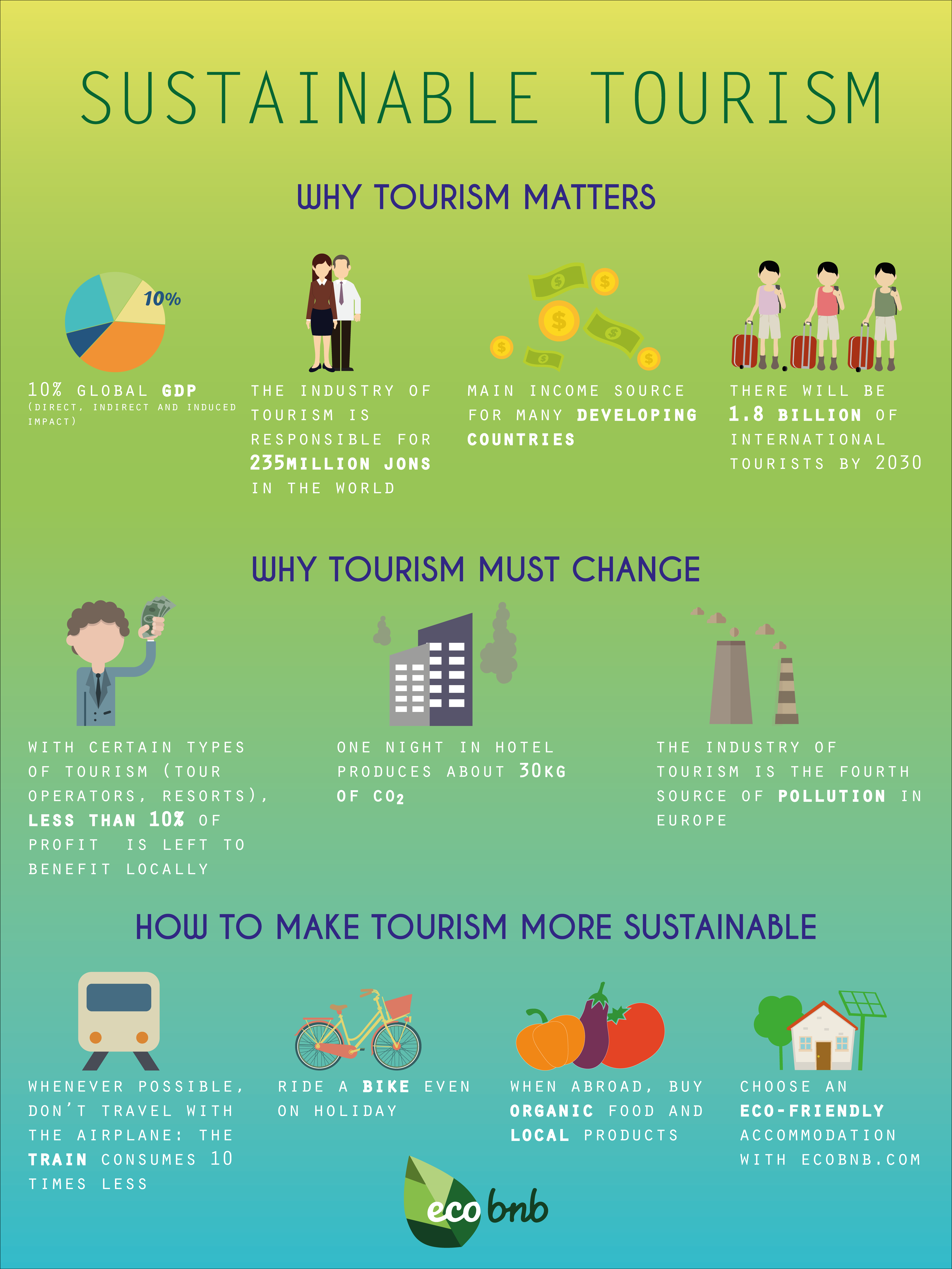
Sustainable tourism is a tourism form which has received significant attention in recent years, both by the media and the academic community. If you Google the term ‘sustainable tourism’ over 270,000,000 results are returned- that’s a lot!
The body of literature addressing sustainable practices in tourism has expanded exponentially. In fact, there is so much information on the concept of sustainable tourism nowadays that you take take an entire travel and tourism degree focussed on the sustainability management issues!
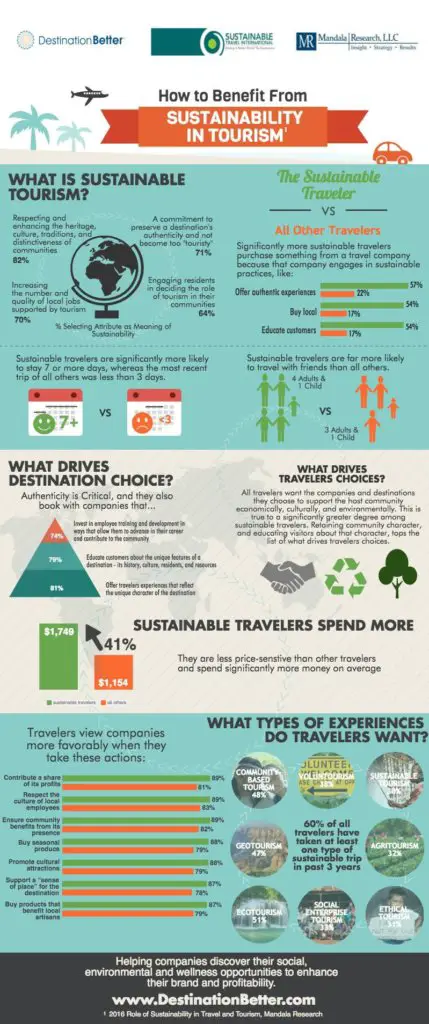
One of the earliest and most regarded definitions of sustainable tourism was published in The Brundtland Report , where it was defined as “development that meets the needs of the present without compromising the ability of future generations to meet their own needs”.
This sums it up pretty well to me. Think about it- if everyone (industry workers, government, tourists etc) continues to act in the way that they have been, will our grandchildren or great grandchildren have the same opportunities that we have had? For example, if litter is dropped on the beach and not cleared up, then future tourists will not want to visit that beach .
And if economic leakage is not controlled (i.e. when money spent by tourists leaves the country as a result of foreign owned businesses, imported produce etc) then the local people will see little or no benefits of the tourism and may become unwilling to work in the sector or even become antagonised by it. You see where I am going with this?
Another key definition of sustainable tourism is that of The United Nations World Tourism Organisation who state that sustainable tourism is “tourism that takes full account of its current and future economic, social and environmental impacts, addressing the needs of visitors, the industry, the environment and host communities”.
According to the The United Nations World Tourism Organisation , sustainable tourism should:
- Make optimal use of environmental resources that constitute a key element in tourism development, maintaining essential ecological processes and helping to conserve natural heritage and biodiversity.
- Respect the socio-cultural authenticity of host communities, conserve their built and living cultural heritage and traditional values, and contribute to inter-cultural understanding and tolerance.
- Ensure viable, long-term economic operations, providing socio-economic benefits to all stakeholders that are fairly distributed, including stable employment and income-earning opportunities and social services to host communities, and contributing to poverty alleviation.
As I pointed out, there is a wide breadth of tourism literature available in today’s market. Some of my favourite academic texts include Managing Sustainable Tourism by David Edgell and Sustainable Tourism by David Weaver. You can also find a wide range of research papers on Google Scholar .

Sustainable tourism influences positive movements that in return will create successful development by following strategies that allow the positive impacts to outweigh negative impacts.
As you can see from the graph below, the tourism industry is predicted to continue growing at a rapid rate. This means that any negative impacts caused as a result of tourism will also grow, thus indicating an urgent need for these to be carefully managed and mitigated through sustainable tourism practices.
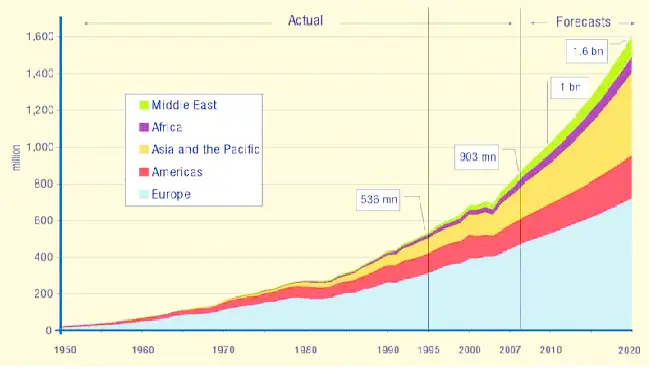
From the depths of the Amazon jungle to the Australian outback, there are few places in the world that have escaped the burgeoning growth of the travel and tourism industry. Unfortunately, in many cases, this has come at the expense of natural resources, local economies and indigenous populations.
A few years ago I visited a place called Dahab on my travels through Egypt , because I wanted visit the ‘Sharm el Sheik of 30 years ago. I plan to visit the ‘Thailand of days past’ by travelling to Myanmar and I chose the ‘less trodden’ path when climbing Mount Kilimanjaro .
Areas untouched by tourism are becoming more difficult to find. But more worryingly, areas that are untainted or undamaged by tourism are also becoming less common.
If we want to preserve the very things that it is we are going to see (the beach, the mountain, the wildlife etc), then we need to behave responsibly and sustainably.

T he Worldwide Fund for Nature (WWF) and Tourism Concern (1991) outline 10 principles for sustainable tourism. These are outlined below:
- Using resources sustainably. The conservation and sustainable use of resources- natural, social and cultural – is crucial and makes long-term business sense.
- Reducing over-consumption and waste. Reduction of over-consumption and waste avoids the costs of restoring long-term environmental damage and contributes to the quality of tourism.
- Maintaining biodiversity. Maintaining and promoting natural, social and cultural diversity is essential for long-term sustainable tourism and creates a resilient base for the industry.
- Integrating tourism into planning. Tourism development which is integrated into a national and local strategic planning framework and which undertake environmental impact assessments increases the long-term viability of tourism.
- Supporting local economies. Tourism that supports a wide range of local economic activities and which takes environmental costs and values into account, both protects these economies and avoids environmental damage.
- Involving local communities. The full involvement of local communities in the tourism sector not only benefits them and the environment in general but also improves the quality of the tourism experience.
- Consulting stakeholders and the public. Consulting between the tourism industry and local communities, organizations and institutions are essential if they are to work alongside each other and resolve potential conflicts of interest.
- Training staff. Staff training which integrates sustainable tourism into work practices, along with recruitment of personnel at all levels, improves the quality of the tourism product.
- Marketing tourism responsibly. Marketing that provides tourists with the full and responsible information increases respect for the natural, social and cultural environments of destination areas and enhances customer satisfaction.
- Undertaking research. Ongoing research and monitoring by the industry using effective data collection and analysis are essential to help solve problems and to bring benefits to destinations, the industry, and consumers.
Benefits of sustainable tourism
Sustainable tourism has many, many benefits. In fact, many would argue that implementing sustainable tourism is not a choice at all, it is essential. But to summarise, here are the key advantages of sustainable tourism:

Sustainable tourism promotes the conservation and protection of natural resources and biodiversity, reducing the negative impacts of tourism on the environment. It also encourages the use of eco-friendly transportation and accommodations, reducing carbon footprint and other pollutants.
Sustainable tourism can contribute to poverty reduction by creating job opportunities and income for local communities. It also promotes cultural understanding and respect by engaging tourists in local cultures and traditions.
This type of tourism can be a profitable and economically viable industry, contributing to economic growth and development. It supports local businesses and economies by promoting local products and services.
Sustainable tourism can help to preserve natural and cultural heritage sites for future generations by promoting responsible tourism practices and supporting conservation efforts.
Sustainable tourism can raise awareness and educate people about environmental and social issues, and encourage behaviour change towards more sustainable practices. It also provides educational opportunities for tourists to learn about local cultures and traditions.
- Sustainable tourism can lead to a more meaningful and authentic travel experience for tourists, as they can engage with local communities and cultures in a responsible way.
Overall, sustainable tourism can benefit both tourists and local communities by promoting responsible and sustainable tourism practices that respect the environment, society, and economy.
Disadvantages of sustainable tourism

While sustainable tourism has many benefits, there are also some potential disadvantages to consider. These include:
Sustainable tourism often requires more investments in eco-friendly technologies and practices, which can increase the costs for tourism businesses and potentially make it more expensive for tourists.
Sustainable tourism often requires limiting the number of tourists to reduce negative impacts on the environment and local communities, which can limit the economic benefits for tourism businesses and potentially reduce access for some tourists.
Sustainable tourism practices may require limiting the development of tourism infrastructure in certain areas to protect natural and cultural heritage sites, which can limit economic growth and development opportunities for local communities.
Sustainable tourism may require changes in local cultural practices and traditions to accommodate the needs of tourists, which can potentially lead to the loss of cultural erosion and loss of heritage.
Sustainable tourism practices can vary widely across destinations and tourism businesses, which can lead to inconsistencies in quality and standardisation, potentially reducing the overall effectiveness of sustainable tourism practices.
Ever heard of the term ‘easier said than done’? Sustainable tourism can be difficult to implement and manage, requiring partnerships between different stakeholders and long-term planning and management.
It’s important to note, however, that these potential disadvantages can be mitigated through careful tourism planning , collaboration, and monitoring to ensure that sustainable tourism practices are effective and beneficial for all stakeholders involved.
Examples of sustainable tourism
It’s not difficult to be a sustainable tourist , the biggest problem is a general lack of awareness amongst many tourists. If you want to learn more about how to be a sustainable traveller I recommend this book- How to be a highly Sustainable Tourist: A Guidebook for the Conscientious Traveller .
There are so many wonderful examples of sustainable tourism throughout the world! I have visited a few and I have lots more on my bucket list. Here are a few of my favourite examples.
My first example of sustainable tourism is Footsteps Ecolodge, which I visited back in 2010.
David, the Founder of Footsteps Ecolodge expresses how when he took a relatively cheap trip to The Gambia, he discovered that the staff at his booked hotel were only earning on average £1 per day. David felt guilty for enjoying a holiday knowing that the locals were receiving little or no economic benefits at all from hosting him.
David went on to develop Footsteps Ecolodge, with a mission to improve The Gambia’s trade through responsible tourism and therefore encourages sustainable development. In fact, one of his goals has led footsteps to employ only from the local village and buy only local produce.
I loved visiting this ecolodge. It has many environmentally friendly initiatives, ranging from solar powered electricity to composting toilets. It is based far away from the main tourist areas, providing a unique and authentic holiday experience. After spending a few days in the main tourist resort of Kotu, I was happy to exchange the evening chatter in the restaurants for the humming of grasshoppers and the beach bar music for the gentle sounds of waves.
You can read more on David’s story and the story behind Footsteps Ecolodge here.
The Eden Project is another great example of sustainable tourism.
It was built to demonstrate the importance of plants to people and to promote the understanding of vital relationships between plants and people. It is a huge complex that welcomes a wide range of tourists from the UK and overseas. In 2017, the project attracted more than o ne million visitors.
The project in fact has annual sustainability reports, monitoring its sustainable impact year on year.
Reality Tours and Travel’s mission is to provide authentic and thought-provoking local experiences through their tours and to use the profits to create change in Indian communities.
Reality Tours and Travel is a social catalyst and works towards profit sharing programs. 80% of their profits go directly to Reality Gives which runs high quality education programs in areas where their tours work.
Reality Tours and Travel now welcomes over 15,000 guests each year and employs over 50 members of staff.
The Dolphin Discovery Centre begun when Mrs Evelyn Smith begun to feed a group of dolphins near her home. Following her discovery of the dolphin grouping, specialists were brought in to monitor and study the local dolphins.
A few years later, the Dolphin Discovery Centre allowed tourists and community members to interact with the dolphins in hope they would understand and enjoy the marine mammals.
In brief, the Dolphin Discovery Centre Adopt a Dolphin Program supports the conservation of dolphins and the broader marine environment.
To date, the Dolphin Discovery Centre not only conserves dolphins, the centre also conserves turtles too. Learn more on adopting a dolphin or turtle with the Dolphin Discovery Centre here.
Ranch Margot is exactly what it sounds, a ranch located in Costa Rica. It all begun in 2004 when the founder of Rancho Margot, Juan Sostheim, purchased 400 acres of pasture. Despite the land being cleared of all vegetation, Juan Sostheim had a vision to grow sustainable food and raising animals.
Today, Rancho Margot focuses specifically on sustainable production and living, from the food they delivery to their energy production and the transportation used. Read more on Rancho Margot here.
Rancho Margot’s sustainable mission is in keeping with the Brundtland Report.
“To achieve and maintain sustainable operations, we work to find better ways to satisfy our needs without compromising future generations”
Whilst I didn’t get a chance got visit Rancho Margot during our travels through Costa Rica , it does look like a fantastic place to go and a great example of sustainable tourism.

So now that we understand a bit more about what sustainable tourism is and what it looks like in practice, lets re-cap the key points that we have covered in this article.
Sustainable tourism is an approach to tourism that seeks to minimise negative impacts on the environment, society, and economy, while maximising the positive impacts.
- Sustainable tourism can help to preserve natural and cultural heritage sites, and contribute to poverty reduction by creating job opportunities and income for local communities.
- Sustainable tourism promotes responsible travel practices, such as respecting local cultures, conserving natural resources, and reducing carbon footprint.
- Sustainable tourism requires partnerships between different stakeholders, including governments, local communities, NGOs, and private sector businesses.
- Sustainable tourism involves long-term planning and management to ensure that the benefits of tourism are sustainable over time.
- Sustainable tourism can be a profitable and economically viable industry that contributes to economic growth and development.
- Sustainable tourism can help to raise awareness about environmental and social issues, and encourage behavior change towards more sustainable practices.
- Sustainable tourism can support the conservation of biodiversity and ecosystem services, which are crucial for the health of the planet and human well-being.
- Sustainable tourism is not just a trend or a buzzword, but a necessity for the future of tourism and the planet.
Now lets finish up this article about sustainable tourism by answering some of the most common questions on this topic.
Sustainable tourism is important because it can help to preserve natural and cultural heritage sites, contribute to poverty reduction, promote responsible travel practices, and support the conservation of biodiversity and ecosystem services.
What are some examples of sustainable tourism practices?
Examples of sustainable tourism practices include using eco-friendly transportation and accommodations, supporting local businesses and communities, conserving natural resources, and respecting local cultures.
How can tourists practice sustainable tourism?
Tourists can practice sustainable tourism by reducing their carbon footprint, supporting local businesses and communities, respecting local cultures, and conserving natural resources.
What is the role of governments in sustainable tourism?
Governments can play a crucial role in promoting and regulating sustainable tourism practices, such as setting standards and regulations for tourism businesses, supporting local communities, and preserving natural and cultural heritage sites.
How can tourism businesses implement sustainable practices?
Tourism businesses can implement sustainable practices by adopting eco-friendly technologies and practices, supporting local communities and economies, reducing waste and carbon emissions, and promoting responsible tourism practices.
What is the impact of unsustainable tourism practices?
Unsustainable tourism practices can have negative impacts on the environment, such as pollution , overuse of natural resources, and habitat destruction. They can also have negative social impacts, such as exploitation of local communities and cultures.
How can sustainable tourism contribute to economic growth and development ?
Sustainable tourism can contribute to economic growth and development by creating job opportunities , generating income for local communities, and promoting local businesses and economies.
How can sustainable tourism help to address climate change?
Sustainable tourism can help to address climate change by reducing carbon emissions through the use of eco-friendly transportation and accommodations, and by promoting responsible travel practices.
How can consumers support sustainable tourism?
Consumers can support sustainable tourism by choosing eco-friendly accommodations and transportation options, supporting local businesses and communities, respecting local cultures, and conserving natural resources.
To summarise, sustainable tourism is a form of tourism that takes a long term approach. It considers needs of the future, not only the present. Sustainable tourism has close ties with a number of other tourism forms such as responsible tourism, alternative tourism and ecotourism. In order to be sustainable the three pillars of sustainable tourism must be accounted for: economic impacts, social impacts, environmental impacts.
Typically tourists who partake in sustainable tourism activities will have a desire to help and support local communities and environments whilst avoiding any negative impacts their visit might bring. Many tourists now are far more conscious than they used to be and in general, society is a lot more aware of the impacts of their actions. In many ways, this has fuelled the sustainable behaviours of a number of stakeholders, who seek to please their customers and to enhance their own business prospects.
If you found this article about sustainable tourism helpful, I am sure you will enjoy these too:
- The scary truth about water insecurity
- Cultural erosion: A simple explanation
- Why Ecotourism in Costa Rica is such big business
- 13 Social impacts of tourism + explanations + examples
- 15 reasons volunteering might not benefit you as much as you think: Negative impacts of volunteer tourism
Liked this article? Click to share!

December 2022 - You are accessing an archived version of our website. This website is no longer maintained or updated. The Sustainable Development Knowledge Platform has been migrated here: https://sdgs.un.org/
You will be redirected to the new Partnership Platform in 10 seconds.
- A/70/472 - Sustainable development: report of the Second Committee [Arabic] [Chinese] [English] [French] [Russian] [Spanish]
- A/RES/70/193 - International Year of Sustainable Tourism for Development, 2017 [Arabic] [Chinese] [English] [French] [Russian] [Spanish]
- A/RES/70/196 - Sustainable tourism and sustainable development in Central America [Arabic] [Chinese] [English] [French] [Russian] [Spanish]
- A/RES/70/200 - Global Code of Ethics for Tourism [Arabic] [Chinese] [English] [French] [Russian] [Spanish]
- Compendium of Best Practices in Sustainable Tourism
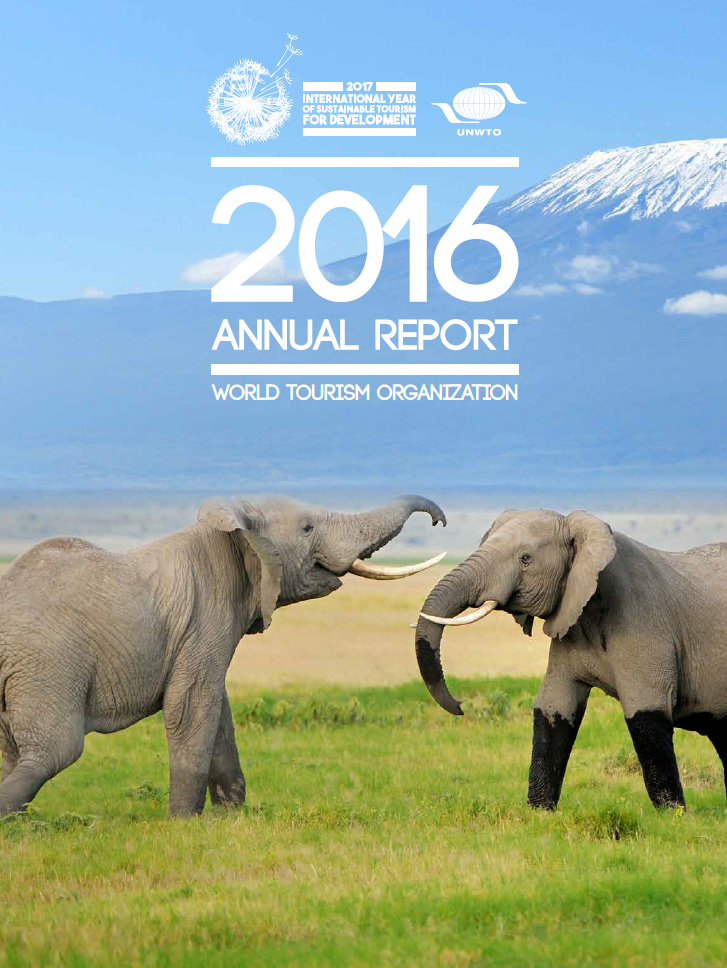
Sustainable Tourism (Sustainable Development of Tourism, Sustainable Tourism Management)
- Reference work entry
- First Online: 22 November 2023
- pp 3613–3620
- Cite this reference work entry

- Nil Sonuç 7
Definitions and Conceptualizations of Sustainable Tourism
A well designed and well-managed tourism can make a significant contribution to the three dimensions of sustainable development and has close linkages to other sectors and can create decent jobs and generate trade opportunities.
UN Resolution ( 2012 , pp. 130/283)
In line with the above description of the United Nations, the “sustainable tourism” definition of the United Nations World Tourism Organization (UNWTO) is as follows:
Tourism that takes full account of its current and future economic, social and environmental impacts, addressing the needs of visitors, the industry, the environment and host communities.
UNEP and UNWTO ( 2005 , p. 12)
Since the first appearance of the environmental concerns by Brundtland Commission with “Our Common Future Report,” the need for the protection of the scarce resources of the world while developing the industry to meet the needs of current and future generations, conceptually the sustainability,...
This is a preview of subscription content, log in via an institution to check access.
Access this chapter
- Available as PDF
- Read on any device
- Instant download
- Own it forever
- Available as EPUB and PDF
- Durable hardcover edition
- Dispatched in 3 to 5 business days
- Free shipping worldwide - see info
Tax calculation will be finalised at checkout
Purchases are for personal use only
Institutional subscriptions
Boluk, K., Cavaliere, C. T., & Higgins-Desbiolles, F. (2017). Critical thinking to realize sustainability in tourism systems: Reflecting on the 2030 sustainable development goals. Journal of Sustainable Tourism, 25 (9), 1201–1204. https://doi.org/10.1080/09669582.2017.1333263 .
Article Google Scholar
Bramwell, B., Higham, J., Lane, B., & Miller, G. (2017). Twenty-five years of sustainable tourism and the Journal of Sustainable Tourism: Looking back and moving forward. Journal of Sustainable Tourism, 25 (1), 1–9. https://doi.org/10.1080/09669582.2017.1251689 .
Butler, R. W. (1980). The concept of a tourist area cycle of evolution: Implication for management of resources. Canadian Geographer, 24 (1), 5–12.
Cater, C., Garrod, B., & Low, T. (2015). The encyclopedia of sustainable tourism . London: CABI.
Book Google Scholar
Cotterell, D., Hales, R., Arcodia, C., & Ferreira, J.-A. (2019). Overcommitted to tourism and under committed to sustainability: The urgency of teaching “strong sustainability” in tourism courses. Journal of Sustainable Tourism, 27 (7), 882–902. https://doi.org/10.1080/09669582.2018.1545777 .
D’Allonnes, M. R. (2008). The philosophical implications of sustainable development. In P. Jacquet, L. Tubiana, H. Kieken, J.-M. Bellot, D. Loyer, M. Lönnroth, M. D’Allonnes, & J. Jouzel (Eds.), L’europe et Le Développement Durable/Europe and Sustainable Dévelopment (pp. 58–68). Paris: Collection Penser L’Europe. CulturesFrance.
Google Scholar
Doxey, G. (1975, September). A causation theory of visitor-resident irritants: Methodology and research inferences in the impact of tourism. In Sixth annual conference proceedings of the travel research association (pp. 195–198). San Diego.
Faulkner, B. (2003). Destination Australia: A research agenda for 2002 and beyond. In H. W. Faulkner, L. Fredline, L. Jago, & C. Cooper (Eds.), Progressing tourism research (pp. 341–384). Channel View Publications/Cromwell Press, GB. UK USA Canada Australia. ISBN, 1-853150-48-2(hbk), ISBN, 1-853150-47-4 (pbk).
Garrod, B., & Fyall, A. (1998). Beyond the rhetoric of sustainable tourism? Tourism Management, 19 (3), 199–212.
Gössling, S., & Hall, C. M. (2019). Sharing versus collaborative economy: How to align ICT developments and the SDGs in tourism? Journal of Sustainable Tourism, 27 (1), 74–96. https://doi.org/10.1080/09669582.2018.1560455 .
Hall, C. M. (2019). Constructing sustainable tourism development: The 2030 agenda and the managerial ecology of sustainable tourism. Journal of Sustainable Tourism, 27 (7), 1044–1060. https://doi.org/10.1080/09669582.2018.1560456 .
Hardy, A., Beeton, R. J. S., & Pearson, L. (2002). Sustainable tourism: An overview of the concept and its position in relation to conceptualisations of tourism. Journal of Sustainable Tourism, 10 (6), 475–496.
Harilal, V., Tichaawa, T. M., & Saarinen, J. (2018). “Development without policy”: Tourism planning and research needs in Cameroon, Central Africa. Tourism Planning & Development . https://doi.org/10.1080/21568316.2018.1501732 .
Higgins-Desbiolles, F. (2018). Sustainable tourism: Sustaining tourism or something more? Tourism Management Perspectives, 25 , 157–160.
Higham, J., & Miller, G. (2018). Transforming societies and transforming tourism: Sustainable tourism in times of change. Journal of Sustainable Tourism, 26 (1), 1–8. https://doi.org/10.1080/09669582.2018.1407519 .
Hughes, E., & Scheyvens, R. (2016). Corporate social responsibility in tourism post-2015: A development first approach. Tourism Geographies, 18 (5), 469–482. https://doi.org/10.1080/14616688.2016.1208678 .
Islama, M. M., & Shamsuddohab, M. (2018). Coastal and marine conservation strategy for Bangladesh in the context of achieving blue growth and sustainable development goals (SDGs). Environmental Science and Policy, 87 , 45–54.
IUCN (The International Union for Conservation of Nature). https://www.iucn.org/about . Accessed 1 July 2019.
Jones, P., Hillier, D., & Comfort, D. (2017). The sustainable development goals and the tourism and hospitality industry. Athens Journal of Tourism, 4 (1), 7–18. https://doi.org/10.30958/ajt.4.1.1 .
Kimbu, A. N., & Tichaawa, T. M. (2018). Sustainable development goals and socio-economic development through tourism in Central Africa: Myth or reality? GeoJournal of Tourism and Geosites , Year XI, 23 (3), 780–796. https://doi.org/10.30892/gtg.23314-328 .
Kristjánsdóttir, K. R., Ólafsdóttir, R., & Ragnarsdóttir, K. V. (2018). Reviewing integrated sustainability indicators for tourism. Journal of Sustainable Tourism, 26 (4), 583–599. https://doi.org/10.1080/09669582.2017.1364741 .
Mihalic, T. (2016). Sustainable-responsible tourism discourse – Towards ‘responsustable’ tourism. Journal of Cleaner Production, 111 (B), 461–470.
Murphy, P. E., & Price, G. G. (2005). Tourism in sustainable development. In W. F. Theobald (Ed.), Global tourism (3rd ed.. ISBN, 0-7506-7789-9, pp. 167–193). Elsevier.
Pearce, D.W. (1992). Towards sustainable development through environmental assessment. CSERGE Working Paper PA 92-11.
Saarinen, J. (2014). Critical sustainability: Setting the limits to growth and responsibility in tourism. Sustainability, 6 , 1–17. https://doi.org/10.3390/su6010001 .
Scheyvens, R., & Biddulph, R. (2018). Inclusive tourism development. Tourism Geographies, 20 (4), 589–609. https://doi.org/10.1080/14616688.2017.1381985 .
Sonuç, N. (2014). Sürdürülebilir Turizm: Tanımı ve İçeriği. In M. Kozak (Ed.), Sürdürülebilir Turizm . Ankara: Detay Yayıncılık.
Su, W.-S., Chang, L.-F., & Yeh, M.-T. (2017). Developing a sustainable tourism attitude in Taiwanese residents. International Journal of Organizational Innovation, 10 (1), 275–289.
Tracey, L., Cumming, T. L., Shackletonb, R. T., Förster, J., Dinie, J., Khana, A., Gumulae, M., & Kubiszewskif, I. (2017). Achieving the national development agenda and the Sustainable Development Goals (SDGs) through investment in ecological infrastructure: A case study of South Africa. Ecosystem Services, 27 , 253–260.
UN Resolution. (2012). The future we want. 130/283. https://sustainabledevelopment.un.org/futurewewant.html . Accessed 1 July 2019.
UN Resolution. (2015). Transforming our world: The 2030 Agenda for Sustainable Development. Resolution adopted by the General Assembly on 25 September 2015.
UN Sustainable Development Goals Knowledge Platform. https://sustainabledevelopment.un.org/sdgs . Accessed 1 July 2019.
UNEP & UNWTO. (2005). Making tourism more sustainable – A guide for policy makers, p. 12. www.unep.fr/shared/publications/pdf/DTIx0592xPA-TourismPolicyEN.pdf . Accessed 2 July 2019.
UNWTO Tourism for SDGs Platform. http://tourism4sdgs.org/tourism-for-sdgs/ . Accessed 1 July 2019.
UNWTO. Global Code of Ethics for Tourism. http://ethics.unwto.org/en/content/global-code-ethics-tourism Accessed 2 July 2019.
WCED (World Commission on Environment and Development). (1987). Our Common Future . New York: Oxford University Press.
Weaver, D. B. (2001). Encyclopedia of ecotourism . Cabi International Publishing. Wallingford.
WWF (World Wildlife Fund). http://www.wwf.org Accessed 2 July 2019.
Download references
Author information
Authors and affiliations.
İzmir Katip Çelebi University, İzmir, Turkey
You can also search for this author in PubMed Google Scholar
Corresponding author
Correspondence to Nil Sonuç .
Editor information
Editors and affiliations.
Guildhall Faculty of Business and Law London Metropolitan University, London Metropolitan University, London, UK
Samuel O. Idowu
BFH - Bern, Bern, Switzerland
René Schmidpeter
College of Business, Loyola University New Orleans, New Orleans, LA, USA
Nicholas Capaldi
International Training Centre of the IL, International Labor Organization, Turin, Italy
Liangrong Zu
Department of Economics, Society and Politics, University of Urbino Carlo Bo, Urbino, Italy
Mara Del Baldo
Instituto Politécnico da Guarda, Guarda, Portugal
Section Editor information
Faculty of Social Sciences and Business Studies, University of Eastern Finland, Kuopio, Finland
Arto O. Salonen
Rights and permissions
Reprints and permissions
Copyright information
© 2023 Springer Nature Switzerland AG
About this entry
Cite this entry.
Sonuç, N. (2023). Sustainable Tourism (Sustainable Development of Tourism, Sustainable Tourism Management). In: Idowu, S.O., Schmidpeter, R., Capaldi, N., Zu, L., Del Baldo, M., Abreu, R. (eds) Encyclopedia of Sustainable Management. Springer, Cham. https://doi.org/10.1007/978-3-031-25984-5_454
Download citation
DOI : https://doi.org/10.1007/978-3-031-25984-5_454
Published : 22 November 2023
Publisher Name : Springer, Cham
Print ISBN : 978-3-031-25983-8
Online ISBN : 978-3-031-25984-5
eBook Packages : Business and Management Reference Module Humanities and Social Sciences Reference Module Business, Economics and Social Sciences
Share this entry
Anyone you share the following link with will be able to read this content:
Sorry, a shareable link is not currently available for this article.
Provided by the Springer Nature SharedIt content-sharing initiative
- Publish with us
Policies and ethics
- Find a journal
- Track your research
- Tools and Resources
- Customer Services
- Agriculture and the Environment
- Case Studies
- Chemistry and Toxicology
- Environment and Human Health
- Environmental Biology
- Environmental Economics
- Environmental Engineering
- Environmental Ethics and Philosophy
- Environmental History
- Environmental Issues and Problems
- Environmental Processes and Systems
- Environmental Sociology and Psychology
- Environments
- Framing Concepts in Environmental Science
- Management and Planning
- Policy, Governance, and Law
- Quantitative Analysis and Tools
- Sustainability and Solutions
- Share This Facebook LinkedIn Twitter
Article contents
The role of tourism in sustainable development.
- Robert B. Richardson Robert B. Richardson Community Sustainability, Michigan State University
- https://doi.org/10.1093/acrefore/9780199389414.013.387
- Published online: 25 March 2021
Sustainable development is the foundational principle for enhancing human and economic development while maintaining the functional integrity of ecological and social systems that support regional economies. Tourism has played a critical role in sustainable development in many countries and regions around the world. In developing countries, tourism development has been used as an important strategy for increasing economic growth, alleviating poverty, creating jobs, and improving food security. Many developing countries are in regions that are characterized by high levels of biological diversity, natural resources, and cultural heritage sites that attract international tourists whose local purchases generate income and support employment and economic development. Tourism has been associated with the principles of sustainable development because of its potential to support environmental protection and livelihoods. However, the relationship between tourism and the environment is multifaceted, as some types of tourism have been associated with negative environmental impacts, many of which are borne by host communities.
The concept of sustainable tourism development emerged in contrast to mass tourism, which involves the participation of large numbers of people, often in structured or packaged tours. Mass tourism has been associated with economic leakage and dependence, along with negative environmental and social impacts. Sustainable tourism development has been promoted in various ways as a framing concept in contrast to these economic, environmental, and social impacts. Some literature has acknowledged a vagueness of the concept of sustainable tourism, which has been used to advocate for fundamentally different strategies for tourism development that may exacerbate existing conflicts between conservation and development paradigms. Tourism has played an important role in sustainable development in some countries through the development of alternative tourism models, including ecotourism, community-based tourism, pro-poor tourism, slow tourism, green tourism, and heritage tourism, among others that aim to enhance livelihoods, increase local economic growth, and provide for environmental protection. Although these models have been given significant attention among researchers, the extent of their implementation in tourism planning initiatives has been limited, superficial, or incomplete in many contexts.
The sustainability of tourism as a global system is disputed among scholars. Tourism is dependent on travel, and nearly all forms of transportation require the use of non-renewable resources such as fossil fuels for energy. The burning of fossil fuels for transportation generates emissions of greenhouse gases that contribute to global climate change, which is fundamentally unsustainable. Tourism is also vulnerable to both localized and global shocks. Studies of the vulnerability of tourism to localized shocks include the impacts of natural disasters, disease outbreaks, and civil unrest. Studies of the vulnerability of tourism to global shocks include the impacts of climate change, economic crisis, global public health pandemics, oil price shocks, and acts of terrorism. It is clear that tourism has contributed significantly to economic development globally, but its role in sustainable development is uncertain, debatable, and potentially contradictory.
- conservation
- economic development
- environmental impacts
- sustainable development
- sustainable tourism
- tourism development
Introduction
Sustainable development is the guiding principle for advancing human and economic development while maintaining the integrity of ecosystems and social systems on which the economy depends. It is also the foundation of the leading global framework for international cooperation—the 2030 Agenda for Sustainable Development and the Sustainable Development Goals (SDGs) (United Nations, 2015 ). The concept of sustainable development is often associated with the publication of Our Common Future (World Commission on Environment and Development [WCED], 1987 , p. 29), which defined it as “paths of human progress that meet the needs and aspirations of the present generation without compromising the ability of future generations to meet their needs.” Concerns about the environmental implications of economic development in lower income countries had been central to debates about development studies since the 1970s (Adams, 2009 ). The principles of sustainable development have come to dominate the development discourse, and the concept has become the primary development paradigm since the 1990s.
Tourism has played an increasingly important role in sustainable development since the 1990s, both globally and in particular countries and regions. For decades, tourism has been promoted as a low-impact, non-extractive option for economic development, particularly for developing countries (Gössling, 2000 ). Many developing countries have managed to increase their participation in the global economy through development of international tourism. Tourism development is increasingly viewed as an important tool in increasing economic growth, alleviating poverty, and improving food security. Tourism enables communities that are poor in material wealth, but rich in history and cultural heritage, to leverage their unique assets for economic development (Honey & Gilpin, 2009 ). More importantly, tourism offers an alternative to large-scale development projects, such as construction of dams, and to extractive industries such as mining and forestry, all of which contribute to emissions of pollutants and threaten biodiversity and the cultural values of Indigenous Peoples.
Environmental quality in destination areas is inextricably linked with tourism, as visiting natural areas and sightseeing are often the primary purpose of many leisure travels. Some forms of tourism, such as ecotourism, can contribute to the conservation of biodiversity and the protection of ecosystem functions in destination areas (Fennell, 2020 ; Gössling, 1999 ). Butler ( 1991 ) suggests that there is a kind of mutual dependence between tourism and the environment that should generate mutual benefits. Many developing countries are in regions that are characterized by high levels of species diversity, natural resources, and protected areas. Such ideas imply that tourism may be well aligned with the tenets of sustainable development.
However, the relationship between tourism and the environment is complex, as some forms of tourism have been associated with negative environmental impacts, including greenhouse gas emissions, freshwater use, land use, and food consumption (Butler, 1991 ; Gössling & Peeters, 2015 ; Hunter & Green, 1995 ; Vitousek et al., 1997 ). Assessments of the sustainability of tourism have highlighted several themes, including (a) parks, biodiversity, and conservation; (b) pollution and climate change; (c) prosperity, economic growth, and poverty alleviation; (d) peace, security, and safety; and (e) population stabilization and reduction (Buckley, 2012 ). From a global perspective, tourism contributes to (a) changes in land cover and land use; (b) energy use, (c) biotic exchange and extinction of wild species; (d) exchange and dispersion of diseases; and (e) changes in the perception and understanding of the environment (Gössling, 2002 ).
Research on tourism and the environment spans a wide range of social and natural science disciplines, and key contributions have been disseminated across many interdisciplinary fields, including biodiversity conservation, climate science, economics, and environmental science, among others (Buckley, 2011 ; Butler, 1991 ; Gössling, 2002 ; Lenzen et al., 2018 ). Given the global significance of the tourism sector and its environmental impacts, the role of tourism in sustainable development is an important topic of research in environmental science generally and in environmental economics and management specifically. Reviews of tourism research have highlighted future research priorities for sustainable development, including the role of tourism in the designation and expansion of protected areas; improvement in environmental accounting techniques that quantify environmental impacts; and the effects of individual perceptions of responsibility in addressing climate change (Buckley, 2012 ).
Tourism is one of the world’s largest industries, and it has linkages with many of the prime sectors of the global economy (Fennell, 2020 ). As a global economic sector, tourism represents one of the largest generators of wealth, and it is an important agent of economic growth and development (Garau-Vadell et al., 2018 ). Tourism is a critical industry in many local and national economies, and it represents a large and growing share of world trade (Hunter, 1995 ). Global tourism has had an average annual increase of 6.6% over the past half century, with international tourist arrivals rising sharply from 25.2 million in 1950 to more than 950 million in 2010 . In 2019 , the number of international tourists reached 1.5 billion, up 4% from 2018 (Fennell, 2020 ; United Nations World Tourism Organization [UNWTO], 2020 ). European countries are host to more than half of international tourists, but since 1990 , growth in international arrivals has risen faster than the global average, in both the Middle East and the Asia and Pacific region (UNWTO, 2020 ).
The growth in global tourism has been accompanied by an expansion of travel markets and a diversification of tourism destinations. In 1950 , the top five travel destinations were all countries in Europe and the Americas, and these destinations held 71% of the global travel market (Fennell, 2020 ). By 2002 , these countries represented only 35%, which underscores the emergence of newly accessible travel destinations in Africa, Asia, the Middle East, and the Pacific Rim, including numerous developing countries. Over the past 70 years, global tourism has grown significantly as an economic sector, and it has contributed to the economic development of dozens of nations.
Given the growth of international tourism and its emergence as one of the world’s largest export sectors, the question of its impact on economic growth for the host countries has been a topic of great interest in the tourism literature. Two hypotheses have emerged regarding the role of tourism in the economic growth process (Apergis & Payne, 2012 ). First, tourism-led growth hypothesis relies on the assumption that tourism is an engine of growth that generates spillovers and positive externalities through economic linkages that will impact the overall economy. Second, the economic-driven tourism growth hypothesis emphasizes policies oriented toward well-defined and enforceable property rights, stable political institutions, and adequate investment in both physical and human capital to facilitate the development of the tourism sector. Studies have concluded with support for both the tourism-led growth hypothesis (e.g., Durbarry, 2004 ; Katircioglu, 2010 ) and the economic-led growth hypothesis (e.g., Katircioglu, 2009 ; Oh, 2005 ), whereas other studies have found support for a bidirectional causality for tourism and economic growth (e.g., Apergis & Payne, 2012 ; Lee & Chang, 2008 ).
The growth of tourism has been marked by an increase in the competition for tourist expenditures, making it difficult for destinations to maintain their share of the international tourism market (Butler, 1991 ). Tourism development is cyclical and subject to short-term cycles and overconsumption of resources. Butler ( 1980 ) developed a tourist-area cycle of evolution that depicts the number of tourists rising sharply over time through periods of exploration, involvement, and development, before eventual consolidation and stagnation. When tourism growth exceeds the carrying capacity of the area, resource degradation can lead to the decline of tourism unless specific steps are taken to promote rejuvenation (Butler, 1980 , 1991 ).
The potential of tourism development as a tool to contribute to environmental conservation, economic growth, and poverty reduction is derived from several unique characteristics of the tourism system (UNWTO, 2002 ). First, tourism represents an opportunity for economic diversification, particularly in marginal areas with few other export options. Tourists are attracted to remote areas with high values of cultural, wildlife, and landscape assets. The cultural and natural heritage of developing countries is frequently based on such assets, and tourism represents an opportunity for income generation through the preservation of heritage values. Tourism is the only export sector where the consumer travels to the exporting country, which provides opportunities for lower-income households to become exporters through the sale of goods and services to foreign tourists. Tourism is also labor intensive; it provides small-scale employment opportunities, which also helps to promote gender equity. Finally, there are numerous indirect benefits of tourism for people living in poverty, including increased market access for remote areas through the development of roads, infrastructure, and communication networks. Nevertheless, travel is highly income elastic and carbon intensive, which has significant implications for the sustainability of the tourism sector (Lenzen et al., 2018 ).
Concerns about environmental issues appeared in tourism research just as global awareness of the environmental impacts of human activities was expanding. The United Nations Conference on the Human Environment was held in Stockholm in 1972 , the same year as the publication of The Limits to Growth (Meadows et al., 1972 ), which highlighted the concerns about the implications of exponential economic and population growth in a world of finite resources. This was the same year that the famous Blue Marble photograph of Earth was taken by the crew of the Apollo 17 spacecraft (Höhler, 2015 , p. 10), and the image captured the planet cloaked in the darkness of space and became a symbol of Earth’s fragility and vulnerability. As noted by Buckley ( 2012 ), tourism researchers turned their attention to social and environmental issues around the same time (Cohen, 1978 ; Farrell & McLellan, 1987 ; Turner & Ash, 1975 ; Young, 1973 ).
The notion of sustainable development is often associated with the publication of Our Common Future , the report of the World Commission on Environment and Development, also known as the Brundtland Commission (WCED, 1987 ). The report characterized sustainable development in terms of meeting “the needs of the present without compromising the ability of future generations to meet their own needs” (WCED, 1987 , p. 43). Four basic principles are fundamental to the concept of sustainability: (a) the idea of holistic planning and strategy making; (b) the importance of preserving essential ecological processes; (c) the need to protect both human heritage and biodiversity; and (d) the need to develop in such a way that productivity can be sustained over the long term for future generations (Bramwell & Lane, 1993 ). In addition to achieving balance between economic growth and the conservation of natural resources, there should be a balance of fairness and opportunity between the nations of the world.
Although the modern concept of sustainable development emerged with the publication of Our Common Future , sustainable development has its roots in ideas about sustainable forest management that were developed in Europe during the 17th and 18th centuries (Blewitt, 2015 ; Grober, 2007 ). Sustainable forest management is concerned with the stewardship and use of forests in a way that maintains their biodiversity, productivity, and regeneration capacity as well as their potential to fulfill society’s demands for forest products and benefits. Building on these ideas, Daly ( 1990 ) offered two operational principles of sustainable development. First, sustainable development implies that harvest rates should be no greater than rates of regeneration; this concept is known as maximum sustainable yield. Second, waste emission rates should not exceed the natural assimilative capacities of the ecosystems into which the wastes are emitted. Regenerative and assimilative capacities are characterized as natural capital, and a failure to maintain these capacities is not sustainable.
Shortly after the emergence of the concept of sustainable development in academic and policy discourse, tourism researchers began referring to the notion of sustainable tourism (May, 1991 ; Nash & Butler, 1990 ), which soon became the dominant paradigm of tourism development. The concept of sustainable tourism, as with the role of tourism in sustainable development, has been interpreted in different ways, and there is a lack of consensus concerning its meaning, objectives, and indicators (Sharpley, 2000 ). Growing interest in the subject inspired the creation of a new academic journal, Journal of Sustainable Tourism , which was launched in 1993 and has become a leading tourism journal. It is described as “an international journal that publishes research on tourism and sustainable development, including economic, social, cultural and political aspects.”
The notion of sustainable tourism development emerged in contrast to mass tourism, which is characterized by the participation of large numbers of people, often provided as structured or packaged tours. Mass tourism has risen sharply in the last half century. International arrivals alone have increased by an average annual rate of more than 25% since 1950 , and many of those trips involved mass tourism activities (Fennell, 2020 ; UNWTO, 2020 ). Some examples of mass tourism include beach resorts, cruise ship tourism, gaming casinos, golf resorts, group tours, ski resorts, theme parks, and wildlife safari tourism, among others. Little data exist regarding the volume of domestic mass tourism, but nevertheless mass tourism activities dominate the global tourism sector. Mass tourism has been shown to generate benefits to host countries, such as income and employment generation, although it has also been associated with economic leakage (where revenue generated by tourism is lost to other countries’ economies) and economic dependency (where developing countries are dependent on wealthier countries for tourists, imports, and foreign investment) (Cater, 1993 ; Conway & Timms, 2010 ; Khan, 1997 ; Peeters, 2012 ). Mass tourism has been associated with numerous negative environmental impacts and social impacts (Cater, 1993 ; Conway & Timms, 2010 ; Fennell, 2020 ; Ghimire, 2013 ; Gursoy et al., 2010 ; Liu, 2003 ; Peeters, 2012 ; Wheeller, 2007 ). Sustainable tourism development has been promoted in various ways as a framing concept in contrast to many of these economic, environmental, and social impacts.
Much of the early research on sustainable tourism focused on defining the concept, which has been the subject of vigorous debate (Bramwell & Lane, 1993 ; Garrod & Fyall, 1998 ; Hunter, 1995 ; Inskeep, 1991 ; Liu, 2003 ; Sharpley, 2000 ). Early definitions of sustainable tourism development seemed to fall in one of two categories (Sharpley, 2000 ). First, the “tourism-centric” paradigm of sustainable tourism development focuses on sustaining tourism as an economic activity (Hunter, 1995 ). Second, alternative paradigms have situated sustainable tourism in the context of wider sustainable development policies (Butler, 1991 ). One of the most comprehensive definitions of sustainable tourism echoes some of the language of the Brundtland Commission’s definition of sustainable development (WCED, 1987 ), emphasizing opportunities for the future while also integrating social and environmental concerns:
Sustainable tourism can be thought of as meeting the needs of present tourists and host regions while protecting and enhancing opportunity for the future. Sustainable tourism development is envisaged as leading to management of all resources in such a way that we can fulfill economic, social and aesthetic needs while maintaining cultural integrity, essential ecological processes, biological diversity and life support systems. (Inskeep, 1991 , p. 461)
Hunter argued that over the short and long terms, sustainable tourism development should
“meet the needs and wants of the local host community in terms of improved living standards and quality of life;
satisfy the demands of tourists and the tourism industry, and continue to attract them in order to meet the first aim; and
safeguard the environmental resource base for tourism, encompassing natural, built and cultural components, in order to achieve both of the preceding aims.” (Hunter, 1995 , p. 156)
Numerous other definitions have been documented, and the term itself has been subject to widespread critique (Buckley, 2012 ; Hunter, 1995 ; Liu, 2003 ). Nevertheless, there have been numerous calls to move beyond debate about a definition and to consider how it may best be implemented in practice (Garrod & Fyall, 1998 ; Liu, 2003 ). Cater ( 1993 ) identified three key criteria for sustainable tourism: (a) meeting the needs of the host population in terms of improved living standards both in the short and long terms; (b) satisfying the demands of a growing number of tourists; and (c) safeguarding the natural environment in order to achieve both of the preceding aims.
Some literature has acknowledged a vagueness of the concept of sustainable tourism, which has been used to advocate for fundamentally different strategies for tourism development that may exacerbate existing conflicts between conservation and development paradigms (Garrod & Fyall, 1998 ; Hunter, 1995 ; Liu, 2003 ; McKercher, 1993b ). Similar criticisms have been leveled at the concept of sustainable development, which has been described as an oxymoron with a wide range of meanings (Adams, 2009 ; Daly, 1990 ) and “defined in such a way as to be either morally repugnant or logically redundant” (Beckerman, 1994 , p. 192). Sharpley ( 2000 ) suggests that in the tourism literature, there has been “a consistent and fundamental failure to build a theoretical link between sustainable tourism and its parental paradigm,” sustainable development (p. 2). Hunter ( 1995 ) suggests that practical measures designed to operationalize sustainable tourism fail to address many of the critical issues that are central to the concept of sustainable development generally and may even actually counteract the fundamental requirements of sustainable development. He suggests that mainstream sustainable tourism development is concerned with protecting the immediate resource base that will sustain tourism development while ignoring concerns for the status of the wider tourism resource base, such as potential problems associated with air pollution, congestion, introduction of invasive species, and declining oil reserves. The dominant paradigm of sustainable tourism development has been described as introverted, tourism-centric, and in competition with other sectors for scarce resources (McKercher, 1993a ). Hunter ( 1995 , p. 156) proposes an alternative, “extraparochial” paradigm where sustainable tourism development is reconceptualized in terms of its contribution to overall sustainable development. Such a paradigm would reconsider the scope, scale, and sectoral context of tourism-related resource utilization issues.
“Sustainability,” “sustainable tourism,” and “sustainable development” are all well-established terms that have often been used loosely and interchangeably in the tourism literature (Liu, 2003 ). Nevertheless, the subject of sustainable tourism has been given considerable attention and has been the focus of numerous academic compilations and textbooks (Coccossis & Nijkamp, 1995 ; Hall & Lew, 1998 ; Stabler, 1997 ; Swarbrooke, 1999 ), and it calls for new approaches to sustainable tourism development (Bramwell & Lane, 1993 ; Garrod & Fyall, 1998 ; Hunter, 1995 ; Sharpley, 2000 ). The notion of sustainable tourism has been reconceptualized in the literature by several authors who provided alternative frameworks for tourism development (Buckley, 2012 ; Gössling, 2002 ; Hunter, 1995 ; Liu, 2003 ; McKercher, 1993b ; Sharpley, 2000 ).
Early research in sustainable tourism focused on the local environmental impacts of tourism, including energy use, water use, food consumption, and change in land use (Buckley, 2012 ; Butler, 1991 ; Gössling, 2002 ; Hunter & Green, 1995 ). Subsequent research has emphasized the global environmental impacts of tourism, such as greenhouse gas emissions and biodiversity losses (Gössling, 2002 ; Gössling & Peeters, 2015 ; Lenzen et al., 2018 ). Additional research has emphasized the impacts of environmental change on tourism itself, including the impacts of climate change on tourist behavior (Gössling et al., 2012 ; Richardson & Loomis, 2004 ; Scott et al., 2012 ; Viner, 2006 ). Countries that are dependent on tourism for economic growth may be particularly vulnerable to the impacts of climate change (Richardson & Witkoswki, 2010 ).
The early focus on environmental issues in sustainable tourism has been broadened to include economic, social, and cultural issues as well as questions of power and equity in society (Bramwell & Lane, 1993 ; Sharpley, 2014 ), and some of these frameworks have integrated notions of social equity, prosperity, and cultural heritage values. Sustainable tourism is dependent on critical long-term considerations of the impacts; notions of equity; an appreciation of the importance of linkages (i.e., economic, social, and environmental); and the facilitation of cooperation and collaboration between different stakeholders (Elliott & Neirotti, 2008 ).
McKercher ( 1993b ) notes that tourism resources are typically part of the public domain or are intrinsically linked to the social fabric of the host community. As a result, many commonplace tourist activities such as sightseeing may be perceived as invasive by members of the host community. Many social impacts of tourism can be linked to the overuse of the resource base, increases in traffic congestion, rising land prices, urban sprawl, and changes in the social structure of host communities. Given the importance of tourist–resident interaction, sustainable tourism development depends in part on the support of the host community (Garau-Vadell et al., 2018 ).
Tourism planning involves the dual objectives of optimizing the well-being of local residents in host communities and minimizing the costs of tourism development (Sharpley, 2014 ). Tourism researchers have paid significant attention to examining the social impacts of tourism in general and to understanding host communities’ perceptions of tourism in particular. Studies of the social impacts of tourism development have examined the perceptions of local residents and the effects of tourism on social cohesion, traditional lifestyles, and the erosion of cultural heritage, particularly among Indigenous Peoples (Butler & Hinch, 2007 ; Deery et al., 2012 ; Mathieson & Wall, 1982 ; Sharpley, 2014 ; Whitford & Ruhanen, 2016 ).
Alternative Tourism and Sustainable Development
A wide body of published research is related to the role of tourism in sustainable development, and much of the literature involves case studies of particular types of tourism. Many such studies contrast types of alternative tourism with those of mass tourism, which has received sustained criticism for decades and is widely considered to be unsustainable (Cater, 1993 ; Conway & Timms, 2010 ; Fennell, 2020 ; Gursoy et al., 2010 ; Liu, 2003 ; Peeters, 2012 ; Zapata et al., 2011 ). Still, some tourism researchers have taken issue with the conclusion that mass tourism is inherently unsustainable (Sharpley, 2000 ; Weaver, 2007 ), and some have argued for developing pathways to “sustainable mass tourism” as “the desired and impending outcome for most destinations” (Weaver, 2012 , p. 1030). In integrating an ethical component to mass tourism development, Weaver ( 2014 , p. 131) suggests that the desirable outcome is “enlightened mass tourism.” Such suggestions have been contested in the literature and criticized for dubious assumptions about emergent norms of sustainability and support for growth, which are widely seen as contradictory (Peeters, 2012 ; Wheeller, 2007 ).
Models of responsible or alternative tourism development include ecotourism, community-based tourism, pro-poor tourism, slow tourism, green tourism, and heritage tourism, among others. Most models of alternative tourism development emphasize themes that aim to counteract the perceived negative impacts of conventional or mass tourism. As such, the objectives of these models of tourism development tend to focus on minimizing environmental impacts, supporting biodiversity conservation, empowering local communities, alleviating poverty, and engendering pleasant relationships between tourists and residents.
Approaches to alternative tourism development tend to overlap with themes of responsible tourism, and the two terms are frequently used interchangeably. Responsible tourism has been characterized in terms of numerous elements, including
ensuring that communities are involved in and benefit from tourism;
respecting local, natural, and cultural environments;
involving the local community in planning and decision-making;
using local resources sustainably;
behaving in ways that are sensitive to the host culture;
maintaining and encouraging natural, economic, and cultural diversity; and
assessing environmental, social, and economic impacts as a prerequisite to tourism development (Spenceley, 2012 ).
Hetzer ( 1965 ) identified four fundamental principles or perquisites for a more responsible form of tourism: (a) minimum environmental impact; (b) minimum impact on and maximum respect for host cultures; (c) maximum economic benefits to the host country; and (d) maximum leisure satisfaction to participating tourists.
The history of ecotourism is closely connected with the emergence of sustainable development, as it was born out of a concern for the conservation of biodiversity. Ecotourism is a form of tourism that aims to minimize local environmental impacts while bringing benefits to protected areas and the people living around those lands (Honey, 2008 ). Ecotourism represents a small segment of nature-based tourism, which is understood as tourism based on the natural attractions of an area, such as scenic areas and wildlife (Gössling, 1999 ). The ecotourism movement gained momentum in the 1990s, primarily in developing countries in Latin America and sub-Saharan Africa, and nearly all countries are now engaged in some form of ecotourism. In some communities, ecotourism is the primary economic activity and source of income and economic development.
The term “ecotourism” was coined by Hector Ceballos-Lascuráin and defined by him as “tourism that consists in travelling to relatively undisturbed or uncontaminated natural areas with the specific object of studying, admiring, and enjoying the scenery and its wild plants and animals” (Ceballos-Lascuráin, 1987 , p. 13). In discussing ecotourism resources, he also made reference to “any existing cultural manifestations (both past and present) found in these areas” (Ceballos-Lascuráin, 1987 , p. 14). The basic precepts of ecotourism had been discussed long before the actual use of the term. Twenty years earlier, Hetzer ( 1965 ) referred to a form of tourism “based principally upon natural and archaeological resources such as caves, fossil sites (and) archaeological sites.” Thus, both natural resources and cultural resources were integrated into ecotourism frameworks from the earliest manifestations.
Costa Rica is well known for having successfully integrated ecotourism in its overall strategy for sustainable development, and numerous case studies of ecotourism in Costa Rica appear in the literature (Chase et al., 1998 ; Fennell & Eagles, 1990 ; Gray & Campbell, 2007 ; Hearne & Salinas, 2002 ). Ecotourism in Costa Rica has been seen as having supported the economic development of the country while promoting biodiversity conservation in its extensive network of protected areas. Chase et al. ( 1998 ) estimated the demand for ecotourism in a study of differential pricing of entrance fees at national parks in Costa Rica. The authors estimated elasticities associated with the own-price, cross-price, and income variables and found that the elasticities of demand were significantly different between three different national park sites. The results reveal the heterogeneity characterizing tourist behavior and park attractions and amenities. Hearne and Salinas ( 2002 ) used choice experiments to examine the preferences of domestic and foreign tourists in Costa Rica in an ecotourism site. Both sets of tourists demonstrated a preference for improved infrastructure, more information, and lower entrance fees. Foreign tourists demonstrated relatively stronger preferences for the inclusion of restrictions in the access to some trails.
Ecotourism has also been studied extensively in Kenya (Southgate, 2006 ), Malaysia (Lian Chan & Baum, 2007 ), Nepal (Baral et al., 2008 ), Peru (Stronza, 2007 ), and Taiwan (Lai & Nepal, 2006 ), among many other countries. Numerous case studies have demonstrated the potential for ecotourism to contribute to sustainable development by providing support for biodiversity conservation, local livelihoods, and regional development.
Community-Based Tourism
Community-based tourism (CBT) is a model of tourism development that emphasizes the development of local communities and allows for local residents to have substantial control over its development and management, and a major proportion of the benefits remain within the community. CBT emerged during the 1970s as a response to the negative impacts of the international mass tourism development model (Cater, 1993 ; Hall & Lew, 2009 ; Turner & Ash, 1975 ; Zapata et al., 2011 ).
Community-based tourism has been examined for its potential to contribute to poverty reduction. In a study of the viability of the CBT model to support socioeconomic development and poverty alleviation in Nicaragua, tourism was perceived by participants in the study to have an impact on employment creation in their communities (Zapata et al., 2011 ). Tourism was seen to have had positive impacts on strengthening local knowledge and skills, particularly on the integration of women to new roles in the labor market. One of the main perceived gains regarding the environment was the process of raising awareness regarding the conservation of natural resources. The small scale of CBT operations and low capacity to accommodate visitors was seen as a limitation of the model.
Spenceley ( 2012 ) compiled case studies of community-based tourism in countries in southern Africa, including Botswana, Madagascar, Namibia, South Africa, Tanzania, Zambia, and Zimbabwe. In this volume, authors characterize community-based and nature-based tourism development projects in the region and demonstrate how community participation in planning and decision-making has generated benefits for local residents and supported conservation initiatives. They contend that responsible tourism practices are of particular importance in the region because of the rich biological diversity, abundant charismatic wildlife, and the critical need for local economic development and livelihood strategies.
In Kenya, CBT enterprises were not perceived to have made a significant impact on poverty reduction at an individual household level, in part because the model relied heavily on donor funding, reinforcing dependency and poverty (Manyara & Jones, 2007 ). The study identified several critical success factors for CBT enterprises, namely, awareness and sensitization, community empowerment, effective leadership, and community capacity building, which can inform appropriate tourism policy formulation in Kenya. The impacts of CBT on economic development and poverty reduction would be greatly enhanced if tourism initiatives were able to emphasize independence, address local community priorities, enhance community empowerment and transparency, discourage elitism, promote effective community leadership, and develop community capacity to operate their own enterprises more efficiently.
Pro-Poor Tourism
Pro-poor tourism is a model of tourism development that brings net benefits to people living in poverty (Ashley et al., 2001 ; Harrison, 2008 ). Although its theoretical foundations and development objectives overlap to some degree with those of community-based tourism and other models of AT, the key distinctive feature of pro-poor tourism is that it places poor people and poverty at the top of the agenda. By focusing on a very simple and incontrovertibly moral idea, namely, the net benefits of tourism to impoverished people, the concept has broad appeal to donors and international aid agencies. Harnessing the economic benefits of tourism for pro-poor growth means capitalizing on the advantages while reducing negative impacts to people living in poverty (Ashley et al., 2001 ). Pro-poor approaches to tourism development include increasing access of impoverished people to economic benefits; addressing negative social and environmental impacts associated with tourism; and focusing on policies, processes, and partnerships that seek to remove barriers to participation by people living in poverty. At the local level, pro-poor tourism can play a very significant role in livelihood security and poverty reduction (Ashley & Roe, 2002 ).
Rogerson ( 2011 ) argues that the growth of pro-poor tourism initiatives in South Africa suggests that the country has become a laboratory for the testing and evolution of new approaches toward sustainable development planning that potentially will have relevance for other countries in the developing world. A study of pro-poor tourism development initiatives in Laos identified a number of favorable conditions for pro-poor tourism development, including the fact that local people are open to tourism and motivated to participate (Suntikul et al., 2009 ). The authors also noted a lack of development in the linkages that could optimize the fulfilment of the pro-poor agenda, such as training or facilitation of local people’s participation in pro-poor tourism development at the grassroots level.
Critics of the model have argued that pro-poor tourism is based on an acceptance of the status quo of existing capitalism, that it is morally indiscriminate and theoretically imprecise, and that its practitioners are academically and commercially marginal (Harrison, 2008 ). As Chok et al. ( 2007 ) indicate, the focus “on poor people in the South reflects a strong anthropocentric view . . . and . . . environmental benefits are secondary to poor peoples’” benefits (p. 153).
Harrison ( 2008 ) argues that pro-poor tourism is not a distinctive approach to tourism as a development tool and that it may be easier to discuss what pro-poor tourism is not than what it is. He concludes that it is neither anticapitalist nor inconsistent with mainstream tourism on which it relies; it is neither a theory nor a model and is not a niche form of tourism. Further, he argues that it has no distinctive method and is not only about people living in poverty.
Slow Tourism
The concept of slow tourism has emerged as a model of sustainable tourism development, and as such, it lacks an exact definition. The concept of slow tourism traces its origin back to some institutionalized social movements such as “slow food” and “slow cities” that began in Italy in the 1990s and spread rapidly around the world (Fullagar et al., 2012 ; Oh et al., 2016 , p. 205). Advocates of slow tourism tend to emphasize slowness in terms of speed, mobility, and modes of transportation that generate less environmental pollution. They propose niche marketing for alternative forms of tourism that focus on quality upgrading rather than merely increasing the quantity of visitors via the established mass-tourism infrastructure (Conway & Timms, 2010 ).
In the context of the Caribbean region, slow tourism has been promoted as more culturally sensitive and authentic, as compared to the dominant mass tourism development model that is based on all-inclusive beach resorts dependent on foreign investment (Conway & Timms, 2010 ). Recognizing its value as an alternative marketing strategy, Conway and Timms ( 2010 ) make the case for rebranding alternative tourism in the Caribbean as a means of revitalizing the sector for the changing demands of tourists in the 21st century . They suggest that slow tourism is the antithesis of mass tourism, which “relies on increasing the quantity of tourists who move through the system with little regard to either the quality of the tourists’ experience or the benefits that accrue to the localities the tourist visits” (Conway & Timms, 2010 , p. 332). The authors draw on cases from Barbados, the Grenadines, Jamaica, and Trinidad and Tobago to characterize models of slow tourism development in remote fishing villages and communities near nature preserves and sea turtle nesting sites.
Although there is a growing interest in the concept of slow tourism in the literature, there seems to be little agreement about the exact nature of slow tourism and whether it is a niche form of special interest tourism or whether it represents a more fundamental potential shift across the industry. Conway and Timms ( 2010 ) focus on the destination, advocating for slow tourism in terms of a promotional identity for an industry in need of rebranding. Caffyn ( 2012 , p. 77) discusses the implementation of slow tourism in terms of “encouraging visitors to make slower choices when planning and enjoying their holidays.” It is not clear whether slow tourism is a marketing strategy, a mindset, or a social movement, but the literature on slow tourism nearly always equates the term with sustainable tourism (Caffyn, 2012 ; Conway & Timms, 2010 ; Oh et al., 2016 ). Caffyn ( 2012 , p. 80) suggests that slow tourism could offer a “win–win,” which she describes as “a more sustainable form of tourism; keeping more of the economic benefits within the local community and destination; and delivering a more meaningful and satisfying experience.” Research on slow tourism is nascent, and thus the contribution of slow tourism to sustainable development is not well understood.
Impacts of Tourism Development
The role of tourism in sustainable development can be examined through an understanding of the economic, environmental, and social impacts of tourism. Tourism is a global phenomenon that involves travel, recreation, the consumption of food, overnight accommodations, entertainment, sightseeing, and other activities that simultaneously intersect the lives of local residents, businesses, and communities. The impacts of tourism involve benefits and costs to all groups, and some of these impacts cannot easily be measured. Nevertheless, they have been studied extensively in the literature, which provides some context for how these benefits and costs are distributed.
Economic Impacts of Tourism
The travel and tourism sector is one of the largest components of the global economy, and global tourism has increased exponentially since the end of the Second World War (UNWTO, 2020 ). The direct, indirect, and induced economic impact of global travel accounted for 8.9 trillion U.S. dollars in contribution to the global gross domestic product (GDP), or 10.3% of global GDP. The global travel and tourism sector supports approximately 330 million jobs, or 1 in 10 jobs around the world. From an economic perspective, tourism plays a significant role in sustainable development. In many developing countries, tourism has the potential to play a unique role in income generation and distribution relative to many other industries, in part because of its high multiplier effect and consumption of local goods and services. However, research on the economic impacts of tourism has shown that this potential has rarely been fully realized (Liu, 2003 ).
Numerous studies have examined the impact of tourism expenditure on GDP, income, employment, and public sector revenue. Narayan ( 2004 ) used a computable general equilibrium model to estimate the economic impact of tourism growth on the economy of Fiji. Tourism is Fiji’s largest industry, with average annual growth of 10–12%; and as a middle-income country, tourism is critical to Fiji’s economic development. The findings indicate that an increase in tourism expenditures was associated with an increase in GDP, an improvement in the country’s balance of payments, and an increase in real consumption and national welfare. Evidence suggests that the benefits of tourism expansion outweigh any export effects caused by an appreciation of the exchange rate and an increase in domestic prices and wages.
Seetanah ( 2011 ) examined the potential contribution of tourism to economic growth and development using panel data of 19 island economies around the world from 1990 to 2007 and revealed that tourism development is an important factor in explaining economic performance in the selected island economies. The results have policy implications for improving economic growth by harnessing the contribution of the tourism sector. Pratt ( 2015 ) modeled the economic impact of tourism for seven small island developing states in the Pacific, the Caribbean, and the Indian Ocean. In most states, the transportation sector was found to have above-average linkages to other sectors of the economy. The results revealed some advantages of economies of scale for maximizing the economic contribution of tourism.
Apergis and Payne ( 2012 ) examined the causal relationship between tourism and economic growth for a panel of nine Caribbean countries. The panel of Caribbean countries includes Antigua and Barbuda, Bahamas, Dominica, Dominican Republic, Grenada, St. Kitts and Nevis, St. Lucia, St. Vincent and the Grenadines, and Trinidad and Tobago. The authors use a panel error correction model to reveal bidirectional causality between tourism and economic growth in both the short run and the long run. The presence of bidirectional causality reiterates the importance of the tourism sector in the generation of foreign exchange income and in financing the production of goods and services within these countries. Likewise, stable political institutions and adequate government policies to ensure the appropriate investment in physical and human capital will enhance economic growth. In turn, stable economic growth will provide the resources needed to develop the tourism infrastructure for the success of the countries’ tourism sector. Thus, policy makers should be cognizant of the interdependent relationship between tourism and economic growth in the design and implementation of economic policy. The mixed nature of these results suggest that the relationship between tourism and economic growth depends largely on the social and economic context as well as the role of tourism in the economy.
The economic benefits and costs of tourism are frequently distributed unevenly. An analysis of the impact of wildlife conservation policies in Zambia on household welfare found that households located near national parks earn higher levels of income from wage employment and self-employment than other rural households in the country, but they were also more likely to suffer crop losses related to wildlife conflicts (Richardson et al., 2012 ). The findings suggest that tourism development and wildlife conservation can contribute to pro-poor development, but they may be sustainable only if human–wildlife conflicts are minimized or compensated.
Environmental Impacts of Tourism
The environmental impacts of tourism are significant, ranging from local effects to contributions to global environmental change (Gössling & Peeters, 2015 ). Tourism is both dependent on water resources and a factor in global and local freshwater use. Tourists consume water for drinking, when showering and using the toilet, when participating in activities such as winter ski tourism (i.e., snowmaking), and when using swimming pools and spas. Fresh water is also needed to maintain hotel gardens and golf courses, and water use is embedded in tourism infrastructure development (e.g., accommodations, laundry, dining) and in food and fuel production. Direct water consumption in tourism is estimated to be approximately 350 liters (L) per guest night for accommodation; when indirect water use from food, energy, and transport are considered, total water use in tourism is estimated to be approximately 6,575 L per guest night, or 27,800 L per person per trip (Gössling & Peeters, 2015 ). In addition, tourism contributes to the pollution of oceans as well as lakes, rivers, and other freshwater systems (Gössling, 2002 ; Gössling et al., 2011 ).
The clearing and conversion of land is central for tourism development, and in many cases, the land used for tourism includes roads, airports, railways, accommodations, trails, pedestrian walks, shopping areas, parking areas, campgrounds, vacation homes, golf courses, marinas, ski resorts, and indirect land use for food production, disposal of solid wastes, and the treatment of wastewater (Gössling & Peeters, 2015 ). Global land use for accommodation is estimated to be approximately 42 m 2 per bed. Total global land use for tourism is estimated to be nearly 62,000 km 2 , or 11.7 m 2 per tourist; more than half of this estimate is represented by land use for traffic infrastructure.
Tourism and hospitality have direct and indirect links to nearly all aspects of food production, preparation, and consumption because of the quantities of food consumed in tourism contexts (Gössling et al., 2011 ). Food production has significant implications for sustainable development, given the growing global demand for food. The implications include land conversion, losses to biodiversity, changes in nutrient cycling, and contributions to greenhouse emissions that are associated with global climate change (Vitousek et al., 1997 ). Global food use for tourism is estimated to be approximately 39.4 megatons 1 (Mt), about 38% than the amount of food consumed at home. This equates to approximately 1,800 grams (g) of food consumed per tourist per day.
Although tourism has been promoted as a low-impact, nonextractive option for economic development, (Gössling, 2000 ), assessments reveal that such pursuits have a significant carbon footprint, as tourism is significantly more carbon intensive than other potential areas of economic development (Lenzen et al., 2018 ). Tourism is dependent on energy, and virtually all energy use in the tourism sector is derived from fossil fuels, which contribute to global greenhouse emissions that are associated with global climate change. Energy use for tourism has been estimated to be approximately 3,575 megajoules 2 (MJ) per trip, including energy for travel and accommodations (Gössling & Peeters, 2015 ). A previous estimate of global carbon dioxide (CO 2 ) emissions from tourism provided values of 1.12 gigatons 3 (Gt) of CO 2 , amounting to about 3% of global CO 2 -equivalent (CO 2 e) emissions (Gössling & Peeters, 2015 ). However, these analyses do not cover the supply chains underpinning tourism and do not therefore represent true carbon footprints. A more complete analysis of the emissions from energy consumption necessary to sustain the tourism sector would include food and beverages, infrastructure construction and maintenance, retail, and financial services. Between 2009 and 2013 , tourism’s global carbon footprint is estimated to have increased from 3.9 to 4.5 GtCO 2 e, four times more than previously estimated, accounting for about 8% of global greenhouse gas emissions (Lenzen et al., 2018 ). The majority of this footprint is exerted by and within high-income countries. The rising global demand for tourism is outstripping efforts at decarbonization of tourism operations and as a result is accelerating global carbon emissions.
Social Impacts of Tourism
The social impacts of tourism have been widely studied, with an emphasis on residents’ perceptions in the host community (Sharpley, 2014 ). Case studies include research conducted in Australia (Faulkner & Tideswell, 1997 ; Gursoy et al., 2010 ; Tovar & Lockwood, 2008 ), Belize (Diedrich & Garcia-Buades, 2008 ), China (Gu & Ryan, 2008 ), Fiji (King et al., 1993 ), Greece (Haralambopoulos & Pizam, 1996 ; Tsartas, 1992 ), Hungary (Rátz, 2000 ), Thailand (Huttasin, 2008 ), Turkey (Kuvan & Akan, 2005 ), the United Kingdom (Brunt & Courtney, 1999 ; Haley et al., 2005 ), and the United States (Andereck et al., 2005 ; Milman & Pizam, 1988 ), among others. The social impacts of tourism are difficult to measure, and most published studies are mainly concerned with the social impacts on the host communities rather than the impacts on the tourists themselves.
Studies of residents’ perceptions of tourism are typically conducted using household surveys. In most cases, residents recognize the economic dependence on tourism for income, and there is substantial evidence to suggest that working in or owning a business in tourism or a related industry is associated with more positive perceptions of tourism (Andereck et al., 2007 ). The perceived nature of negative effects is complex and often conveys a dislike of crowding, traffic congestion, and higher prices for basic needs (Deery et al., 2012 ). When the number of tourists far exceeds that of the resident population, negative attitudes toward tourism may manifest (Diedrich & Garcia-Buades, 2008 ). However, residents who recognize negative impacts may not necessarily oppose tourism development (King et al., 1993 ).
In some regions, little is known about the social and cultural impacts of tourism despite its dominance as an economic sector. Tourism is a rapidly growing sector in Cuba, and it is projected to grow at rates that exceed the average projected growth rates for the Caribbean and the world overall (Salinas et al., 2018 ). Still, even though there has been rapid tourism development in Cuba, there has been little research related to the environmental and sociocultural impacts of this tourism growth (Rutty & Richardson, 2019 ).
In some international tourism contexts, studies have found that residents are generally resentful toward tourism because it fuels inequality and exacerbates racist attitudes and discrimination (Cabezas, 2004 ; Jamal & Camargo, 2014 ; Mbaiwa, 2005 ). Other studies revealed similar narratives and recorded statements of exclusion and socioeconomic stratification (Sanchez & Adams, 2008 ). Local residents often must navigate the gaps in the racialized, gendered, and sexualized structures imposed by the global tourism industry and host-country governments (Cabezas, 2004 ).
However, during times of economic crisis, residents may develop a more permissive view as their perceptions of the costs of tourism development decrease (Garau-Vadell et al., 2018 ). This increased positive attitude is not based on an increase in the perception of positive impacts of tourism, but rather on a decrease in the perception of the negative impacts.
There is a growing body of research on Indigenous and Aboriginal tourism that emphasizes justice issues such as human rights and self-empowerment, control, and participation of traditional owners in comanagement of destinations (Jamal & Camargo, 2014 ; Ryan & Huyton, 2000 ; Whyte, 2010 ).
Sustainability of Tourism
A process or system is said to be sustainable to the extent that it is robust, resilient, and adaptive (Anderies et al., 2013 ). By most measures, the global tourism system does not meet these criteria for sustainability. Tourism is not robust in that it cannot resist threats and perturbations, such as economic shocks, public health pandemics, war, and other disruptions. Tourism is not resilient in that it does not easily recover from failures, such as natural disasters or civil unrest. Furthermore, tourism is not adaptive in that it is often unable to change in response to external conditions. One example that underscores the failure to meet all three criteria is the dependence of tourism on fossil fuels for transportation and energy, which are key inputs for tourism development. This dependence itself is not sustainable (Wheeller, 2007 ), and thus the sustainability of tourism is questionable.
Liu ( 2003 ) notes that research related to the role of tourism in sustainable development has emphasized supply-side concepts such as sustaining tourism resources and ignored the demand side, which is particularly vulnerable to social and economic shocks. Tourism is vulnerable to both localized and global shocks. Studies of the vulnerability of tourism to localized shocks include disaster vulnerability in coastal Thailand (Calgaro & Lloyd, 2008 ), bushfires in northeast Victoria in Australia (Cioccio & Michael, 2007 ), forest fires in British Columbia, Canada (Hystad & Keller, 2008 ); and outbreak of foot and mouth disease in the United Kingdom (Miller & Ritchie, 2003 ).
Like most other economic sectors, tourism is vulnerable to the impacts of earthquakes, particularly in areas where tourism infrastructure may not be resilient to such shocks. Numerous studies have examined the impacts of earthquake events on tourism, including studies of the aftermath of the 1997 earthquake in central Italy (Mazzocchi & Montini, 2001 ), the 1999 earthquake in Taiwan (Huan et al., 2004 ; Huang & Min, 2002 ), and the 2008 Wenchuan earthquake in western Sichuan, China (Yang et al., 2011 ), among others.
Tourism is vulnerable to extreme weather events. Regional economic strength has been found to be associated with lower vulnerability to natural disasters. Kim and Marcoullier ( 2015 ) examined the vulnerability and resilience of 10 tourism-based regional economies that included U.S. national parks or protected seashores situated on the Gulf of Mexico or Atlantic Ocean coastline that were affected by several hurricanes over a 26-year period. Regions with stronger economic characteristics prior to natural disasters were found to have lower disaster losses than regions with weaker economies.
Tourism is extremely sensitive to oil spills, whatever their origin, and the volume of oil released need not be large to generate significant economic losses (Cirer-Costa, 2015 ). Studies of the vulnerability of tourism to the localized shock of an oil spill include research on the impacts of oil spills in Alaska (Coddington, 2015 ), Brazil (Ribeiro et al., 2020 ), Spain (Castanedo et al., 2009 ), affected regions in the United States along the Gulf of Mexico (Pennington-Gray et al., 2011 ; Ritchie et al., 2013 ), and the Republic of Korea (Cheong, 2012 ), among others. Future research on the vulnerability of tourist destinations to oil spills should also incorporate freshwater environments, such as lakes, rivers, and streams, where the rupture of oil pipelines is more frequent.
Significant attention has been paid to assessing the vulnerability of tourist destinations to acts of terrorism and the impacts of terrorist attacks on regional tourist economies (Liu & Pratt, 2017 ). Such studies include analyses of the impacts of terrorist attacks on three European countries, Greece, Italy, and Austria (Enders et al., 1992 ); the impact of the 2001 terrorist attacks on the United States (Goodrich, 2002 ); terrorism and tourism in Nepal (Bhattarai et al., 2005 ); vulnerability of tourism livelihoods in Bali (Baker & Coulter, 2007 ); the impact of terrorism on tourist preferences for destinations in the Mediterranean and the Canary Islands (Arana & León, 2008 ); the 2011 massacres in Olso and Utøya, Norway (Wolff & Larsen, 2014 ); terrorism and political violence in Tunisia (Lanouar & Goaied, 2019 ); and the impact of terrorism on European tourism (Corbet et al., 2019 ), among others. Pizam and Fleischer ( 2002 ) studied the impact of acts of terrorism on tourism demand in Israel between May 1991 and May 2001 , and they confirmed that the frequency of acts of terrorism had caused a larger decline in international tourist arrivals than the severity of these acts. Most of these are ex post studies, and future assessments of the underlying conditions of destinations could reveal a deeper understanding of the vulnerability of tourism to terrorism.
Tourism is vulnerable to economic crisis, both local economic shocks (Okumus & Karamustafa, 2005 ; Stylidis & Terzidou, 2014 ) and global economic crisis (Papatheodorou et al., 2010 ; Smeral, 2010 ). Okumus and Karamustafa ( 2005 ) evaluated the impact of the February 2001 economic crisis in Turkey on tourism, and they found that the tourism industry was poorly prepared for the economic crisis despite having suffered previous impacts related to the Gulf War in the early 1990s, terrorism in Turkey in the 1990s, the civil war in former Yugoslavia in the early 1990s, an internal economic crisis in 1994 , and two earthquakes in the northwest region of Turkey in 1999 . In a study of the attitudes and perceptions of citizens of Greece, Stylidis and Terzidou ( 2014 ) found that economic crisis is associated with increased support for tourism development, particularly out of self-interest. Economic crisis diminishes residents’ concern for environmental issues. In a study of the behavior of European tourists amid an economic crisis, Eugenio-Martin and Campos-Soria ( 2014 ) found that the probability of households cutting back on travel expenditures depends largely on the climate and economic conditions of tourists’ home countries, and households that do reduce travel spending engage in tourism closer to home.
Becken and Lennox ( 2012 ) studied the implications of a long-term increase in oil prices for tourism in New Zealand, and they estimate that a doubling of oil prices is associated with a 1.7% decrease in real gross national disposable income and a 9% reduction in the real value of tourism exports. Chatziantoniou et al. ( 2013 ) investigated the relationship among oil price shocks, tourism variables, and economic indicators in four European Mediterranean countries and found that aggregate demand oil price shocks generated a lagged effect on tourism-generated income and economic growth. Kisswani et al. ( 2020 ) examined the asymmetric effect of oil prices on tourism receipts and the sensitive susceptibility of tourism to oil price changes using nonlinear analysis. The findings document a long-run asymmetrical effect for most countries, after incorporating the structural breaks, suggesting that governments and tourism businesses and organizations should interpret oil price fluctuations cautiously.
Finally, the sustainability of tourism has been shown to be vulnerable to the outbreak of infectious diseases, including the impact of the Ebola virus on tourism in sub-Saharan Africa (Maphanga & Henama, 2019 ; Novelli et al., 2018 ) and in the United States (Cahyanto et al., 2016 ). The literature also includes studies of the impact of swine flu on tourism demand in Brunei (Haque & Haque, 2018 ), Mexico (Monterrubio, 2010 ), and the United Kingdom (Page et al., 2012 ), among others. In addition, rapid assessments of the impacts of the novel coronavirus SARS-CoV-2 have documented severe disruptions and cessations of tourism because of unprecedented global travel restrictions and widespread restrictions on public gatherings (Gössling et al., 2020 ; Qiu et al., 2020 ; Sharma & Nicolau, 2020 ). Hotels, airlines, cruise lines, and car rentals have all experienced a significant decrease globally because of the COVID-19 pandemic, and the shock to the industry is significant enough to warrant concerns about the long-term outlook (Sharma & Nicolau, 2020 ). Qiu et al. ( 2020 ) estimated the social costs of the pandemic to tourism in three cities in China (Hong Kong, Guangzhou, and Wuhan), and they found that most respondents were willing to pay for risk reduction and action in responding to the pandemic crisis; there was no significant difference between residents’ willingness to pay in the three cities. Some research has emphasized how lessons from the COVID-19 pandemic can prepare global tourism for an economic transformation that is needed to mitigate the impacts of climate change (Brouder, 2020 ; Prideaux et al., 2020 ).
It is clear that tourism has contributed significantly to economic development globally, but its role in sustainable development is uncertain, contested, and potentially paradoxical. This is due, in part, to the contested nature of sustainable development itself. Tourism has been promoted as a low-impact, nonextractive option for economic development, particularly for developing countries (Gössling, 2000 ), and many countries have managed to increase their participation in the global economy through development of international tourism. Tourism development has been viewed as an important sector for investment to enhance economic growth, poverty alleviation, and food security, and the sector provides an alternative opportunity to large-scale development projects and extractive industries that contribute to emissions of pollutants and threaten biodiversity and cultural values. However, global evidence from research on the economic impacts of tourism has shown that this potential has rarely been realized (Liu, 2003 ).
The role of tourism in sustainable development has been studied extensively and with a variety of perspectives, including the conceptualization of alternative or responsible forms of tourism and the examination of economic, environmental, and social impacts of tourism development. The research has generally concluded that tourism development has contributed to sustainable development in some cases where it is demonstrated to have provided support for biodiversity conservation initiatives and livelihood development strategies. As an economic sector, tourism is considered to be labor intensive, providing opportunities for poor households to enhance their livelihood through the sale of goods and services to foreign tourists.
Nature-based tourism approaches such as ecotourism and community-based tourism have been successful at attracting tourists to parks and protected areas, and their spending provides financial support for biodiversity conservation, livelihoods, and economic growth in developing countries. Nevertheless, studies of the impacts of tourism development have documented negative environmental impacts locally in terms of land use, food and water consumption, and congestion, and globally in terms of the contribution of tourism to climate change through the emission of greenhouse gases related to transportation and other tourist activities. Studies of the social impacts of tourism have documented experiences of discrimination based on ethnicity, gender, race, sex, and national identity.
The sustainability of tourism as an economic sector has been examined in terms of its vulnerability to civil conflict, economic shocks, natural disasters, and public health pandemics. Most studies conclude that tourism may have positive impacts for regional development and environmental conservation, but there is evidence that tourism inherently generates negative environmental impacts, primarily through pollutions stemming from transportation. The regional benefits of tourism development must be considered alongside the global impacts of increased transportation and tourism participation. Global tourism has also been shown to be vulnerable to economic crises, oil price shocks, and global outbreaks of infectious diseases. Given that tourism is dependent on energy, the movement of people, and the consumption of resources, virtually all tourism activities have significant economic, environmental, and sustainable impacts. As such, the role of tourism in sustainable development is highly questionable. Future research on the role of tourism in sustainable development should focus on reducing the negative impacts of tourism development, both regionally and globally.
Further Reading
- Bramwell, B. , & Lane, B. (1993). Sustainable tourism: An evolving global approach. Journal of Sustainable Tourism , 1 (1), 1–5.
- Buckley, R. (2012). Sustainable tourism: Research and reality. Annals of Tourism Research , 39 (2), 528–546.
- Butler, R. W. (1991). Tourism, environment, and sustainable development. Environmental Conservation , 18 (3), 201–209.
- Butler, R. W. (1999). Sustainable tourism: A state‐of‐the‐art review. Tourism Geographies , 1 (1), 7–25.
- Clarke, J. (1997). A framework of approaches to sustainable tourism. Journal of Sustainable Tourism , 5 (3), 224–233.
- Fennell, D. A. (2020). Ecotourism (5th ed.). Routledge.
- Gössling, S. (2002). Global environmental consequences of tourism. Global Environmental Change , 12 (4), 283–302.
- Honey, M. (2008). Ecotourism and sustainable development: Who owns paradise? (2nd ed.). Island Press.
- Inskeep, E. (1991). Tourism planning: An integrated and sustainable development approach . Routledge.
- Jamal, T. , & Camargo, B. A. (2014). Sustainable tourism, justice and an ethic of care: Toward the just destination. Journal of Sustainable Tourism , 22 (1), 11–30.
- Liburd, J. J. , & Edwards, D. (Eds.). (2010). Understanding the sustainable development of tourism . Oxford.
- Liu, Z. (2003). Sustainable tourism development: A critique. Journal of Sustainable Tourism , 11 (6), 459–475.
- Sharpley, R. (2020). Tourism, sustainable development and the theoretical divide: 20 years on. Journal of Sustainable Tourism , 28 (11), 1932–1946.
- Adams, W. M. (2009). Green development: Environment and sustainability in a developing world (3rd ed.). Routledge.
- Andereck, K. L. , Valentine, K. M. , Knopf, R. A. , & Vogt, C. A. (2005). Residents’ perceptions of community tourism impacts. Annals of Tourism Research , 32 (4), 1056–1076.
- Andereck, K. , Valentine, K. , Vogt, C. , & Knopf, R. (2007). A cross-cultural analysis of tourism and quality of life perceptions. Journal of Sustainable Tourism , 15 (5), 483–502.
- Anderies, J. M. , Folke, C. , Walker, B. , & Ostrom, E. (2013). Aligning key concepts for global change policy: Robustness, resilience, and sustainability . Ecology and Society , 18 (2), 8.
- Apergis, N. , & Payne, J. E. (2012). Tourism and growth in the Caribbean–evidence from a panel error correction model. Tourism Economics , 18 (2), 449–456.
- Arana, J. E. , & León, C. J. (2008). The impact of terrorism on tourism demand. Annals of Tourism Research , 35 (2), 299–315.
- Ashley, C. , & Roe, D. (2002). Making tourism work for the poor: Strategies and challenges in southern Africa. Development Southern Africa , 19 (1), 61–82.
- Ashley, C. , Roe, D. , & Goodwin, H. (2001). Pro-poor tourism strategies: Making tourism work for the poor: A review of experience (No. 1). Overseas Development Institute.
- Baker, K. , & Coulter, A. (2007). Terrorism and tourism: The vulnerability of beach vendors’ livelihoods in Bali. Journal of Sustainable Tourism , 15 (3), 249–266.
- Baral, N. , Stern, M. J. , & Bhattarai, R. (2008). Contingent valuation of ecotourism in Annapurna conservation area, Nepal: Implications for sustainable park finance and local development. Ecological Economics , 66 (2–3), 218–227.
- Becken, S. , & Lennox, J. (2012). Implications of a long-term increase in oil prices for tourism. Tourism Management , 33 (1), 133–142.
- Beckerman, W. (1994). “Sustainable development”: Is it a useful concept? Environmental Values , 3 (3), 191–209.
- Bhattarai, K. , Conway, D. , & Shrestha, N. (2005). Tourism, terrorism and turmoil in Nepal. Annals of Tourism Research , 32 (3), 669–688.
- Blewitt, J. (2015). Understanding sustainable development (2nd ed.). Routledge.
- Brouder, P. (2020). Reset redux: Possible evolutionary pathways towards the transformation of tourism in a COVID-19 world. Tourism Geographies , 22 (3), 484–490.
- Brunt, P. , & Courtney, P. (1999). Host perceptions of sociocultural impacts. Annals of Tourism Research , 26 (3), 493–515.
- Buckley, R. (2011). Tourism and environment. Annual Review of Environment and Resources , 36 , 397–416.
- Butler, R. W. (1980). The concept of a tourist area cycle of evolution: Implications for management of resources. Canadian Geographer/Le Géographe canadien , 24 (1), 5–12.
- Butler, R. , & Hinch, T. (Eds.). (2007). Tourism and indigenous peoples: Issues and implications . Routledge.
- Cabezas, A. L. (2004). Between love and money: Sex, tourism, and citizenship in Cuba and the Dominican Republic. Signs: Journal of Women in Culture and Society , 29 (4), 987–1015.
- Caffyn, A. (2012). Advocating and implementing slow tourism. Tourism Recreation Research , 37 (1), 77–80.
- Cahyanto, I. , Wiblishauser, M. , Pennington-Gray, L. , & Schroeder, A. (2016). The dynamics of travel avoidance: The case of Ebola in the US. Tourism Management Perspectives , 20 , 195–203.
- Calgaro, E. , & Lloyd, K. (2008). Sun, sea, sand and tsunami: Examining disaster vulnerability in the tourism community of Khao Lak, Thailand. Singapore Journal of Tropical Geography , 29 (3), 288–306.
- Castanedo, S. , Juanes, J. A. , Medina, R. , Puente, A. , Fernandez, F. , Olabarrieta, M. , & Pombo, C. (2009). Oil spill vulnerability assessment integrating physical, biological and socio-economical aspects: Application to the Cantabrian coast (Bay of Biscay, Spain). Journal of Environmental Management , 91 (1), 149–159.
- Cater, E. (1993). Ecotourism in the Third World: Problems for sustainable tourism development. Tourism Management , 14 (2), 85–90.
- Ceballos-Lascuráin, H. (1987, January). The future of “ecotourism.” Mexico Journal , 17 , 13–14.
- Chase, L. C. , Lee, D. R. , Schulze, W. D. , & Anderson, D. J. (1998). Ecotourism demand and differential pricing of national park access in Costa Rica. Land Economics , 74 (4), 466–482.
- Chatziantoniou, I. , Filis, G. , Eeckels, B. , & Apostolakis, A. (2013). Oil prices, tourism income and economic growth: A structural VAR approach for European Mediterranean countries. Tourism Management , 36 (C), 331–341.
- Cheong, S. M. (2012). Fishing and tourism impacts in the aftermath of the Hebei-Spirit oil spill. Journal of Coastal Research , 28 (6), 1648–1653.
- Chok, S. , Macbeth, J. , & Warren, C. (2007). Tourism as a tool for poverty alleviation: A critical analysis of “pro-poor tourism” and implications for sustainability. Current Issues in Tourism , 10 (2–3), 144–165.
- Cioccio, L. , & Michael, E. J. (2007). Hazard or disaster: Tourism management for the inevitable in Northeast Victoria. Tourism Management , 28 (1), 1–11.
- Cirer-Costa, J. C. (2015). Tourism and its hypersensitivity to oil spills. Marine Pollution Bulletin , 91 (1), 65–72.
- Coccossis, H. , & Nijkamp, P. (1995). Sustainable tourism development . Ashgate.
- Coddington, K. (2015). The “entrepreneurial spirit”: Exxon Valdez and nature tourism development in Seward, Alaska. Tourism Geographies , 17 (3), 482–497.
- Cohen, E. (1978). The impact of tourism on the physical environment. Annals of Tourism Research , 5 (2), 215–237.
- Conway, D. , & Timms, B. F. (2010). Re-branding alternative tourism in the Caribbean: The case for “slow tourism.” Tourism and Hospitality Research , 10 (4), 329–344.
- Corbet, S. , O’Connell, J. F. , Efthymiou, M. , Guiomard, C. , & Lucey, B. (2019). The impact of terrorism on European tourism. Annals of Tourism Research , 75 , 1–17.
- Daly, H. E. (1990). Toward some operational principles of sustainable development. Ecological Economics , 2 (1), 1–6.
- Deery, M. , Jago, L. , & Fredline, L. (2012). Rethinking social impacts of tourism research: A new research agenda. Tourism Management , 33 (1), 64–73.
- Diedrich, A. , & Garcia-Buades, E. (2008). Local perceptions of tourism as indicators of destination decline. Tourism Management , 41 , 623–632.
- Durbarry, R. (2004). Tourism and economic growth: The case of Mauritius. Tourism Economics , 10 , 389–401.
- Elliott, S. M. , & Neirotti, L. D. (2008). Challenges of tourism in a dynamic island destination: The case of Cuba. Tourism Geographies , 10 (4), 375–402.
- Enders, W. , Sandler, T. , & Parise, G. F. (1992). An econometric analysis of the impact of terrorism on tourism. Kyklos , 45 (4), 531–554.
- Eugenio-Martin, J. L. , & Campos-Soria, J. A. (2014). Economic crisis and tourism expenditure cutback decision. Annals of Tourism Research , 44 , 53–73.
- Farrell, B. , & McLellan, R. (1987). Tourism and physical environment research. Annals of Tourism Research , 14 (1), 1–16.
- Faulkner, B. , & Tideswell, C. (1997). A framework for monitoring community impacts of tourism. Journal of Sustainable Tourism , 5 (1), 3–28.
- Fennell, D. A. , & Eagles, P. F. (1990). Ecotourism in Costa Rica: A conceptual framework. Journal of Park and Recreation Administration , 8 (1), 23–34.
- Fullagar, S. , Markwell, K. , & Wilson, E. (Eds.). (2012). Slow tourism: Experiences and mobilities . Channel View.
- Garau-Vadell, J. B. , Gutierrez-Taño, D. , & Diaz-Armas, R. (2018). Economic crisis and residents’ perception of the impacts of tourism in mass tourism destinations. Journal of Destination Marketing & Management , 7 , 68–75.
- Garrod, B. , & Fyall, A. (1998). Beyond the rhetoric of sustainable tourism? Tourism Management , 19 (3), 199–212.
- Ghimire, K. B. (Ed.). (2013). The native tourist: Mass tourism within developing countries . Routledge.
- Goodrich, J. N. (2002). September 11, 2001 attack on America: A record of the immediate impacts and reactions in the USA travel and tourism industry. Tourism Management , 23 (6), 573–580.
- Gössling, S. (1999). Ecotourism: A means to safeguard biodiversity and ecosystem functions? Ecological Economics , 29 , 303–320.
- Gössling, S. (2000). Tourism–sustainable development option? Environmental Conservation , 27 (3), 223–224.
- Gössling, S. (2002). Global environmental consequences of tourism. Global Environmental Change , 12 , 283–302.
- Gössling, S. , & Peeters, P. (2015). Assessing tourism’s global environmental impact 1900–2050. Journal of Sustainable Tourism , 23 (5), 639–659.
- Gössling, S. , Peeters, P. , Hall, C. M. , Ceron, J.‑P. , Dubois, G. , Lehman, L. V. , & Scott, D. (2011). Tourism and water use: Supply, demand and security, and international review. Tourism Management , 33 (1), 16–28.
- Gössling, S. , Scott, D. , & Hall, C. M. (2020). Pandemics, tourism and global change: A rapid assessment of COVID-19. Journal of Sustainable Tourism , 29 (1), 1–20.
- Gössling, S. , Scott, D. , Hall, C. M. , Ceron, J. P. , & Dubois, G. (2012). Consumer behaviour and demand response of tourists to climate change. Annals of Tourism Research , 39 (1), 36–58.
- Gray, N. J. , & Campbell, L. M. (2007). A decommodified experience? Exploring aesthetic, economic and ethical values for volunteer ecotourism in Costa Rica. Journal of Sustainable Tourism , 15 (5), 463–482.
- Grober, U. (2007). Deep roots—a conceptual history of “sustainable development” (Nachhaltigkeit) . Wissenschaftszentrum Berlin für Sozialforschung.
- Gu, H. , & Ryan, C. (2008). Place attachment, identity and community impacts of tourism—the case of a Beijing hutong. Tourism Management , 29 (4), 637–647.
- Gursoy, D. , Chi, C. G. , & Dyer, P. (2010). Locals’ attitudes toward mass and alternative tourism: The case of Sunshine Coast, Australia. Journal of Travel Research , 49 (3), 381–394.
- Haley, A. J. , Snaith, T. , & Miller, G. (2005). The social impacts of tourism a case study of Bath, UK. Annals of Tourism Research , 32 (3), 647–668.
- Hall, C. M. , & Lew, A. A. (2009). Understanding and managing tourism impacts: An integrated approach . Routledge.
- Hall, C. M. , & Lew, A. A. (Eds.). (1998). Sustainable tourism: A geographical perspective . Longman.
- Haque, T. H. , & Haque, M. O. (2018). The swine flu and its impacts on tourism in Brunei. Journal of Hospitality and Tourism Management , 36 , 92–101.
- Haralambopoulos, N. , & Pizam, A. (1996). Perceived impacts of tourism: The case of Samos. Annals of Tourism Research , 23 (3), 503–526.
- Harrison, D. (2008). Pro-poor tourism: A critique. Third World Quarterly , 29 (5), 851–868.
- Hearne, R. R. , & Salinas, Z. M. (2002). The use of choice experiments in the analysis of tourist preferences for ecotourism development in Costa Rica. Journal of Environmental Management , 65 (2), 153–163.
- Hetzer, N. D. (1965). Environment, tourism, culture. Links , 1 (2), 1–3.
- Höhler, S. (2015). Spaceship earth in the environmental age, 1960–1990 . Routledge.
- Honey, M. , & Gilpin, R. (2009). Tourism in the developing world: Promoting peace and reducing poverty . United States Institute for Peace.
- Huan, T. C. , Beaman, J. , & Shelby, L. (2004). No-escape natural disaster: Mitigating impacts on tourism. Annals of Tourism Research , 31 (2), 255–273.
- Huang, J. H. , & Min, J. C. (2002). Earthquake devastation and recovery in tourism: The Taiwan case. Tourism Management , 23 (2), 145–154.
- Hunter, C. (1995). On the need to re-conceptualise sustainable tourism development. Journal of Sustainable Tourism , 3 (3), 155–165.
- Hunter, C. , & Green, H. (1995). Tourism and the environment. A sustainable relationship? Routledge.
- Huttasin, N. (2008). Perceived social impacts of tourism by residents in the OTOP tourism village, Thailand. Asia Pacific Journal of Tourism Research , 13 (2), 175–191.
- Hystad, P. W. , & Keller, P. C. (2008). Towards a destination tourism disaster management framework: Long-term lessons from a forest fire disaster. Tourism Management , 29 (1), 151–162.
- Katircioglu, S. (2009). Tourism, trade and growth: The case of Cyprus. Applied Economics , 41 (21), 2741–2750.
- Katircioglu, S. (2010). Testing the tourism-led growth hypothesis for Singapore: An empirical investigation from bounds test to cointegration and Granger causality tests. Tourism Economics , 16 (4), 1095–1101.
- Khan, M. M. (1997). Tourism development and dependency theory: Mass tourism vs. ecotourism. Annals of Tourism Research , 24 (4), 988–991.
- Kim, H. , & Marcouiller, D. W. (2015). Considering disaster vulnerability and resiliency: The case of hurricane effects on tourism-based economies. The Annals of Regional Science , 54 (3), 945–971.
- King, B. , Pizam, A. , & Milman, A. (1993). Social impacts of tourism: Host perceptions. Annals of Tourism Research , 20 (4), 650–665.
- Kisswani, K. M. , Zaitouni, M. , & Moufakkir, O. (2020). An examination of the asymmetric effect of oil prices on tourism receipts. Current Issues in Tourism , 23 (4), 500–522.
- Kuvan, Y. , & Akan, P. (2005). Residents’ attitudes toward general and forest-related impacts of tourism: The case of Belek, Antalya. Tourism Management , 26 (5), 691–706.
- Lai, P. H. , & Nepal, S. K. (2006). Local perspectives of ecotourism development in Tawushan Nature Reserve, Taiwan. Tourism Management , 27 (6), 1117–1129.
- Lanouar, C. , & Goaied, M. (2019). Tourism, terrorism and political violence in Tunisia: Evidence from Markov-switching models. Tourism Management , 70 , 404–418.
- Lee, C. C. , & Chang, C. P. (2008). Tourism development and economic growth: A closer look at panels. Tourism Management , 29 , 180–192.
- Lenzen, M. , Sun, Y. Y. , Faturay, F. , Ting, Y. P. , Geschke, A. , & Malik, A. (2018). The carbon footprint of global tourism. Nature Climate Change , 8 (6), 522–528.
- Lian Chan, J. K. , & Baum, T. (2007). Ecotourists’ perception of ecotourism experience in lower Kinabatangan, Sabah, Malaysia. Journal of Sustainable Tourism , 15 (5), 574–590.
- Liu, A. , & Pratt, S. (2017). Tourism’s vulnerability and resilience to terrorism. Tourism Management , 60 , 404–417.
- Manyara, G. , & Jones, E. (2007). Community-based tourism enterprises development in Kenya: An exploration of their potential as avenues of poverty reduction. Journal of Sustainable Tourism , 15 (6), 628–644.
- Maphanga, P. M. , & Henama, U. S. (2019). The tourism impact of Ebola in Africa: Lessons on crisis management. African Journal of Hospitality, Tourism and Leisure , 8 (3), 1–13.
- Mathieson, A. , & Wall, G. (1982). Tourism, economic, physical and social impacts . Longman.
- May, V. (1991). Tourism, environment and development—values, sustainability and stewardship. Tourism Management , 12 (2), 112–124.
- Mazzocchi, M. , & Montini, A. (2001). Earthquake effects on tourism in central Italy. Annals of Tourism Research , 28 (4), 1031–1046.
- Mbaiwa, J. E. (2005). The socio-cultural impacts of tourism development in the Okavango Delta, Botswana. Journal of Tourism and Cultural Change , 2 (3), 163–185.
- McKercher, B. (1993a). Some fundamental truths about tourism: Understanding tourism’s social and environmental impacts, Journal of Sustainable Tourism , 1 (1), 6–16.
- McKercher, B. (1993b). The unrecognized threat to tourism: Can tourism survive “sustainability”? Tourism Management , 14 (2), 131–136.
- Meadows, D. H. , Meadows, D. L. , Randers, J. , & Behrens, W. W. (1972). The limits to growth . Universe Books.
- Miller, G. A. , & Ritchie, B. W. (2003). A farming crisis or a tourism disaster? An analysis of the foot and mouth disease in the UK. Current Issues in Tourism , 6 (2), 150–171.
- Milman, A. , & Pizam, A. (1988). Social impacts of tourism on central Florida. Annals of Tourism Research , 15 (2), 191–204.
- Monterrubio, J. C. (2010). Short-term economic impacts of influenza A (H1N1) and government reaction on the Mexican tourism industry: An analysis of the media. International Journal of Tourism Policy , 3 (1), 1–15.
- Narayan, P. K. (2004). Economic impact of tourism on Fiji’s economy: Empirical evidence from the computable general equilibrium model. Tourism Economics , 10 (4), 419–433.
- Nash, D. , & Butler, R. (1990). Towards sustainable tourism. Tourism Management , 11 (3), 263–264.
- Novelli, M. , Burgess, L. G. , Jones, A. , & Ritchie, B. W. (2018). “No Ebola . . . still doomed”—the Ebola-induced tourism crisis. Annals of Tourism Research , 70 , 76–87.
- Oh, C. (2005). The contribution of tourism development to economic growth in the Korean economy. Tourism Management , 26 , 39–44.
- Oh, H. , Assaf, A. G. , & Baloglu, S. (2016). Motivations and goals of slow tourism. Journal of Travel Research , 55 (2), 205–219.
- Okumus, F. , & Karamustafa, K. (2005). Impact of an economic crisis evidence from Turkey. Annals of Tourism Research , 32 (4), 942–961.
- Page, S. , Song, H. , & Wu, D. C. (2012). Assessing the impacts of the global economic crisis and swine flu on inbound tourism demand in the United Kingdom. Journal of Travel Research , 51 (2), 142–153.
- Papatheodorou, A. , Rosselló, J. , & Xiao, H. (2010). Global economic crisis and tourism: Consequences and perspectives. Journal of Travel Research , 49 (1), 39–45.
- Peeters, P. (2012). A clear path towards sustainable mass tourism? Rejoinder to the paper “Organic, incremental and induced paths to sustainable mass tourism convergence” by David B. Weaver. Tourism Management , 33 (5), 1038–1041.
- Pennington-Gray, L. , London, B. , Cahyanto, I. , & Klages, W. (2011). Expanding the tourism crisis management planning framework to include social media: Lessons from the Deepwater Horizon oil spill 2010. International Journal of Tourism Anthropology , 1 (3–4), 239–253.
- Pizam, A. , & Fleischer, A. (2002). Severity versus frequency of acts of terrorism: Which has a larger impact on tourism demand? Journal of Travel Research , 40 (3), 337–339.
- Pratt, S. (2015). The economic impact of tourism in SIDS. Annals of Tourism Research , 52 , 148–160.
- Prideaux, B. , Thompson, M. , & Pabel, A. (2020). Lessons from COVID-19 can prepare global tourism for the economic transformation needed to combat climate change. Tourism Geographies , 22 (3), 667–678.
- Qiu, R. T. , Park, J. , Li, S. , & Song, H. (2020). Social costs of tourism during the COVID-19 pandemic . Annals of Tourism Research , 84 , 102994.
- Rátz, T. (2000). Residents’ perceptions of the socio-cultural impacts of tourism at Lake Balaton, Hungary. Tourism and Sustainable Community Development , 7 , 36.
- Ribeiro, L. C. D. S. , Souza, K. B. D. , Domingues, E. P. , & Magalhães, A. S. (2020). Blue water turns black: Economic impact of oil spill on tourism and fishing in Brazilian Northeast . Current Issues in Tourism , 1–6.
- Richardson, R. B. , Fernandez, A. , Tschirley, D. , & Tembo, G. (2012). Wildlife conservation in Zambia: Impacts on rural household welfare. World Development , 40 (5), 1068–1081.
- Richardson, R. B. , & Loomis, J. B. (2004). Adaptive recreation planning and climate change: A contingent visitation approach. Ecological Economics , 50 (1), 83–99.
- Richardson, R. B. , & Witkowski, K. (2010). Economic vulnerability to climate change for tourism-dependent nations. Tourism Analysis , 15 (3), 315–330.
- Ritchie, B. W. , Crotts, J. C. , Zehrer, A. , & Volsky, G. T. (2013). Understanding the effects of a tourism crisis: The impact of the BP oil spill on regional lodging demand. Journal of Travel Research , 53 (1), 12–25.
- Rogerson, C. M. (2011). Urban tourism and regional tourists: Shopping in Johannesburg, South Africa. Tijdschrift voor economische en sociale geografie , 102 (3), 316–330.
- Rutty, M. , & Richardson, R. (2019). Tourism research in Cuba: Gaps in knowledge and challenges for sustainable tourism. Sustainability , 11 (12), 3340–3346.
- Ryan, C. , & Huyton, J. (2000). Who is interested in Aboriginal tourism in the Northern Territory, Australia? A cluster analysis. Journal of Sustainable Tourism , 8 (1), 53–88.
- Salinas, E. , Mundet, L. , & Salinas, E. (2018). Historical evolution and spatial development of tourism in Cuba, 1919–2017: What is next? Tourism Planning & Development , 15 (3), 216–238.
- Sanchez, P. M. , & Adams, K. M. (2008). The Janus-faced character of tourism in Cuba. Annals of Tourism Research , 35 , 27–46.
- Scott, D. , Hall, C. M. , & Gössling, S. (2012). Tourism and climate change: Impacts, adaptation and mitigation . Routledge.
- Seetanah, B. (2011). Assessing the dynamic economic impact of tourism for island economies. Annals of Tourism Research , 38 (1), 291–308.
- Sharma, A. , & Nicolau, J. L. (2020). An open market valuation of the effects of COVID-19 on the travel and tourism industry . Annals of Tourism Research , 83 , 102990.
- Sharpley, R. (2000). Tourism and sustainable development: Exploring the theoretical divide. Journal of Sustainable Tourism , 8 (1), 1–19.
- Sharpley, R. (2014). Host perceptions of tourism: A review of the research. Tourism Management , 42 , 37–49.
- Smeral, E. (2010). Impacts of the world recession and economic crisis on tourism: Forecasts and potential risks. Journal of Travel Research , 49 (1), 31–38.
- Southgate, C. R. (2006). Ecotourism in Kenya: The vulnerability of communities. Journal of Ecotourism , 5 (1–2), 80–96.
- Spenceley, A. (Ed.). (2012). Responsible tourism: Critical issues for conservation and development . Routledge.
- Stabler, M. (Ed.). (1997). Tourism and sustainability: Principles to practice . Centre for Agriculture and Bioscience International.
- Stronza, A. (2007). The economic promise of ecotourism for conservation. Journal of Ecotourism , 6 (3), 210–230.
- Stylidis, D. , & Terzidou, M. (2014). Tourism and the economic crisis in Kavala, Greece. Annals of Tourism Research , 44 , 210–226.
- Suntikul, W. , Bauer, T. , & Song, H. (2009). Pro-poor tourism development in Viengxay, Laos: Current state and future prospects. Asia Pacific Journal of Tourism Research , 14 (2), 153–168.
- Swarbrooke, J. (1999). Sustainable tourism management . CABI.
- Tovar, C. , & Lockwood, M. (2008). Social impacts of tourism: An Australian regional case study. International Journal of Tourism Research , 10 (4), 365–378.
- Tsartas, P. (1992). Socioeconomic impacts of tourism on two Greek isles. Annals of Tourism Research , 19 (3), 516–533.
- Turner, L. , & Ash, J. (1975). The golden hordes: International tourism and the pleasure periphery . Constable.
- United Nations . (2015). Transforming our world: The 2030 Agenda for Sustainable Development . Division for Sustainable Development Goals.
- United Nations World Tourism Organization . (2002). Tourism and poverty alleviation . United Nations World Tourism Organization.
- United Nations World Tourism Organization . (2020). UNWTO world tourism barometer . United Nations World Tourism Organization.
- Viner, D. (2006). Tourism and its interactions with climate change. Journal of Sustainable Tourism , 14 (4), 317–322.
- Vitousek, P. M. , Mooney, H. A. , Lubchenco, J. , & Melillo, J. M. (1997). Human domination of Earth’s ecosystems. Science , 277 (5325), 494–499.
- World Commission on Environment and Development . (1987). Our common future . Oxford University Press.
- Weaver, D. (2007). Towards sustainable mass tourism: Paradigm shift or paradigm nudge? Tourism Recreation Research , 32 (3), 65–69.
- Weaver, D. B. (2012). Organic, incremental and induced paths to sustainable mass tourism convergence. Tourism Management , 33 (5), 1030–1037.
- Weaver, D. B. (2014). Asymmetrical dialectics of sustainable tourism: Toward enlightened mass tourism. Journal of Travel Research , 53 (2), 131–140.
- Wheeller, B. (2007). Sustainable mass tourism: More smudge than nudge the canard continues. Tourism Recreation Research , 32 (3), 73–75.
- Whitford, M. , & Ruhanen, L. (2016). Indigenous tourism research, past and present: Where to from here? Journal of Sustainable Tourism , 24 (8–9), 1080–1099.
- Whyte, K. P. (2010). An environmental justice framework for indigenous tourism. Environmental Philosophy , 7 (2), 75–92.
- Wolff, K. , & Larsen, S. (2014). Can terrorism make us feel safer? Risk perceptions and worries before and after the July 22nd attacks. Annals of Tourism Research , 44 , 200–209.
- Yang, W. , Wang, D. , & Chen, G. (2011). Reconstruction strategies after the Wenchuan earthquake in Sichuan, China. Tourism Management , 32 (4), 949–956.
- Young, G. (1973). Tourism—blessing or blight? Penguin.
- Zapata, M. J. , Hall, C. M. , Lindo, P. , & Vanderschaeghe, M. (2011). Can community-based tourism contribute to development and poverty alleviation? Lessons from Nicaragua. Current Issues in Tourism , 14 (8), 725–749.
1. One megatonne (Mt) is equal to 1 million (10 6 ) metric tons.
2. One megajoule (MJ) is equal to 1 million (10 6 ) joules, or approximately the kinetic energy of a 1-megagram (tonne) vehicle moving at 161 km/h.
3. One gigatonne (Gt) is equal to 1 billion (10 9 ) metric tons.
Printed from Oxford Research Encyclopedias, Environmental Science. Under the terms of the licence agreement, an individual user may print out a single article for personal use (for details see Privacy Policy and Legal Notice).
date: 29 April 2024
- Cookie Policy
- Privacy Policy
- Legal Notice
- Accessibility
- [66.249.64.20|185.66.14.236]
- 185.66.14.236
Character limit 500 /500
- Regional Support Office for Asia and the Pacific (RSOAP)
- Member States in Asia and the Pacific
- SUSTAINABLE TOURISM OBSERVATORIES (INSTO)

© UNWTO Regional Support Office for Asia and the Pacific (RSOAP)
- Course Catalog

THE IMPORTANCE OF TOURISM FOR SUSTAINABLE DEVELOPMENT

01 Sep THE IMPORTANCE OF TOURISM FOR SUSTAINABLE DEVELOPMENT
Sustainability is a concept that has been gaining social and political recognition, not least due to the coordinated launch of the Millennium Development Goals in 2000, and now with the 2030 Agenda and its 17 Sustainable Development Goals (SDG). Established in 2015 and promoted by the United Nations, the SDGs are key to ensuring an environmentally, economically and socially sustainable world.
The 2030 Agenda is the reference framework for all UN agencies, programs and funds, and the World Tourism Organization (UNWTO) is responsible for ensuring international tourism plays its part in its achievement.
The following guidelines have been established:
- The principle of sustainability refers not just to the environmental impact of tourism but also to its social and economic impacts.
- To protect and preserve the natural spaces and biological ecosystems of destinations.
- To respect the traditions and cultures of host countries and develop intercultural tolerance.
- To ensure economic activities that reduce poverty in the host country.
These guidelines are only the first link in a whole chain that is concerned with and advocates sustainable tourism.
These guidelines mean that as tourism restarts, the sector is ready to grow back stronger and better for people, planet and prosperity.
- Product Overview
- Reporting and Disclosures
- Target and Goal Setting
- Data Analytics
- Data Management
- Education and Support
- 360 Framework
- Our Ambassadors
- Success Stories
- Blogs and Articles
- Media Centre
- Book a Demo
What is sustainable tourism?
The concept of sustainable tourism has recently gained significant traction as travellers, businesses, and communities increasingly acknowledge the far-reaching environmental, social, and cultural impacts of their journeys. Tourism serves as a vital conduit for exploration, enabling us to immerse ourselves in diverse cultures, landscapes, and experiences.
However, it’s essential to recognise that the tourism industry ranks among the fastest-growing sectors globally, contributing a substantial 8% to the world’s carbon emissions. This stark reality underscores the imperative for the tourism sector to embrace sustainability measures that mitigate its ecological footprint and preserve the delicate balance of our planet.
- FirstHeading
Download something
What is the definition of sustainable tourism, benefits and challenges of sustainable tourism, so what are the downsides, why is it important to be a sustainable hotel, so, why are sustainable hotels the future of the hospitality industry, what are the first steps towards becoming a sustainable hotel, what are the goals of sustainable tourism, sustainable tourism business examples.
some copy herenow some copy herenow some copy herenow some copy herenow some copy here now
By reducing carbon emissions, minimising waste, and respecting local customs and traditions, we can pave the way for a more sustainable travel experience. Moreover, sustainable tourism encompasses not only environmental considerations but also social and cultural aspects. From empowering local communities through economic opportunities to preserving indigenous heritage and wildlife conservation, sustainable tourism seeks to foster a harmonious relationship between travellers, destinations, and host communities.
The call for sustainable tourism is not merely a moral imperative but also an economic necessity. With consumers increasingly prioritising eco-conscious travel options, businesses within the tourism sector stand to gain by aligning with sustainability principles. By investing in sustainable infrastructure, promoting ethical tourism practices, and engaging in community-driven initiatives, businesses can enhance their reputation, attract environmentally conscious travellers, and ultimately drive long-term profitability.
Sustainable tourism, at its core, embodies a conscientious approach to travel that seeks to balance economic prosperity, environmental conservation, and socio-cultural integrity. It encompasses a range of practices and principles aimed at minimising the negative impacts of tourism while maximising its positive contributions to destinations and host communities.
You can find out more about the meaning of sustainable tourism in our glossary, with further insight on the ways in which you can make improvements, from minimising your carbon footprint as a business and adopting more sustainable practices.
There are many benefits to sustainable tourism, encompassing environmental, social, economic, and cultural aspects. Some of the key benefits include:
- Environmental conservation : Embracing responsible practices such as reducing carbon emissions, conserving water resources, and protecting wildlife, tourism contributes to the preservation of natural habitats, ecosystems, and biodiversity. By minimising pollution and habitat destruction, tourism plays a pivotal role in ensuring the long-term health of ecosystems and the safeguarding of natural wonders.
- Economic growth and job creation : Tourism serves as a catalyst for economic growth and job creation within host communities by supporting local businesses, artisans, and service providers. Through tourism-related activities, communities benefit from increased income and employment opportunities, fostering economic resilience and prosperity.
- Community empowerment : Involving residents in decision-making processes and tourism development initiatives, tourism promotes community engagement and empowerment. This inclusive approach ensures that communities have a voice in shaping their tourism landscape, leading to improved standards of living, infrastructure development, and social cohesion.
- Cultural preservation and heritage promotion : Tourism encourages travellers to respect and celebrate the cultural heritage of host communities, fostering cross-cultural understanding and appreciation. By preserving and promoting cultural traditions, tourism contributes to the preservation of cultural identity and heritage for future generations.
- Education and awareness : Tourism serves as a platform for environmental and cultural education, raising awareness among travellers about the importance of conservation and responsible travel behaviour. By promoting sustainable practices and ethical tourism principles, tourism cultivates a sense of stewardship and responsibility towards the environment and local communities.
Despite its numerous benefits, tourism faces several challenges that can hinder its sustainability. One such challenge is the lack of awareness among travellers and businesses about the importance of sustainable practices. This often leads to unsustainable behaviours such as overconsumption of resources, disregard for local customs, and damage to natural habitats.
Moreover, tourism can have a detrimental impact on the environment, particularly through the development of infrastructure and the behaviour of tourists. The construction of hotels and resorts may lead to habitat destruction and the loss of natural landscapes. Additionally, as tourist numbers increase, so does traffic congestion, resulting in higher levels of air pollution and increased energy consumption. These environmental impacts underscore the need for greater awareness and implementation of sustainable practices within the tourism industry.
Introducing sustainable practices into the hospitality industry, specifically within hotels, has become increasingly significant in today’s tourism landscape. A sustainable hotel actively prioritises corporate social responsibility, striving to minimise its environmental impact while maximising its positive contributions to the community. This commitment is particularly crucial in an industry known for its substantial consumption of natural and man-made resources.
Examples of eco-friendly initiatives adopted by sustainable hotels include the implementation of energy-efficient lighting, intelligent water management systems to reduce water waste, and the installation of solar panels to decrease carbon emissions. Other measures may include the use of eco-friendly cleaning products, encouraging guests to reuse linens and towels, and eliminating single-use plastics through the adoption of recyclable and biodegradable alternatives.
Beyond the evident environmental benefits, there are compelling reasons tied to business growth and development. By integrating sustainable practices into revenue management strategies, hotels can realise three significant advantages:
1. Enhanced reputation : Demonstrating a commitment to sustainability not only aligns with evolving consumer preferences but also enhances the hotel’s reputation as a responsible corporate citizen. Guests increasingly seek out environmentally conscious accommodations, making sustainability a key differentiator in a competitive market.
2. Cost savings : Sustainable initiatives often lead to cost savings in the long run. By reducing energy and water consumption, minimising waste, and implementing efficient practices, hotels can lower operational expenses and improve profitability over time.
3. Future-proofing : Embracing sustainability ensures resilience in the face of evolving regulatory landscapes and shifting consumer expectations. By proactively addressing environmental and social concerns, hotels can future-proof their operations, positioning themselves for long-term success in an increasingly sustainability-focused industry.
- Appoint a sustainability projects coordinator to plan, coordinate, implement and measure all your sustainable business activities.
- Conduct a sustainability assessment to identify your current operations and areas for improvement. Consider areas such as energy consumption and water usage, carbon emissions and community engagement.
- Develop a sustainability policy that outlines your commitment to a more sustainable tourism business. Clearly define your goals, objectives and targets and communicate them to your staff, stakeholders and customers.
- Measure and report on your sustainability efforts. Consider digital software like our sustainability management platform to monitor and measure the sustainability in your business.
By embracing sustainability as a core business principle, hotels can create shared value for stakeholders, encourage innovation and growth, and contribute to a more sustainable and resilient tourism industry. For more insight, take a look at our blog post on The benefits of a sustainable business .
The 2030 Agenda for Sustainable Development was agreed by world leaders at the United Nations in 2015, when they created 17 goals as a call to action for industries to help end poverty, fight inequality and mitigate climate change. With tourism recognised as a key sector to contribute towards the goals, it’s a significant industry within the 2030 Agenda.
The 17 goals include:

From wildlife conservation to data reporting and sustainability measurement, businesses are making changes to how they operate.
Cempedak Private Island , an adults-only ‘barefoot luxury’ resort in Indonesia, is one hotel that is using Weeva to track, monitor and report on the island’s water, waste and energy usage. Gathering and analysing data enabled them to find ways to make sustainable improvements, which in turn made the business more commercially viable. Read their impact story .
Sustainable Sri Lanka , a sustainability consulting group that assists tourism businesses to make improvements on their own sustainable operations, changed the way in which they report on their sustainability efforts. Using our platform to gather reports and insights quickly, sustainability managers were able to see live data and implement meaningful changes effectively. Read their impact story .
Small changes like this soon add up, especially with simple steps that can make your tourism business more sustainable.
Sustainable tourism is a holistic approach to travel that seeks to protect and preserve destinations for future generations. By embracing principles of environmental conservation and cultural preservation, travellers, communities and businesses alike can make changes to reduce their impact on the planet.

Through education, awareness, and collaboration , sustainable tourism has the potential to create a more responsible and resilient tourism industry that benefits both people and the planet.
If you’re looking to embark on a more sustainable tourism journey, why not get in touch to find out more about how Weeva can support your sustainability efforts.
Like what you read?
The best in sustainable tourism delivered to your inbox
By signing up for this newsletter, you are agreeing to receive news, offers, information and marketing communications from Weeva Limited. Click here to view our Privacy Policy. Unsubscribe links are provided in every email.

- GSTC Mission & Impacts
- GSTC History
- Market Access Program
- GSTC Board of Directors
- Assurance Panel
- Working Groups
- GSTC Sponsors
- GSTC Members
- Recruitment
- Contact GSTC
- GSTC For the Press
- Criteria Development, Feedback & Revisions
- Sustainable Tourism Glossary
- SDGs and GSTC Criteria
- GSTC Industry Criteria
- GSTC Destination Criteria
- GSTC MICE Criteria
- Criteria Translations
- GSTC-Recognized Standards for Hotels
- GSTC-Recognized Standards for Tour Operators
- GSTC-Recognized Standards for Destinations
- Recognition of Standards (for Standard Owners)
- GSTC-Committed
- Certification for Hotels
- Certification for Tour Operator
- Certification for Destination
- Accreditation for Certification Bodies
- Accredited Certification Bodies
- Stakeholder Consultations
- What is Certification? Accreditation? Recognition?
- Sustainable Tourism Training Program (STTP)
- Upcoming Courses
- Professional Certificate in Sustainable Tourism
- Professional Certificate in Sustainable Business Travel
- GSTC Trainers and Partners
- FAQs: GSTC Training Program
- Organization Membership Application
- Destination Membership Application
- Membership Policy
- Membership Categories & Fees
- Membership Payment Options
- Webinars for GSTC Members
- Members Log In
- Upcoming Webinars
- GSTC2024 Sweden, Apr 23-26
- GSTC2024 Singapore, Nov 13-16
- Past Conferences
- Destination Stewardship Report
GSTC2024 Global Conference
Royal djurgården, stockholm, sweden - april 23-26, gstc criteria, the global sustainability standards in travel and tourism, what is sustainable tourism.
There are many terms that float around that may sound similar but actually refer to something distinct.

Definition of Sustainable Tourism

Negative impacts to a destination include economic leakage, damage to the natural environment and overcrowding to name a few.
Positive impacts to a destination include job creation, cultural heritage preservation and interpretation, wildlife preservation landscape restoration, and more.
Sustainable tourism is defined by the UN Environment Program and UN World Tourism Organization as “tourism that takes full account of its current and future economic, social and environmental impacts, addressing the needs of visitors, the industry, the environment and host communities.”
Additionally, they say that sustainable tourism “refers to the environmental, economic, and socio-cultural aspects of tourism development, and a suitable balance must be established between these three dimensions to guarantee its long-term sustainability” ( UNEP & UNWTO , 2005: 11-12. Making Tourism More Sustainable – A Guide for Policy Makers ).
Definition of Ecotourism
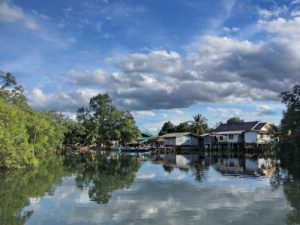
Fennell described it as such: “Ecotourism is a sustainable form of natural resource-based tourism that focuses primarily on experiencing and learning about nature, and which is ethically managed to be low-impact, non-consumptive, and locally-oriented. It typically occurs in natural areas, and should contribute to the conservation or preservation of such areas” (Fennell, 1999: 43. Ecotourism: An Introduction ).
The Mohonk Agreement (2000) , a proposal for international certification of Sustainable Tourism and Ecotourism, saw ecotourism as “sustainable tourism with a natural area focus, which benefits the environment and communities visited, and fosters environmental and cultural understanding, appreciation, and awareness.”
The ecotourism definition by the Global Ecotourism Network (GEN) : “Ecotourism is responsible travel to natural areas that conserves the environment, sustains the well-being of the local people, and creates knowledge and understanding through interpretation and education of all involved (visitors, staff and the visited).”
Definitions of Responsible Travel
Responsible Travel refers to the behavior of individual travelers aspiring to make choices according to sustainable tourism practices. The behaviors usually align with minimizing the negative impacts and maximizing positive ones when one visits a tourism destination.
Travelers that want to learn more about how to be a responsible traveler can visit the section on the GSTC website For Travelers .
Summary of the difference between Sustainable Tourism, Ecotourism, and Responsible Travel
Ecotourism is a niche segment of tourism in natural areas.
Sustainable Tourism does not refer to a specific type of tourism, rather it is an aspiration for the impacts of all forms of tourism to be sustainable for generations to come.
Responsible Travel is a term referring to the behavior and style of individual travelers. The behaviors align with making a positive impact to the destination rather than negative ones.
Sustainable Tourism and the GSTC Criteria

They are the result of a worldwide effort to develop a common language about sustainability in tourism. They are categorized in four pillars: (A) Sustainable management; (B) Socioeconomic impacts; (C) Cultural impacts; (D) Environmental impacts.
These standards were built on decades of prior work from industry experts around the globe. During the process of development, they were widely consulted in both developed and developing countries. They reflect our goal in attaining a global consensus on sustainable tourism.
The process of developing the Criteria was designed to adhere to the standards-setting code of the ISEAL Alliance. The ISEAL Alliance is the international body providing guidance for the management of sustainability standards in all sectors. That code is informed by relevant ISO standards .
Finally, the GSTC Criteria are the starting goals that businesses, governments, and destinations should achieve. Tourism destinations each have their own culture, environment, customs, and laws. Therefore, the Criteria are designed to be adapted to local conditions and supplemented by additional criteria for the specific location and activity.
There are three sets of Criteria
- GSTC Industry Criteria = relates to the sustainable management of private sector travel industry, focusing currently on Hotels and Tour Operators.
- GSTC Destination Criteria = relates to sustainable management of Tourism Destinations.
- GSTC MICE Criteria = relates to sustainable management of Venues, Event Organizers and Events & Exhibitions.
Learn more about Sustainable Tourism
Reading one article is not enough. The GSTC website offers those interested in learning more about sustainable tourism the needed resources. Make sure you visit the relevant pages for you:
- For Hotels & Accommodations
- For Tour Operators
- For Governments & Destinations
- For Corporate and Business Travel
You can also join one of the regular GSTC courses:
- Want to gain in-depth knowledge of the GSTC Criteria and understand sustainable tourism? The GSTC Sustainable Tourism course is for you.
- Engaged with corporate and business travel? The GSTC Sustainable Business Travel course is for you.
- Are you a hotelier or work in the hospitality sector? GSTC Sustainable Hotel course
GSTC Sustainable Tourism Training Schedule
✓ Gain in-depth knowledge of the GSTC Criteria, the global standard for sustainability in travel and tourism. ✓ Make informed decisions on how to implement sustainability practices for your company or destination. ✓ Get ready for developing viable and actionable sustainable tourism policies and practices for your organization
I’ve participated in the course to get a comprehensive overview of destination sustainability criteria. Much more than this, the course gave me the up-to-date analysis of current trends, and a huge number of relevant cases from the destinations, the industry networks and the service providers. I strongly recommend to attend the course.

My course facilitator and teacher (Ayako and Antje) went above and beyond to answer our questions and provide us with additional resources. The course content (the GSTC Criteria) was delivered in an understandable and organized way. Learning the GSTC Criteria and how it applies to our own projects, businesses, and destinations is integral to anyone wanting to do any kind of work in the future centered around travel. I appreciated that the course was delivered in an interactive way over Zoom, and not just something we watched on YouTube. For me, being able to interact with fellow students from around the world, was a big plus. Was well worth it, and I highly recommend the course!

This course has been very relevant and provides in-depth knowledge of GSTC criteria for sustainable practices for destinations as well as the travel industry [with] plenty of real life examples and share links to plenty of reading material throughout the course. … As we move forward during these difficult COVID times, learning our lessons on the damage to nature, it becomes all the more important for industry professionals to get trained and step up efforts to embrace sustainability in all aspects of tourism. Hence, I recommend this course to all industry professionals.

This course enables participants to connect with the GSTC team directly, over an easy to use platform and network around the world. Using real life examples and detail in each of the 4 sections of the GSTC.

The GSTC training was a great way to connect, network, and engage in mind-broadening and eye-opening discussions with others in the diverse field of sustainable tourism. I would highly recommend this as a starting point for anyone interested in the journey of regenerative and sustainable tourism.

The course was great and the on- the-go discussions added great value to keep abreast of trends from across the globe. Participants from various parts of the world brought in their experiences and made the course very interesting.

Hearing about actual destinations applying Sustainable Tourism initiatives and learning from real situations practicing Sustainable Tourism, as well as the related successes and challenges, was very informative and valuable. My favorite part was the unexpected camaraderie from and connections with the other participants. I genuinely enjoyed the online discussion, sharing of ideas, and breakout groups and, overall, meeting so many others who she a passion for Sustainable Tourism. Thank you, GSTC, for a great course!

A complete holistic approach to sustainable tourism. The comprehensive lessons given each week break down the GSTC Criteria and are paired with practical examples, international experts and ‘hands on’ online workshops. The opportunity to discuss and share insights from all the participants around the world not only contributes to my own knowledge but to also my professional network. I highly recommend this course for anyone discovering sustainable tourism.

The course is quick and handy way to immerse in the issues of Sustainability in Tourism and a great kick start in starting your own business or destination program. I could have had the course even longer and especially the live sessions were great to get to know some of the other participants and share their knowledge and experiences – best practices are the best way to get started and to get valuable information. Highly recommended!

The course was so informative and presented in an engaging & interesting way. The examples & speakers gave us a lot to think about and many tangible ways that we can make a difference in our travel business. Thank you!

This course has given me an approach to the GSTC Criteria, where the basic and complete structure to move forward on sustainable paths is visualized. The reflections generated through real examples, discussions and available material are key to better internalize what sustainability means. Ideas applicable to our business and our work area appear during the course that contribute positively to one’s reality. I will recommend this course, for its contribution to the objective, honest and constructive understanding of what sustainability is.

I can only highly recommend the course for every travel and tourism professional- it is a great motivational boost to get into action and helps me support destinations in bringing the idea of destination stewardship – an inclusive and holistic approach – alive. We do not need more and more tourists, we need sustainable tourism.

Taking the GSTC training at this point in time was extremely valuable. It gave me a sustainable tourism framework to help assess what I’ve been able to accomplish and also consider the role that sustainable experiential travel may mean as we begin to inch our way out of the world of zero tourism towards something likely new and different. One other great benefit of the training was starting to get acquainted and sharing with other participants and instructors from around the globe. These connections will be valuable for a very long time to come.

I found this online course well structured and enjoyable. The trainers are really inspiring, extremely knowledgeable about the field and very supportive. The live online sessions give a great introduction to key topics, and there are online lessons, discussion forums and reference material to deepen knowledge. I feel like I have access to so much wisdom, and it is great to be part of a global community of sustainable tourism practitioners.

Thank you GSTC for such a great course. The content was relevant, the case studies were inspiring and the course structure was spot on! I can’t wait to take my learnings and inspiration and activate it across regional destinations in Australia. Keep up the great work.

What I liked the most about this course is the well-defined structure, the opinion sharing with online classmates, and the up-to-date topics. It makes the experience much more effective and enjoyable.

Excellent course that sets the foundations for sustainable tourism practice.I was very new with sustainable tourism and now after the course I have very solid understanding and skills to apply to my job. In addition, the amazing network of professionals sharing ideas is another great tool!

This course provided me with a thorough understanding of how to implement sustainable travel practices. I will definitely integrate information from this training into my work with travel organizations and destinations to help them achieve short-term progress through a long-term strategy.

The GSTC training provides a comprehensive overview of key indicators for a holistic view of sustainable tourism. The training provided an excellent opportunity to network with other tourism professionals, and to share ideas, develop plans, and comment on sustainable tourism initiatives that are being implemented in a diverse array of locations globally. I’m grateful for the connections that I made and for the helpful feedback on ideas for improving sustainability in several operations.

Useful and inspiring! The way the course is organised with lots of practical experience from colleagues in the tourism sector is indeed the most useful and interesting part of the course, [making it easier] to approach the GSTC criteria.

The GSTC course was really great to me because it gave me an in-depth knowledge about sustainable tourism. The combination of the criteria explanation and the presentation from other experts was really great, as it gave us the know-how, lots of samples and case studies. Before joining this course, I had heard about the term sustainable tourism many times, but [was not sure] what it is all about and how we can achieve it. I am glad to have gained the bigger picture of sustainable tourism. I’m developing my village to be a community based tourism destination, and now I can adopt and apply the standard locally.

A great training program that gives the participants a thorough understanding on the sustainable management of both destinations and individual businesses. Anyone from the industry – from the business or the government side – should understand the bigger picture of the destination level management as well as the industrial level so that both public and private sectors can work together for a more sustainable tourism industry.

The GSTC Sustainable Tourism Training Program provided an up-to-date perspective and holistic approach on the topic. I really enjoyed taking part in the group discussions and hearing about the realities of other destinations and their challenges.

I think the training was very useful and gave me many insights that I will use in my daily work to develop more sustainable tourism. The training class was also a good group for networking.

The Global Sustainable Tourism Council (GSTC) is the most widely recognized institution for offering sustainability courses for tourism professionals.

This is a one-of-a-kind course that provides the tools in getting you started. Not to mention, you’re also collaborating with people and organizations across the globe facing similar challenges. The feedback from fellow students was invaluable and honestly, what better way to tackle some big challenges related to the environment than with people from different countries and backgrounds. I’d take this course again just for those connections!

The [GSTC course] has been a remarkable learning experience and a great introduction to sustainable tourism. The combination of online resources, discussion forums, weekly live events with guest presenters provides a deeper understanding and useful tools in sustainable tourism. The trainers have incredible expertise in both tourism and sustainability and share their knowledge and passion about current sustainability practices. I would highly recommend this course to everyone involved in the tourism industry or have a interest in sustainable tourism.

An excellent programme run by well qualified professional staff and trainers. The guest speakers were world class and materials industry leading. A definite must for any tourism professional who is serious about making sustainable impacts for the betterment of our industry.

Amazing learning experience. Exceeded my expectations by far. Excellently organized and facilitated. Great dynamics in discussions with course participants – so much to learn from. Highly valuable best practices and interactive modules really made the best learning experience I had until now! It really motivated and inspired me to continue on the road of global sustainable tourism.

The GSTC Sustainable Tourism Training gave me the tools and network to be able to work for a more sustainable tourism sector in the area where I’m based (South Sweden). The structure with the four principles makes it easy to follow and to discuss also outside the GSTC world. The examples from the other participants were great, and we will continue sharing good and bad examples from destinations all over the world.

To work on sustainability is a never-ending story and can be overwhelming at times. The GSTC training supports a structured approach toward continuous improvement. It provides applicable tools to evaluate our sustainability performance and guidance for setting long-term strategies. It allows you to break down this massive task into achievable working packages.

The GSTC training was a great first touch point for me into the world of sustainable tourism and destination management. I loved hearing case studies from around the world and real life examples on how the GSTC criteria can make a difference. The course has enabled me to start building on these criteria within my job.

The training has enable me to go through all the GSTC Criteria thoroughly with better knowledge of sustainable tourism standard and practices. It will be useful as basic guidelines for the Foundation to use these Criteria, as the destination wants to embark in becoming a sustainable tourism destination, aiming to become GSTC-Certified.

I would definitely recommend GSTC training to absolutely everyone in the tourism industry. The entire [GSTC] framework is extremely useful and important – a framework of values and ideas that is evolving, and that is meant for us a roadmap to make things better for people and companies that may be starting from different points in the journey towards sustainability.

The quality of this training was really first class; materials, presentations, trainer support, resources and discussions. The forum helped keep everything relevant and up to date, and I also liked the format of the live events. All guest presenters were excellent; I liked that they were sharing real life experiences and not just theoretical examples. From each and every live presentation I gained ideas, reinforcements to my own experiences and enthusiasm for what I and my colleagues are doing in our own part of the world.

The STTP programme has been a good introduction to the principles of sustainable tourism. It was a good mix of presentations and cases of sustainable tourism in real-life, insights from experts from various countries and across tourism sectors and explanation of key GSTC criteria. Participants were encouraged to share their experiences and observations through discussion forums and presentations, which made the sessions more lively. The final exam is recommended for those who wish to test their ability to put these principles to practice. I highly recommend this course to tourism industry professionals wishing to incorporate sustainable tourism management at work.

The GSTC training provided me with a deep understanding of the criteria. My fellow classmates were industry experts in various sectors from around the world, bringing the criteria to life with valuable examples/discussions of how they have implemented the very practices we were learning.

My first impression was the organization, it was perfect regarding the admin efforts and the learning tools. The course materials were really useful, as well as the live sessions from which I gained a deep understanding and experience from the other participants. I really want to have the chance to thank all the team who was involved, and of course I would recommend people working in the tourism industry to join this course

The training gave me a clear understanding of the challenges we face and the actions to take to make sustainability effective, [covering] each of the main areas in a systematic way with enough technical detail for those who needed it, without losing the less technical trainees (like myself) who needed to understand the broad overview of sustainable tourism practices

The overview of standards, coupled with best practice and real world examples has been very beneficial for my work in destination management and responsible tourism development. The ability to meet likeminded industry colleagues, who are working in this arena was also highly valuable.

Share This Story, Choose Your Platform!
Related posts.
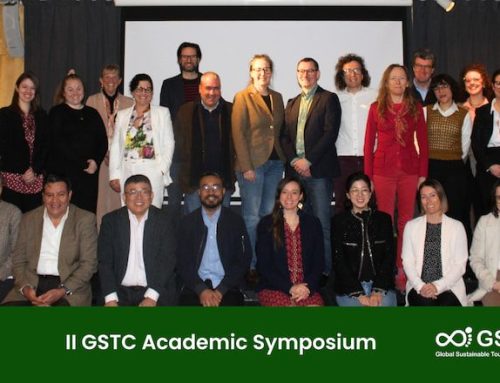
II GSTC Academic Symposium concluded successfully
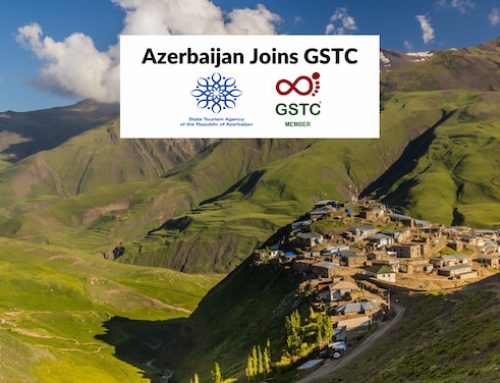
Azerbaijan joins and signs MOU with GSTC

Preferred by Nature Standard gains GSTC-Recognized Standard Status

- New? Start Here
- Try For Free
Sustainable Tourism: What It Is & Why It Matters

The more we learn about this big beautiful planet, the more we learn how to protect it from climate change and other impactful environmental events.
Sustainable tourism takes into account current and future economic, social, and environmental impacts. There are many ways to become more sustainably conscious when we travel, from choosing eco-friendly lodging and booking eco-friendly tours to renting hybrid cars (or booking a zero-waste adventure ).
The benefits of sustainable tourism are endless and we’ve created a guide to help you understand what it is and why it matters.
What is sustainable tourism?

Sustainable tourism, or ecotourism, is a form of tourism that takes full account of its current and future economic, social, and environmental impacts, addressing the needs of visitors, the industry, the environment, and host communities. This includes general location, local transportation, accommodation, activities, food, and shopping.
Why is sustainable tourism so important?
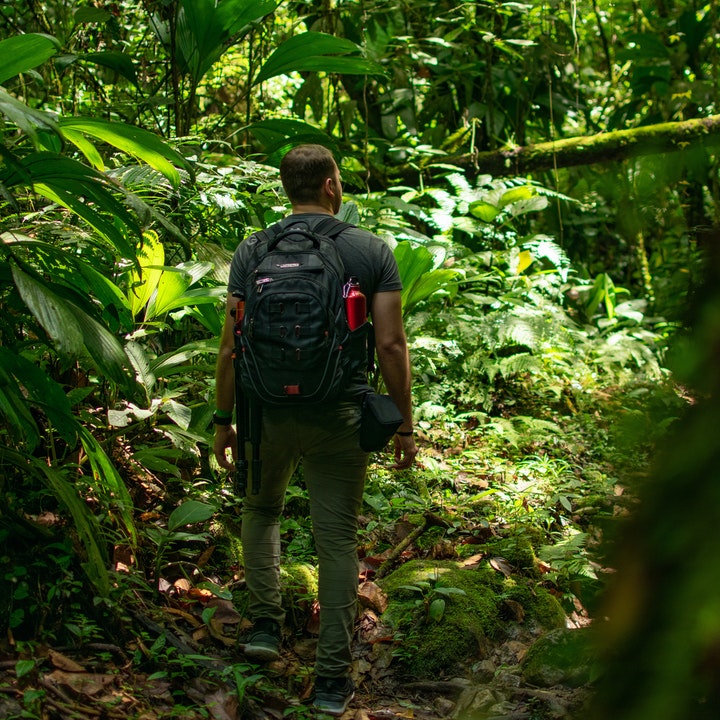
The goal of sustainable tourism is to transform each aspect of the travel industry so that each has a better impact on our world and leaves less of a footprint. This is important because we want to ensure all the lovely things that make up our sense of wanderlust now, can survive and flourish well into the future, for the future travellers and travel junkies. 😉
What is the UNWTO?
The World Tourism Organization is the United Nations agency responsible for the promotion of responsible, sustainable, and universally accessible tourism. In addition, UNWTO emphasizes the Global Code of Ethics for Tourism , “to maximize tourism’s socio-economic contribution while minimizing its possible negative impacts, and is committed to promoting tourism as an instrument in achieving the Sustainable Development Goals, geared towards reducing poverty and fostering sustainable development worldwide,” according to the site.
There are 17 Sustainable Development Goals from the UNWTO that are meant to be a “blueprint to achieve a better and more sustainable future for all”:
• No Poverty
• Zero Hunger
• Good Health and Well-being
• Quality Education
• Gender Equality
• Clean Water and Sanitation
• Affordable and Clean Energy
• Decent Work and Economic Growth
• Industry, Innovation and Infrastructure
• Reducing Inequality
• Sustainable Cities and Communities
• Responsible Consumption and Production
• Climate Action
• Life Below Water
• Life On Land
• Peace, Justice, and Strong Institutions
• Partnerships for the Goals
What are sustainable tourism best practices?
There is a multitude of ways for us to become more sustainably conscious travellers. For you, this could mean booking a green hotel or with an airline that flies newer planes that use less fuel, while for another traveller it could mean booking a carbon-neutral cruise in the Galapagos Islands or working with a nonprofit to improve the rights of rural people, which goes hand-in-hand with improving our planet’s health.
If you’re looking to make any kind of impact, big or small, take a look at our guidelines below.
Stay informed

Stay connected within the eco travel, sustainability, and sustainable tourism spheres. Read the news regarding airlines, major hotel lines, etc. Stay informed on what options are out there, and then make a decision on which you’d like to book or where you can contribute.
Book greener options

Airlines: Did you know that Delta Airlines’ goal is to become the first carbon-neutral airline in the world? The airline is committing $1 billion to the fight against global warming over the next decade. Other airlines making efforts to combat global warming include Alaska Airlines, American Airlines, United Airlines, JetBlue, Southwest Airlines, Etihad Airways, and others.
Green Hotels: Green hotels focus on sustainability, are often built from sustainable materials and aim to leave no carbon footprint. Green Lodging News, Design Hotels, Element Hotels, Five-Leaf System, GreenGlobe, and Green Hotels are good resources to learn more about green hotels.
Check out Camp Glenorchy, New Zealand’s first net-zero energy accommodation, or Pikaia Lodge, a carbon-neutral property that uses alternative energy resources in Ecuador.
Nonprofits: Check out nonprofit organizations working towards building a better tourism industry like Ethical Traveler, Sustainable Travel International, The International Ecotourism Society, The Nature Conservancy, The Rainforest Alliance, and others.
Tours: One step towards building a more sustainable vacation is to book tours that are more eco-friendly. Check out these operators: Adventures Within Reach, Country Walkers, Context Travel, Blue Ventures, Backroads, and others.
Support companies with carbon offsets

Donate to certain companies to offset the carbon output from your flights. Companies like Carbonfund, TerraPass, Cool Climate Network, the Conservation Fund funnel the donations into programs that help to offset the carbon output from airplanes, for instance, by planting trees.
Opt for public transportation, walking, or biking

A simple way to decrease your personal carbon footprint while at home or abroad, is to opt for public transportation, walking, or biking as often as possible, vs. rideshares or renting a car. Trains are the most efficient option and emit the least amount of carbon into the atmosphere. If you must rent a car, opt for a hybrid car.
Eat and drink local

When you eat and drink local or farm-to-table, these meals have less of a carbon impact than eating or drinking food that may be imported. Now is the time to enjoy farm-to-table meals and getting to know the locals .
Pack eco-friendly items

When you pack for your next trip, pack light and try to pack only essential items. Try to pack as many reusable items as you can (like a water bottle or grocery bag), this way you are not contributing waste while you’re abroad or while you’re at home.
Psst! Remember when Patagonia turned plastic bottles into travel bags ?!
Follow our guide to remain a responsible traveler

With these 11 proven ways to become a more responsible traveler, you are impacting the world in more ways than one. Respecting the locals and their culture is a huge part of being a responsible traveler.
In addition, you can contribute to and support ethical organizations around the world that are fighting for human rights in rural areas. Many fair trade items like chocolate and coffee involve human rights abuses like child labor, forced labor, poor working conditions, gender inequality, and the violation of Indigenous land rights.
When people are treated properly, they can maintain their land and environment the best, which will keep the world healthy for years to come.
Implement your best sustainability practices just like at home

Reduce, reuse, recycle. Conserve water when you can. Save electricity. Throw away your trash and pick up after others if you’re comfortable. Just because you are away from home, doesn’t mean you should throw these important habits away.
Now that you’ve seen our guide to sustainable tourism, what did you think? Which strategies will you start to implement? Leave us a comment below!
Leave a Reply Cancel reply
Your email address will not be published. Required fields are marked *
Save my name, email, and website in this browser for the next time I comment.
Related Posts:

Advertiser Disclosure
This site is part of an affiliate sales network and receives compensation for sending traffic to partner sites, such as CreditCards.com. This compensation may impact how and where links appear on this site. This site does not include all financial companies or all available financial offers. We appreciate your support!
Editorial Note: Opinions expressed here are the author’s alone, not those of any bank, credit card issuer, airlines or hotel chain, and have not been reviewed, approved or otherwise endorsed by any of these entities.

Travel Tips, Tricks, & Hacks — Straight To Your Inbox
No spam, only the goods. And we would never share your info with anyone.
- Bucket List
- Travel Tips
- Remote Work
- Gift Guides
Most Popular Stories

11 Proven Ways To Be A Responsible Traveler
We want to be responsible adults, responsible citizens, but what about responsible travelers? Are there things we can do that protect us and those around

7 Literary Cities for the Book Lover
We read books to learn new skills, understand our world better, and get lost in the incredible stories of authors from all walks of life.

14 Tips for Anyone Traveling Alone
In these challenging times, our schedules are out of whack and we are itching to explore. You may find that significant others and close friends

13 Unique Gift Ideas For Father’s Day
Our fathers hold a special place in our hearts. Whether you’re able to spend this Father’s Day with yours or not, we hope to help
Travel More, Remember Better.
- Journo Travel Journal
- Currency Converter
- Become An Insider
- Digital Nomad Secrets
- Remote Work Wealth Club
- Travel Hacker's Toolkit
- Travel Fund Challenge
- Insider Adventures
- Shop Travel Goods
- TERMS & CONDITIONS
- PRIVACY POLICY
- Brochure Download
Exploring sustainable tourism: What you need to know

In a world where environmental concerns and ethical considerations are at the forefront of our global consciousness, sustainable tourism has emerged as a pivotal force for change within the travel industry. Beyond the allure of exotic destinations and thrilling adventures, travelers and businesses alike are increasingly seeking ways of minimizing their environmental impact on the planet while maximizing positive contributions to local communities.
If you want to work in the hospitality industry, there is great potential for encouraging eco-friendly change. In this article, we’ll look at what sustainable tourism is and the steps hospitality is taking towards it.
What is sustainable tourism?
Sustainable tourism involves travel that preserves nature, supports local cultures and contributes to the community. It doesn’t curtail exciting experiences or prevent companies from providing a great hospitality experience , but it encourages mindful exploration that respects the destination and its traditions while reducing the environmental footprint of travel.
What is the goal of sustainable tourism?
Sustainable tourism aims to harmonize tourism development, environmental protection and community development. Its primary goals include addressing sustainability by preserving resources through activities that uphold natural and cultural heritage while minimizing negative impacts. This approach ensures future generations can continue to enjoy destinations and cultures by fostering positive interactions between tourists and locals and conserving customs.
Sustainable tourism also generates economic gains for all stakeholders, making a tangible impact on local economies. It’s a pragmatic approach to achieve a harmonious balance between tourism satisfaction, community welfare, entrepreneurial growth and environmental health, making ‘sustainable travel’ not just a phrase but a conscious choice with lasting effects.
Learn how to make an impact and create a more sustainable future in tourism through industry expert tuition and exclusive professional placements.

What is the difference between responsible and sustainable tourism?
Responsible tourism focuses on travelers’ behaviors and attitudes towards the destination, promoting respectful interactions with locals and the environment.
Sustainable tourism goes beyond individual actions, addressing industry issues such as economic viability, social equity and environmental protection and requires collaboration among travelers, businesses and governments.
Both have great importance in tourism management . As an example, reusing towels reflects responsible travel behavior, while reducing a hotel’s total water consumption through recycling systems demonstrates a sustainable approach.
Both ideas are interconnected but distinct, contributing to better travel experiences for tourists, communities and the environment.
Understanding these terms can increase consciousness of global resource use and lead to eco-conscious vacations that still embrace rich experiences and exciting exploration. It’s a balance between adventure and responsibility, shaping respect for humanity and nature.

Sustainable tourism includes a range of options catering to diverse interests. Some travelers are attracted by nature offers in ecotourism, while others immerse themselves in community life and rural or ethno-tourism (see below). With some types of sustainable tourism such as ‘soft tourism’, all can benefit from a more mindful approach towards their surroundings while still enjoying excellent customer service .
This prioritizes responsible travel interaction with nature, focusing on biodiversity-rich places such as rainforests or marine parks. Activities including guided treks and supervised snorkeling ensure enjoyment without harming ecosystems.
Community tourism
Tourists engage in local events, contributing to socio-economic growth and cultural exchange. Staying in local accommodation and participating respectfully in traditions support the community and enrich travel experiences.
Rural/ethno tourism:
This immersive style of tourism often involves stays in remote settlements and enjoying rustic living. Activities such as food gathering and hiking offer insights into rural life, fostering connections between travelers and locals.
Soft tourism
This emphasizes light-footprint travel to reduce impact and supports conservation projects. Tourist flow can be developed through off-seasons via clever marketing to relieve pressure on resources in high seasons.
What are the advantages of sustainable tourism?
Sustainable tourism offers many benefits for tourists, local communities and natural environments. Below, we examine five primary advantages that highlight why sustainable use of natural resources is important in tourism.
Looks out for wildlife
Sustainable tourism can include a focus on minimizing negative effects on animals and their habitats. This ensures their well-being and also supports environmental conservation efforts, leading to less pollution, preventing introduction of invasive species and reducing environmental damage. For nature lovers, choosing sustainable tourism is a responsible and ethical option.
Protects the environment
By choosing sustainable travel, we can actively contribute to protecting our environment and preserving our planet’s natural beauty and balance. Sustainable travel helps combat issues such as deforestation, pollution and erosion and supports biodiversity conservation. This ensures future generations can continue to appreciate and enjoy these natural resources.
Supports local people
Sustainable tourism brings economic benefits to local communities, promoting inclusivity and cultural exchange. Top hotel brands can also make responsible contributions to the community by respecting local heritage, conserving resources and creating employment.
Attitude shift
Vacations that prioritize ethical practices have a powerful impact on both travelers and local communities. These experiences raise awareness about environmental stewardship and encourage positive changes in behavior and lifestyle choices that favor sustainability.
Long-term focus
Sustainable tourism aims for ecological balance and socio-economic equity. It seeks to ensure present enjoyment does not come at the expense of future depletion, meaning green tourism must be a long-term commitment for tourists and hospitality professionals.
Examples of sustainable tourism
Sustainable tourism means more than just reducing your carbon footprint or recycling waste. It permeates every aspect of travel, from where you stay to how you get there. Let’s dive into nine examples of sustainable tourism that embody this principle.
Feynan Ecolodge – Jordan
With a strong emphasis on local community involvement and environmental protection, Feynan Ecolodge in Jordan stands out as one of the strongest examples of sustainable traveling. The lodge itself runs predominantly off solar power and has a zero waste policy to ensure further sustainability. This approach is similar to the sustainable tourism model encouraged by many national parks throughout the world.
Sustainable tourism in Bhutan
Bhutan has implemented an innovative ‘high value-low impact’ method of managing tourists. The nation focuses on attracting travelers who respect the cultural values and national heritage, promoting a meaningful experience for visitors without compromising the country’s pristine environment.
Luxury sustainable safari tours
Safaris where high-end tourism is used to fund the conservation of wildlife. By championing eco-conscious travel practices and supporting anti-poaching initiatives, they pave the way for responsible interaction with Africa’s precious animals while enhancing tourists’ understanding of why ecotourism is important. This fusion of luxury and sustainability offers an exclusive experience and also contributes to preservation of the natural world. Such tours are frequently promoted through luxury marketing , where exceptional experiences are promoted alongside conservation efforts.
Sustainable hostel in South Africa
South Africa’s Once in Cape Town hostel sets an enviable standard among hostels worldwide with its strict adherence to green practices such as efficient energy usage, recycling and promotion of low-carbon transportation methods.
Sustainable transport on the Water
Water-based transport means such as gondolas don’t usually spring to mind when considering sustainable tourism examples, but they are an ideal representation of non-motorised natural resource use. Their operation leaves ecosystems intact while producing neither carbon emissions nor noise pollution.
Solar Driven Six Senses Resort in Fiji
Fiji’s Six Senses Resort, where all operations run solely on solar power, is the very definition of sustainability in the hospitality industry sector. From planting coral gardens to growing organic produce, this resort captures the essence of sustainability while remaining luxurious.
BomBom Water Project – Príncipe
Management of water sanitation forms part of sustainable development goals set by the United Nations and this is something the BomBom Island resort off Africa’s coast takes seriously. To that end, it has implemented a desalination project that is a prime example of sustainability in tourism.
Atlantis Submarines – Hawaii
Underwater exploration without damaging marine environments. The significant educational value coupled with environmental consciousness makes Atlantis Submarines a great example of ecotourism that benefits people in multiple ways.
Self-sustainable Azurmendi restaurant – Spain
A glowing example of responsible dining in the heart of Basque Spain, Azurmendi is all about sustainability in gastronomy. The staff grow organic food powered by renewable energy and reuse water.
Master the nuances of luxury tourism with guidance from leaders in the field and gain exclusive access to influential networks and internships on our master’s program.

Key trends in the tourism industry
Thriving in this industry means being able to adapt to change. Four current trends reshaping the sector are:
- Growing environmental awareness is driving a preference for sustainable travel, as tourists prioritize eco-friendly experiences to reduce their carbon footprint
- ‘Slow travel’ values immersion in local cultures over hurried itineraries, emphasizing meaningful experiences
- The industry is promoting sustainability, with accommodation and operators proudly displaying eco-credentials to address tourists’ environmental concerns
- Advances in technology enable travelers to access information for informed decisions on sustainable destinations
These developments are shaping sustainability and also guiding consumers and providers to contribute to it. They prioritize mutually beneficial outcomes, making travel enjoyable while conserving natural resources.
Find courses in sustainable tourism
For a better grasp of sustainable tourism, you can explore hospitality studies that have an emphasis on sustainability. Not all courses will cover ecotourism, so it’s important to find one that meets your needs. Look for schools that help you find professional internships, which help you gain first-hand experience of what it’s like to shape the future of hospitality and can give you new ideas about sustainable travel. They will also enable you to keep up to date with current trends and upcoming changes in the industry, which is vital when you are working at the cutting edge of ecotourism.
Champion sustainable tourism and develop your leadership potential with a degree from one of the world’s most progressive hospitality schools.

Find jobs in sustainable tourism
Sustainable tourism is a growing sector in the industry, offering great hotel management careers for those passionate about travel and preserving the planet. Here are some of the ways you can turn your commitment to sustainability into a fulfilling career:
- Work with eco-friendly companies such as Ecoventures, known for their low-impact operations and community engagement. They embody sustainable values at every level
- Open your own eco-friendly tourism business. If you have an entrepreneurial streak, opening your own eco-hotel can be a great option
- Explore roles in destination marketing that prioritize preserving destinations over massive profits, contributing to constructive change
- Consider academia or consultancy, where you can shape policy by teaching or advising on sustainable tourism
Various other jobs also cater to diverse interests, from ecotourism guides to responsible cultural exchange planner. Each role contributes to the shared goal of respectful and enjoyable leisure travel, and there are many management positions where you can help guide hospitality venues towards greener futures.
Understanding sustainable tourism is crucial because it’s not just a passing trend but a necessary move to reduce the environmental cost of travel. Responsible tourism benefits the environment, local communities and intercultural exchange. Sustainable travel goes beyond experiences, mitigating the negative impact of tourism while appreciating diverse cultures. Industry trends show a shift towards this model as a significant force for change. If you want to make your mark and forge a career in ecotourism, start your green journey with Les Roches today.
Photo Credit Main Image: Petmal/ iStock via Getty Images
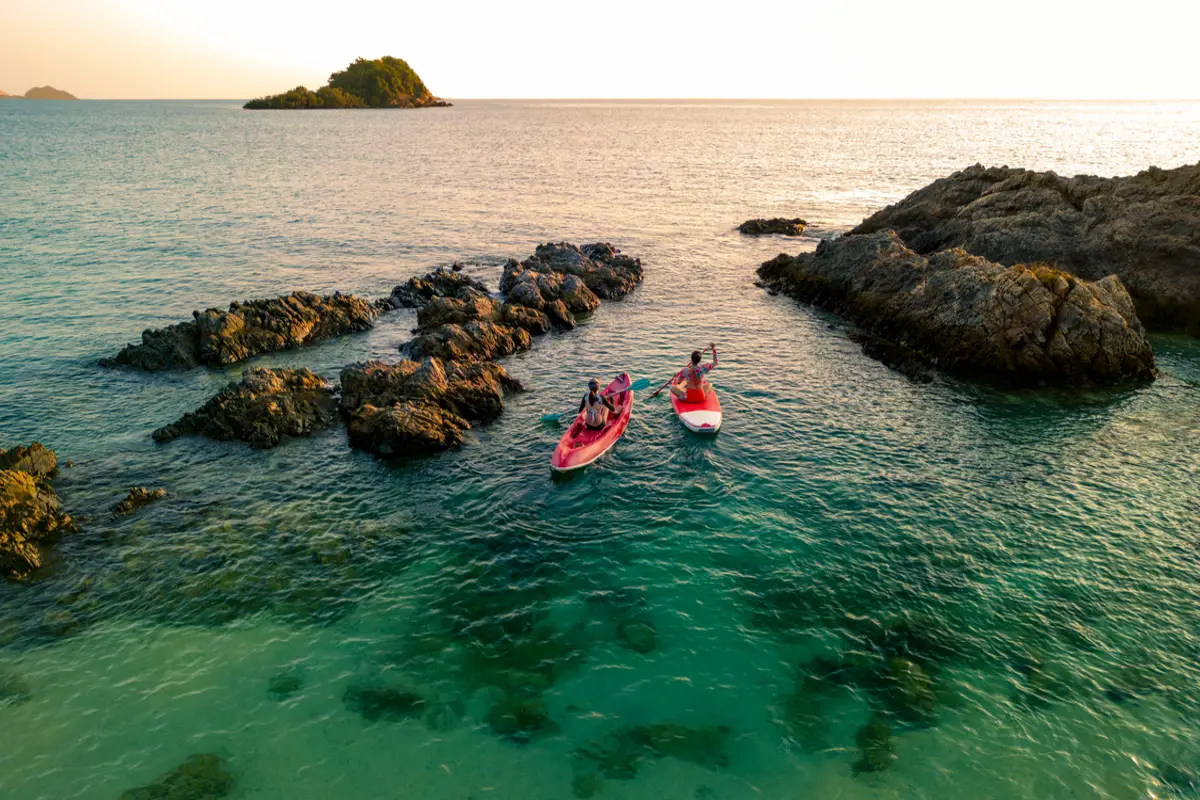
- Industry News
From arranging flights and accommodations to recommending destinations and activities, travel consultants offer valuable expertise and personalized service to meet…

Whether you aspire to become a corporate leader, entrepreneur or industry innovator, obtaining a business degree provides a solid foundation…

A brand is more than just a logo or a product; it’s the essence of what a company stands for…

The global event management industry is a vibrant and evolving sector that attracts a lot of people. This growth is…
Welcome to Les Roches
Privacy overview.
- SOUTH AFRICA
- CENTRAL AMERICA
- ESPIRITO SANTO
- MATO GROSSO DO SUL
- MINAS GERAIS
- RIO DE JANEIRO
- FALKLAND ISLANDS
- SUSTAINABLE TOURISM
- EXCHANGE PROGRAM
- GET INSPIRED
- HEALTH & WELLNESS
- NOMADIC LIVING
- PHOTOGRAPHY
- TRAVEL CLOTHING AND GEAR
- LIVE MORE, TRAVEL MORE
- ABOUT ELAINE
- SERVICES & CONTACT
- COUPONS & DISCOUNTS 💰
Sustainable tourism: what is it and why is it important
Understand what is sustainable tourism, why it is important to create sustainable practices in tourism and meet sustainable destinations around the world..
We love to travel, to visit new places, to meet different people … but have you ever stopped to think about all of the negative impacts that our travels can cause? In this article, we will explain in a simple way the meanings of sustainability and sustainable tourism , the importance of having sustainable practices in our trips, and we will also be mentioning destinations with good sustainable tourism practices around the world .
Table of contents
The 3 pillars of sustainability, what is sustainable tourism, why is sustainable tourism important, examples of sustainable tourism around the world, sustainable travel in brazil, how sustainable tourism came into my life, what is sustainability.
To better understand what sustainable tourism means , let’s first understand what is sustainability .
In 1987, the United Nations Brundtland Commission defined sustainability as:
“meeting the needs of the present without compromising the ability of future generations to meet their own needs.”
Currently, when we talk about sustainability, we associate the topic with issues such as deforestation, consumerism, trash in the oceans, endangered animals, etc, and it makes sense since all of them can really compromise the well-being and even the survival of the future generations.
Sustainability has 3 pillars that must be balanced, which are economic , social and environmental .
These pillars were identified during a United Nations (UN) event that took place in 2005.
The balance between these three pillars must be emphasized, as we often forget about it. An example:
Brazil wants to grow the exportation of meat, which is good for the country’s economy. But the consequence of this growth is the increase of negative impacts to the environment and to the communities.
Examples of the negative impacts:
- Increase of greenhouse gases
- Higher consumption of natural resources such as water (did you know that it takes more than 15,000 liters of water to produce 1 kilo of beef?)
- Deforestation and ecosystems compromise
- Higher risk of zoonoses for both people and animals
- Misappropriation of indigenous territories
- and others…
The definition of sustainable tourism according to the World Tourism Organization (WTO) is as follows:
“Tourism that takes full account of its current and future economic, social and environmental impacts, addressing the needs of visitors, the industry, the environment and host communities”
Note how the concept of sustainable tourism ends up being a junction of what is sustainability and its 3 pillars, but adapted for the tourism industry.
According to a 2019 report by the World Travel & Tourism Council , tourism represents more than 10% of the global GDP , so it is an extremely important sector in our economy, which is very good!
However, what will tourism be like in the future if it is done in an unbridled way?
What will happen to local communities if large hotels hire only foreigners? Or if foreign investors exploit the locals with unfair deals and wages?
And as travelers … do we need to put wild animals at risk just because we want a selfie with them? Are we handing our hard-earned money to responsible companies ? Or are our trips funding environmental and social crimes?
Do we want wonderful destinations like Maya Bay in Thailand to be closed due to the damage caused by the lack of planning and the lack of awareness of travelers? Would we like to find trash on paradise islands during our dreamed vacation?
Creating sustainable practices in our travels is as important as creating sustainable habits in our day-to-day lives, at home, at work, or anywhere else.
After all, when we talk about sustainability, we involve all living beings on the planet into the discussion.
Some countries around the world have been putting a lot of effort to become a more sustainable destination.
In my opinion Bhutan , is the best example. Did you know that Bhutan is the only country in the world considered carbon negative ? This means that the purity of its forests produces more oxygen than the country emits gases =)
Tourism in Bhutan is well controlled, in addition to requiring a visa, a daily fee of USD 200 to USD 250 is charged, which already includes a minimum of a 3-star hotel, tour, and meals. Much of this fee goes to environment preservation and social development projects.
Other examples of sustainable destinations in the world are:
- Costa Rica : Costa Rica has 25% of its territory protected and is one of the leaders in sustainable tourism practices in the world. There they have a program called Certification for Sustainable Tourism (CST) that certifies hotels and tour operators that follow their recommendations.
- Monaco : With 100% green energy, shared electric vehicles and bicycles, Monaco has been running a campaign called “Green is the new glam”.
- Jordan : The tourism is Jordan’s main source of income, and to help to grow the local economy, the accommodations prefer to use local products such as bed sheets and towels.
A more complete list would include more countries such as New Zealand , Norway , Seychelles and others.
Brazil also has destinations with excellent sustainable initiatives. Among them are:
Bonito (MS) : Bonito strictly controls the number of tourists who participate in each tour.
Socorro (SP) : Accessibility is also taken into consideration when we talk about sustainable tourism, and Socorro has attractions and accommodations that bring inclusion in tourism to people with disabilities or special needs.
Find out the importance of Accessible Travel !
Fernando de Noronha (PE) : Noronha strictly controls the number of visitors it receives and has programs to end the use of plastic on the island and reduce carbon emissions to zero by 2030.
Morretes (PR) : Ekôa Park in Morretes is an example of attraction with great sustainability practices. The park, located in the Atlantic Forest, offers activities and adventures for all ages, which come with a lot of environmental awareness.
I was not always a responsible traveler , the awareness of the impacts that my travels can have on the environment and society hit my life only in 2018, during a 5-month trip that I took.
Experiences like noticing Bhutan’s respect for nature and its population, witnessing people working in extremely precarious conditions in the largest slum of India, seeing people wearing masks in Kathmandu (Nepal) to protect themselves from pollution, made me rethink my habits and attitudes.
But the key experience that made me decide to learn more about sustainable tourism was when I saw a lot of trash on paradisiacal beaches in the Maldives and I found out that tourism is one of the main responsible for this.
After returning to Brazil, I started to research about the topic and I also started to share what I was learning on my social media.
Today, fighting for this cause is part of my life’s purpose.
How about you? How sustainable tourism came into your life? And what are your questions about it?
- 10 tips for a zero waste travel
- The best practices in wildlife tourism
- 8 responsible tourism tips
- How responsible travelers can help to prevent pandemics
You Might Also Like
Sustainable hotel practices in Yucatan Peninsula
Swim with dolphins: do you know what’s behind swimming with dolphins..., cancel reply, accommodation.
- TRAVEL INSURANCE
AWARD WINNER: SUSTAINABLE TRAVEL BLOGGER
Recent posts.
- Things to do in the Yucatán Peninsula
- 21 Best Mayan Ruins in Mexico
- Things to do in Maraú Peninsula and Barra Grande, Brazil
- Best travel pants for men? Western Rise!
- How much does a trip to the Maldives cost in 2024?
- Top 5 things to do in Oman
- Top 7 must-have outdoor clothing for men
- Bonete Beach, Ilhabela: How to get there, what to do and much more
- Perth, Australia: everything that you must know
- Snow clothes: What you need to know before packing
- Waterproof hiking boots or shoes: Which one is better?
- Top 10 essential travel clothes for men
- Enchanting Jordan: Complete travel guide with curiosities, tips, things to do and NOT to do
- Where to stay in Park City, Utah: Nine best hotels
Posts by Category
- TOURS & TICKETS
- SOUTH AMERICA
- NOMADIC LIFE
- UNITED STATES
- DESTINATIONS
- TRAVEL RESOURCES
- MIDDLE EAST
- NORTH AMERICA
- TRAVEL GEAR
Travel, Tourism & Hospitality
Sustainable tourism worldwide - statistics & facts
What are the effects of global tourism on the climate, traveler awareness of social and environmental responsibility, key insights.
Detailed statistics
Ecotourism market size worldwide 2022-2028
Tourism-related transport's share of carbon emissions worldwide 2016-2030
Global travelers who believe in the importance of green travel 2023
Editor’s Picks Current statistics on this topic
Current statistics on this topic.
Leisure Travel
Global carbon dioxide emissions from energy 1965-2022, by region
Related topics
Recommended.
- Tourism worldwide
- Hotel industry worldwide
- Sustainable tourism in the U.S.
- Sustainable fashion worldwide
Recommended statistics
Industry overview.
- Premium Statistic Ecotourism market size worldwide 2022-2028
- Premium Statistic Global travelers who believe in the importance of green travel 2023
- Premium Statistic Sustainable initiatives travelers would adopt worldwide 2022, by region
- Premium Statistic Conscious travelers' challenges when traveling in a sustainable manner worldwide 2022
Market size of the ecotourism sector worldwide in 2022, with a forecast for 2028 (in billion U.S. dollars)
Share of travelers that believe sustainable travel is important worldwide in 2023
Sustainable initiatives travelers would adopt worldwide 2022, by region
Main sustainable initiatives travelers are willing to adopt worldwide in 2022, by region
Conscious travelers' challenges when traveling in a sustainable manner worldwide 2022
Challenges of travelers when trying to travel in a sustainable and socially conscious manner worldwide as of March 2022
Environmental impact
- Basic Statistic Global carbon dioxide emissions from energy 1965-2022, by region
- Premium Statistic Tourism-related transport's share of carbon emissions worldwide 2016-2030
- Premium Statistic Carbon footprint of tourism-related transport worldwide 2005-2030
- Premium Statistic Carbon footprint of international tourism transport worldwide 2005-2030, by type
- Premium Statistic Carbon footprint of domestic tourism transport worldwide 2005-2030, by type
Carbon dioxide emissions from energy worldwide from 1965 to 2022, by region (in million metric tons of carbon dioxide)
Tourism-related transport's share of carbon emissions worldwide 2016-2030
Share of carbon dioxide emissions coming from tourism-related transport worldwide in 2016, with a forecast for 2030
Carbon footprint of tourism-related transport worldwide 2005-2030
Carbon dioxide emissions from tourism-related transport worldwide in 2005 and 2016, with a forecast for 2030 (in million metric tons of carbon dioxide)
Carbon footprint of international tourism transport worldwide 2005-2030, by type
Transport-related emissions from international tourist arrivals worldwide in 2005 and 2016, with a forecast for 2030, by mode of transport (in million metric tons of carbon dioxide)
Carbon footprint of domestic tourism transport worldwide 2005-2030, by type
Transport-related emissions from domestic tourist arrivals worldwide in 2005 and 2016, with a forecast for 2030 (in million metric tons of carbon dioxide), by mode of transport
International tourism figures
- Premium Statistic Number of international tourist arrivals worldwide 1950-2023
- Basic Statistic Number of international tourist arrivals worldwide 2005-2023, by region
- Premium Statistic Countries with the highest number of inbound tourist arrivals worldwide 2019-2022
- Premium Statistic Global air traffic - number of flights 2004-2024
- Premium Statistic Global air traffic - scheduled passengers 2004-2022
Number of international tourist arrivals worldwide 1950-2023
Number of international tourist arrivals worldwide from 1950 to 2023 (in millions)
Number of international tourist arrivals worldwide 2005-2023, by region
Number of international tourist arrivals worldwide from 2005 to 2023, by region (in millions)
Countries with the highest number of inbound tourist arrivals worldwide 2019-2022
Countries with the highest number of international tourist arrivals worldwide from 2019 to 2022 (in millions)
Global air traffic - number of flights 2004-2024
Number of flights performed by the global airline industry from 2004 to 2023, with a forecasts for 2024 (in millions)
Global air traffic - scheduled passengers 2004-2022
Number of scheduled passengers boarded by the global airline industry from 2004 to 2022 (in millions)
Opinions and behavior
- Premium Statistic Main drivers for visiting a country by people worldwide 2023
- Premium Statistic Share of outbound travelers planning to spend more worldwide 2022, by category
- Premium Statistic Share of global travelers that want to use green lodging in the next year 2016-2022
- Premium Statistic Interest in accommodation with high sustainability standard globally 2023, by country
- Premium Statistic Reasons global travelers stayed in sustainable lodging at least once last year 2022
- Premium Statistic Demand for sustainable hotels by global corporate travel managers 2022
Main drivers for visiting a country by people worldwide 2023
Reasons to visit a country according to respondents worldwide in 2023
Share of outbound travelers planning to spend more worldwide 2022, by category
Share of travelers planning to spend more on trips abroad in selected countries worldwide in 2022, by type of expenditure
Share of global travelers that want to use green lodging in the next year 2016-2022
Distribution of global travelers intending to stay at least once in an eco-friendly or green accommodation when looking at the year ahead from 2016 to 2022
Interest in accommodation with high sustainability standard globally 2023, by country
Share of travelers who look for accommodation with impressive sustainability innovation worldwide as of July 2023, by country
Reasons global travelers stayed in sustainable lodging at least once last year 2022
Main reasons travelers stayed in sustainable accommodation at least once over the past year worldwide in as of February 2022
Demand for sustainable hotels by global corporate travel managers 2022
Importance of hotel sustainability for business travel buyers worldwide as of October 2022
Further reports Get the best reports to understand your industry
Get the best reports to understand your industry.
Mon - Fri, 9am - 6pm (EST)
Mon - Fri, 9am - 5pm (SGT)
Mon - Fri, 10:00am - 6:00pm (JST)
Mon - Fri, 9:30am - 5pm (GMT)
UN Tourism | Bringing the world closer
Share this content.
- Share this article on facebook
- Share this article on twitter
- Share this article on linkedin
UN Tourism and Croatia to Establish Research Centre for Sustainable Tourism
- 12 Apr 2024
UN Tourism is to work with the Government Croatia and the University of Zagreb to establish a research and development centre focused on sustainable tourism.
Croatia currently serves on UN Tourism’s Committee on Tourism and Sustainability, having chaired it between 2019 and 2023. Alongside the Government’s record of promoting responsible and sustainable tourism practices, this clear leadership and support for UN Tourism’s core values make it the ideal location to host a collaborative platform to drive innovation and catalyse positive change in the tourism sector.
Croatia leads by example in growing tourism in a sustainable manner
This landmark centre will engage stakeholders from the public and private sectors, academia, and civil society to will address some of the most critical challenges facing tourism, including:
- Reducing the Environmental Impact of Tourism: The centre will prioritize initiatives to minimize waste generation and plastic usage, thereby mitigating the environmental footprint of tourism activities.
- Increasing Usage of Renewable Energy and Energy Efficiency: By promoting the adoption of renewable energy sources and implementing energy-efficient practices, the centre aims to reduce carbon emissions associated with tourism operations.
- Accelerating Adaptation to Climate Change: Recognizing the urgent need to address climate-related risks, the centre will support adaptation strategies to enhance the resilience of tourism destinations and communities.
- Preserving Social Sustainability and Local Communities: The centre will work to safeguard the cultural heritage and livelihoods of local communities by promoting responsible tourism practices and equitable distribution of benefits.
- Enhancing Evidence-Based Policy Making: Through rigorous research and data analysis, the centre will provide policymakers with the evidence needed to formulate effective policies that balance tourism development with environmental and social considerations.
- Providing Relevant and Updated Research: The centre will serve as a hub for cutting-edge research and knowledge exchange, delivering timely insights and best practices for the sustainable development of tourism.
In Zagreb, the Minister of Tourism and Sport of Croatia Nikolina Brnjac and UN Tourism Secretary-General Zurab Pololikashvili signed a Memorandum of Understanding to create the cutting-edge research institution.
Welcoming the collaboration, Secretary-General Pololikashvili said: “Croatia leads by example in growing tourism in a sustainable manner. The new research centre in Zagreb will contribute to UN Tourism’s commitment to data-driven policymaking at the regional, national and destination level, ensuring tourism grows responsibly and inclusively, for the benefit of communities everywhere.”
Minister of Tourism and Sport of Croatia Nikolina Brnjac adds: “I am proud that UN Tourism, the most relevant tourism organization globally, has recognized our efforts in Croatian tourism management reform and our strong commitment to sustainable tourism and put forward the initiative to create the first UN Tourism Centre for sustainable tourism in Croatia together with the Ministry of Tourism and Sport of the Republic of Croatia. With the University of Zagreb as a partner in the establishment of this Centre, I am convinced that this Centre will be successful and provide very relevant research for future sustainable development of tourism.”
Related Links:
- Download News Release on PDF
- UN Tourism: Regional Department for Europe
- Transforming Tourism for Climate Action
- Sustainable tourism development
Related Content
Un tourism and hotelschool the hague to drive innovatio..., european committee of the regions and un tourism break ..., un tourism launches tourism investment guidelines for a..., un tourism members advance agenda for europe as region ....

Responsible Tourism: Why Sustainable Travel Is Now More Important Than Ever
Sign up for the Morning Brief email newsletter to get weekday updates from The Weather Channel and our meteorologists.
Recently, the UN's Intergovernmental Panel on climate change talked about taking action on an international level to deal with the looming climate crisis. As a result, industries across the board are slowly taking note of the situation and adopting more sustainable policies.
One of the most significant factors behind the climate change crisis is the unmitigated consumption of fossil fuels. But, interestingly, it is not just big businesses that need to implement changes when it comes to fossil fuel consumption. The travel and vacation industry is also to blame for a huge percentage of carbon-emitting fossil fuel consumption. In fact, in 2021, a fact sheet released by the White House claimed that at least 11% of carbon emissions in the U.S. come from air travel. And we, as individual travelers, can do something to change that.
By becoming responsible tourists and adopting sustainable practices, we can reduce our carbon footprint and leave the least possible negative impact on our destination's environment.
What Is Sustainable Tourism
A lot of travelers are wanderers by nature. Caring about the environment shouldn't keep people from exploring beautiful destinations . By practicing sustainable tourism and being aware of the actions and responsibilities of travelers, we can lessen the economic, cultural, and environmental impact we often leave on our destinations.
Sustainable tourism involves supporting local communities, choosing eco-friendly accommodations, eating local, and traveling in a way that reduces the carbon footprint.
How To Travel Sustainably
Being a sustainable traveler doesn't involve much of a sacrifice - financial or otherwise. Sustainable and responsible tourism can often improve your overall experience during your trip. Here are some ways you can make your traveling habits more sustainable:
Use Public Transportation
While it is easy to succumb to the urge to rent a car or just hail rideshares and cabs at your destination, public transportation is the sustainable and cheaper alternative. In addition, it will reduce spending on local transport and let you better experience and interact with the local culture.
You will also get to see a lot more of your destination , including places untouched by tourists but frequented by locals.
Rent Electric Vehicles
If you prefer to rent a vehicle anyway, try and opt for a bicycle or electric car/scooter. This will significantly reduce your carbon footprint while offering the perks of renting a vehicle, including privacy and ease of access.
Travel in Groups
Traveling in groups may not always be ideal. But try and travel in groups whenever possible. This has several benefits. Opt to share rooms and transportation. You will be able to significantly reduce your expenditures while leaving a smaller carbon footprint.
There will be less chance of food going to waste, too, while also making for a fun experience in general.
Adopt The Ways of The Slow Traveler
It is normal to want to experience everything and go everywhere when visiting a new destination. But rushing from one place to the other can significantly increase your carbon footprint, especially if you rent personal vehicles to save time. You can never fully experience the beauty of the country where you are because you are always hurrying to the next spot. Instead of choosing such an exhausting way of travel, why not experience slow travel?
Slow traveling involves being mindful of where you are to experience its beauty fully. You don't travel with a hectic schedule in your head and aren't rushing from one spot to another. Instead, you take the time to explore and slowly take in your surroundings.
Planning ahead can not only save you money on accommodations and other bookings, but it can also reduce your overall ecological impact. If you plan how you will travel around and what you will do and eat, it will mean less running around and hailing cabs, decreasing your overall carbon footprint.
Consider The Impact of Your Actions
Small actions you do can have a significant impact. For example, something as simple as carrying your own water bottle can mean buying fewer plastic water bottles. Eating local can benefit the local community while also letting you experience local cuisine and reducing your overall expenditure. Avoiding activities that exploit animals can help stop such activities in the long run.
This article was produced and syndicated by Wealth of Geeks.
The Weather Company’s primary journalistic mission is to report on breaking weather news, the environment and the importance of science to our lives. This story does not necessarily represent the position of our parent company, IBM.


IMAGES
VIDEO
COMMENTS
Sustainable tourism considers its current and future economic, social, and environmental impacts by addressing the needs of its ecological surroundings and the local communities. This is achieved ...
While sustainable tourism is about creating travel opportunities with minimal impact and positive benefits for destinations and their communities, ecotourism is more focused on educating tourists about nature and the environment, and travellers taking part in conservation and cultural activities.
The importance of sustainable tourism is also highlighted in SDG target 12.b. which aims to "develop and implement tools to monitor sustainable development impacts for sustainable tourism that creates jobs and promotes local culture and products". Tourism is also identified as one of the tools to "by 2030, increase the economic benefits ...
This day highlights the importance of sustainable tourism —a framework for engaging travelers and the travel industry at large in supporting goals that include protecting the environment ...
Sustainable tourism is a concept that covers the complete tourism experience, including concern for economic, social, and environmental issues as well as attention to improving tourists' experiences and addressing the needs of host communities. Sustainable tourism should embrace concerns for environmental protection, social equity, and the quality of life, cultural diversity, and a dynamic ...
What is sustainable tourism? Tourism is one of the world's fastest growing and most important industries and is a major source of income for many countries. However, like other forms of development, tourism can also cause its share of problems.
In the 2030 Agenda for Sustainable Development SDG target 8.9, aims to "by 2030, devise and implement policies to promote sustainable tourism that creates jobs and promotes local culture and products". The importance of sustainable tourism is also highlighted in SDG target 12.b. which aims to "develop and implement tools to monitor ...
Sustainable tourism development requires the informed participation of all relevant stakeholders, as well as strong political leadership to ensure wide participation and consensus building. Achieving sustainable tourism is a continuous process and it requires constant monitoring of impacts, introducing the necessary preventive and/or corrective ...
In the definition of the United Nations Word Tourism Organization (UNWTO), sustainable tourism is the form of tourism that "takes full account of its current and future economic, social and environmental impacts, addressing the needs of visitors, the industry, the environment and host communities.".
The definitions of sustainable tourism emphasize the importance of balancing among the needs and expectations of the visitor, host, and destination. Parallelly, in a following definition, sustainable tourism is defined as "a form of tourism that safeguards and enhances the natural and cultural assets of the destination, ...
Background. Tourism is one of the world's largest industries, and it has linkages with many of the prime sectors of the global economy (Fennell, 2020).As a global economic sector, tourism represents one of the largest generators of wealth, and it is an important agent of economic growth and development (Garau-Vadell et al., 2018).Tourism is a critical industry in many local and national ...
The Guidebook's aim is to mainstream tourism by: Enhancing understanding and commitment to sustainable tourism. Providing guidance to assess the tourism sector's importance, identifying opportunities for sustainable tourism development, planning actions, and enhancing sustainability of projects. Delivering a "Sustainable Tourism for ...
0. 2172. Sustainable tourism should: ・ Make optimal use of environmental resources that constitute a key element in tourism development, maintaining essential ecological processes and helping to conserve natural heritage and biodiversity. ・ Respect the socio-cultural authenticity of host communities, conserve their built and living cultural ...
THE IMPORTANCE OF TOURISM FOR SUSTAINABLE DEVELOPMENT. Sustainability is a concept that has been gaining social and political recognition, not least due to the coordinated launch of the Millennium Development Goals in 2000, and now with the 2030 Agenda and its 17 Sustainable Development Goals (SDG). Established in 2015 and promoted by the ...
Sustainable tourism is a holistic approach to travel that seeks to protect and preserve destinations for future generations. By embracing principles of environmental conservation and cultural preservation, travellers, communities and businesses alike can make changes to reduce their impact on the planet.
Sustainable Tourism refers to sustainable practices in and by the tourism industry. It is an aspiration to acknowledge all impacts of tourism, both positive and negative. It aims to minimize the negative impacts and maximize the positive ones. Negative impacts to a destination include economic leakage, damage to the natural environment and ...
Contributing to the protection, preservation, and enhancement of local places and traditions is. one of the most important and sometimes overlooked parts of sustainable tourism. These. include ...
Sustainable tourism takes full account of tourism's economic, social, and environmental impacts on an economy. Tourist activities in certain places can deplete those areas, leaving them in bad shape. So what sustainable tourism seeks to achieve is the preservation of travel destinations, especially the natural ones.
Sustainable tourism, or ecotourism, is a form of tourism that takes full account of its current and future economic, social, and environmental impacts, addressing the needs of visitors, the industry, the environment, and host communities. This includes general location, local transportation, accommodation, activities, food, and shopping.
What is the goal of sustainable tourism? Sustainable tourism aims to harmonize tourism development, environmental protection and community development. Its primary goals include addressing sustainability by preserving resources through activities that uphold natural and cultural heritage while minimizing negative impacts. This approach ensures ...
The definition of sustainable tourism according to the World Tourism Organization (WTO) is as follows: "Tourism that takes full account of its current and future economic, social and environmental impacts, addressing the needs of visitors, the industry, the environment and host communities". Note how the concept of sustainable tourism ends ...
Development and implementation of sustainable tourism certification is a process that can result in an important dialogue and policy-making process about the type of tourism development that a country wishes to pursue, greater awareness in the business community of the needs and contributions of the local communities, and a shift in attitudes ...
Sustainable tourism, also known as ecotourism, or green tourism, is a form of tourism that attempts to take responsibility for its current and future economic, social, and environmental impacts ...
In Zagreb, the Minister of Tourism and Sport of Croatia Nikolina Brnjac and UN Tourism Secretary-General Zurab Pololikashvili signed a Memorandum of Understanding to create the cutting-edge research institution. Welcoming the collaboration, Secretary-General Pololikashvili said: "Croatia leads by example in growing tourism in a sustainable ...
Sustainable tourism involves supporting local communities, choosing eco-friendly accommodations, eating local, and traveling in a way that reduces the carbon footprint.